Love and Road


How to travel in Thailand by bus – all you need to know
Some of our links are affiliated, we will earn a commission when you buy a service or product. This will have no extra cost for you. For further info please refer to our Privacy Policy
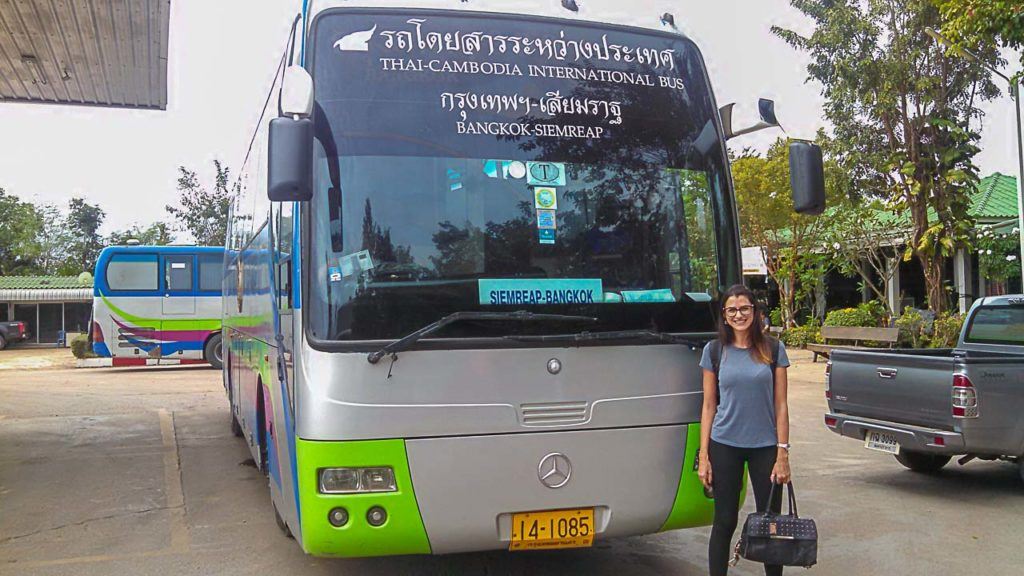
We are so used to see people around us rolling their eyes at us terrified when we speak about traveling in Thailand by bus, that it does not surprise us anymore. ‘A 12 hours on a bus to Bangkok to Chiang Mai ? Oh my, I’d rather fly!’
But wait, let’s see if flying is really the best way to travel in Thailand this case. You are most likely to spend about one to two hours getting to Don Mueang airport from let’s say, Khao San Road or Silom. You need to arrive at least one hour before your flight; the flying time to Chiang Mai will be about 90 minutes; then throw in the waiting time at the airport to retrieve your luggage and the time to get from the airport to your guesthouse.
Ok, in Chiang Mai the airport is conveniently located centrally but it is not always the case. Anyway, it brings your travel time to about 5 hours, but most probably these are daytime hours. Why lose them if you can board an overnight bus from Bangkok to Chiang Mai, sleep all night through and arrive at your destination early in the morning?
Yeah, we know that not all of you guys are able to sleep on the bus, yet there are definitely huge pros in choosing a bus for almost every traveler. Not yet convinced? So here are some more reasons to make you reconsider your attitude towards bus travel in Thailand and tips on how to travel to Thailand by bus.
Why travel around Thailand by bus?
1st > it saves you precious daytime of your travel.
This is of crucial importance if you are pressed for time – have a limited number of days for vacation or just wanna make a quick weekend getaway. Wherever you fly within Thailand be ready to spend half a day. If you opt for a night bus in Thailand, you have the whole day all for yourself.
2nd > Direct bus routes to many destinations in Thailand
There is an extremely wide choice of bus routes in Thailand departing from Bangkok. Wherever you go North, Isan or South, you are most likely to find a direct bus even to some of the most ‘out-of-the-beaten-track’ destinations. We are serious: there is not a single province in Thailand where you cannot get by a direct bus ride from Bangkok. If you are traveling from other cities and towns, the route map can be limited, but it will for sure feature the major provincial centers in the neighboring provinces.
3rd > A huge choice of destinations to travel by bus in Thailand
It is undeniable and logical that the network of bus routes in Thailand is much wider than the routes covered by flights. Only the major cities and towns have airports while even every in-the-middle-of-nowhere village has a bus station or at least a bus stand.
In fact, even when traveling to the islands in Thailand , you will probably need to combine a bus trip with ferry or boat.
4th > It is budget-friendly and the cheapest way to travel in Thailand
Well, if you choose to travel in Thailand only by a VIP24 bus, then a bus ticket can cost you as much as an air ticket. But even express class buses in Thailand are relatively comfortable, and a bus from Bangkok to Chiang Mai, or a bus from Bangkok to Phuket , by an express service, can cost you THB 400-450 [about USD12], luggage and a meal included. If you are a budget-conscious traveler, travel in Thailand on a night bus will allow you to save a couple of bucks which otherwise would have been spent on accommodation.
Read: How much does it cost to travel in Thailand?
Traveling by bus in Thailand: what to expect
Planning to travel in Thailand by bus or overnight bus? Do you want a hassle-free experience? So check out our quick guide on how to travel around Thailand by bus and have fun!
Bus terminals and bus stations in Thailand
Any big town in Thailand has at least one bus station serving buses of different bus operators heading to and arriving from various destinations throughout the country. This is how a typical bus station in Thailand looks like.

When traveling ffrom Thailand to Laos, make sure to check which border your bus will cross as not all entering points accept the Laos eVisa (Laos oline tourst visa)

In most cases, there are two bus stations in provincial centers or big towns. The bigger and normally the newer one is called Bo-Ko-So, or Terminal 2. Usually, it is located quite out of the center, between 3 and 10 km, and sits on a highway or major national route to make it convenient for any passing by bus to detour. It is a long-haul bus station. An example of a big Bo-Ko-So is the Arcade bus station in Chiang Mai from where you can get a bus to almost anywhere, from Nong Khai in the northeast to Krabi in the south.

A smaller and usually the older bus station is often called ‘Terminal 1’, or ‘In-city bus station’ and situated in the center of the town or city. It may still serve interprovincial routes and almost always can offer direct buses to Bangkok, but its main fleet travels to destinations within the province or in some neighboring provinces.
If you travel by a long haul bus in Thailand you will probably be dropped off at a Bo-Ko-So from where you will need to organize an onward transport to the city center. Note that some long-haul buses do however stop to the ‘old’, or in-city bus station, so check this out before buying the ticket. If not, in many cases there is a reliable songthaew link between the two bus terminals with a one-way ride priced between THB 10 and THB 40 depending on the local price policy. E.g. in Phitsanulok you will pay THB 40 while in Ubon Ratchathani (4) which boasts an incredibly convenient public songthaew system, it is a mere THB 10.
Another option is to download the GrabTaxi App and ask for a taxi from the station to your accommodation. GrabTaxi works like Uber but you pay the ride directly to the driver. It’s super easy to use, fast and safe. Uber is not allowed in Thailand, but you can find GrabTaxis in almost every town.
What you can find at a bus station in Thailand
Any big bus terminal or bus station in Thailand normally have:
– Toilets (usually you have to pay THB 3-5, but there free toilets at some bus stations, too)
– Waiting area, sometimes with hard seats or wooden benches
– Food stalls with snacks and beverages or convenience stores like 7/11
– Food – either in the form of local low-key street restaurants or food courts at larger bus terminals
– Timetables with a list of routes served and companies operating these routes.

Information in your Thai bus ticket
Your ticket will normally contain:
– The name of the company operating the route
– From-to information with the names of the bus stations indicated
– Bus number – look for the large numbers on the side of each coach. This information is very important because on bigger bus terminals like Morchit in Bangkok you may find several buses of the same company departing at more or less the same time from the same platform over the same route. Ugh…
– Seat number
– Platform number – if it is not indicated, you have to head to the platform which serves buses heading to your destination.
– Some tickets may contain a special meal coupon, do not throw it away. In certain cases, the meal coupon will be given to you by the coach attendant in exchange for your ticket. Use it to pay for your meal at a long stop that it will be announced during the journey.
Food during your bus trip in Thailand
Oh well, we are in Thailand and food is crucial here. So no long bus journey can exist without a meal, either served on board or in a cafe en route. It is forbidden to drink beer or any other alcoholic drinks inside buses in Thailand and in theory, it is equally prohibited to eat too smelly food. The latter requirement though is never taken seriously. After each pit stop at a gas station, the bus will be filled with a pungent aroma of Lays chips, Khao Pat or similar delicacies bought by hungry passengers in a 7/Eleven.
As a rule, long-haul buses in Thailand make at least two or even three bathrooms and meals stops, one of which lasts about 20 minutes to allow passengers to have a coupon paid meal at a food court. Often such stop happens in the middle of the night, but who cares?
Some bus companies instead of making a long meal stop serve lunch boxes on board. These lunch boxes will contain some rice and curry complemented by a soft drink, often sweet milk or juice. Either way, you hardly have chances to remain hungry traveling by bus in Thailand!
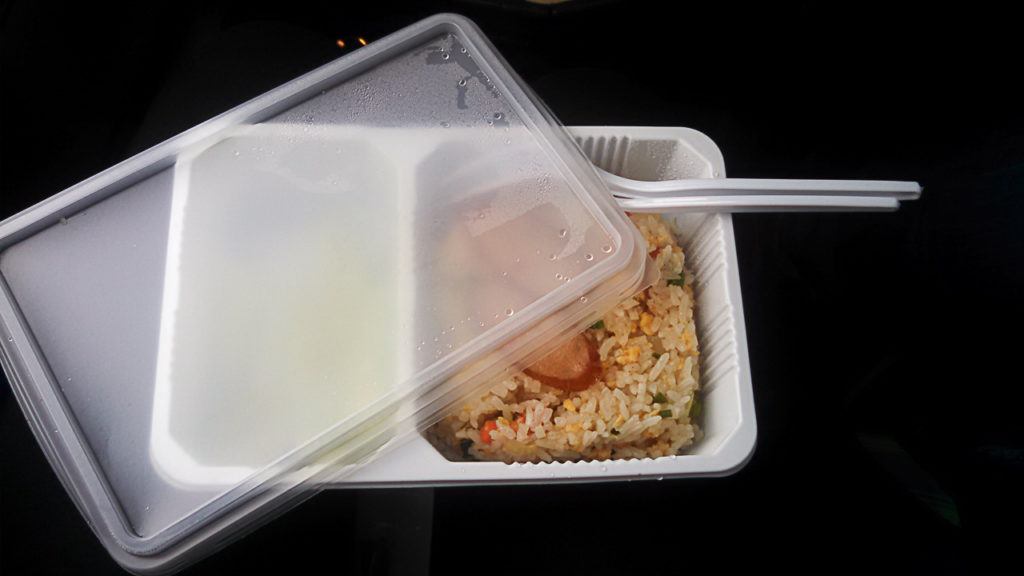
Bus schedules in Thailand
Good news: in the overwhelming majority of cases buses in Thailand depart exactly as stated in the timetable and arrive at their final destination in time or even ahead of schedule. The only exception is holiday time: do not expect your bus to stick to the usual schedule if you travel during New Year or Songkran. Multiple-hour delays are common during these periods thanks to countrywide exodus from big cities to holiday destinations and home sweet home’s.
One of the most frequently asked questions is where to find the timetable for buses in Thailand. The most obvious way is to check at the bus station – though it is definitely not the most convenient one! If you know the name of the bus company you want to travel with – which is unlikely, but if – then you can check their website if they have one. The problem here is that many bus companies either do not have a website, or have only in Thai language, or do not support online booking.
One of the easiest ways is to check the timetables and the prices of buses in Thailand on 12Go Asia . They sell tickets of different bus operators in Thailand so you will be able to compare prices, reviews, and choose the most suitable journey. On the 12Go Asia website, you can also buy tickets to travel in Cambodia, Vietnam, Myanmar, Malaysia, India, China and Sri Land.
Are you planning to travel in Thailand by bus or train? Find all the routes, prices and book your tickets here on 12Go.
How much does it cost to travel by bus in Thailand?
The price of a bus ticket in Thailand depends on the length of the route and the class of the coach. The Thai government sets prices for a 1 km ride depending on the price of fuel. Commercial companies charge extra for higher bus classes, VIP or VIP24.
Types of buses in Thailand
Buses in Thailand can be divided into several groups: public buses plying routes within cities and towns [we won’t be talking about them here]; local buses serving individual destinations within one province or neighboring provinces; and interprovincial, or long-haul buses.
Different companies use different names for buses of more or less the same category. E.g. a big Thai bus operator, Nakhon Chai Air uses ‘metal’ names: Platinum, Gold, Silver, Bronze. The majority of operators offer Express, VIP and VIP24 buses or 3 rd , 2 nd and 1 st class buses. Note that there are no sleeper buses in Thailand.

All long haul buses in Thailand have:
– Air-conditioning
– Onboard toilet
– Soft reclining seats
– Tickets include a snack, a soft drink and often a meal
– During night rides fleece blankets are distributed.
How to tell a VIP24 from an Express class bus in Thailand?
In Thailand, VIP24 bus [1 st class, platinum class, etc], as the name suggests, has only 24 seats organized 3 per row instead of the usual four. Seats are wider than standard bus seats and there is more legroom. Sometimes each seat is equipped with an individual entertainment system.
A VIP bus in Thailand [1 or 2 class, gold or silver, etc] is a 32-seat coach, still very comfortable and often featuring built-in massage seats.
Express bus [economy, bronze, etc.] class buses contain from 40 to 56 seats. Western travelers sometimes complain that the seats are too narrow and there is not enough legroom. Well, you get what you pay for, and these buses are still quite a decent option. The most important thing to note here is that they normally call to all the bus stations and pick up passengers en route thus traveling at a much slower pace than VIPs.
Though there are a lot of daily bus trips to many destinations from Bangkok and other cities and towns in Thailand, we do recommend booking bus tickets in advance. Normally, a couple of days before your planned date of departure, if you are not going to travel during peak holiday periods [Christmas, New Year, Chinese New Year, Songkran…]. If you are planning a bus trip from/to Bangkok in high season or if you want a seat on a VIP24 bus, then booking in advance is a must.
Local buses in Thailand
If you are looking for some rough bus experience in Thailand, try one of the local buses. They can come literally in any form, there are buses with soft and hard seats, buses with AC or with ceiling fans, worn-out cramped buses or cute and relatively new ones.
Don’t forget to buy your Travel Insurance! We use World Nomads and SafetyWing . Just click on the name of the company and book your insurance now. If you need more information, read our Travel Insurance Guide here .
These buses connect destinations within a 4-5-hour bus ride. They take on board everyone who wants to go, it means that often there are more passengers than seats. There are passengers transporting hens and roosters, carrying oversized luggage, but this is part of the fun! A good thing, in Thailand you can’t smoke inside the bus.
Such buses are often the only means of public transport to get to certain far-flung destinations. E.g. Sangkhlaburi in Kanchanaburi province is a good example. They travel slow but sometimes follow extremely scenic routes, and they are cheap. No need to buy tickets in advance, just show up at the bus station and explore Thailand by bus.
Where and how to buy bus tickets in Thailand?
To save time and energy we buy our bus tickets in Thailand on 12Go Asia website . They offer a great number of Thai bus operators and also offer train, plane and ferry tickets wish you consider other ways of transportation in Thailand. On the website you can also buy the famous joint-ticket , one ticket that combines different means of transportation, for example, Bangkok to Phi Phi Island will be a joint-ticket including bus + van + ferry.
Yet, of course, there are other options to buy bus tickets in Thailand:
- At the bus station immediately before your trip [you will be running a risk of no seats left, though]
- At the bus station in advance [the cheapest option but you naturally will need to travel to the bus station, in some case at the Bo-Ko-So station that’s outside town]
- Through Thai language aggregator websites. There is a number of such websites like thairoute and some of them are slowly adding English to their interface. You can pay your bus ticket online or through 7/Eleven.
- If you need a minibus ticket plying the route from/to a tourist location then many guesthouses either operate their own transport or resell such tickets. As a rule, the price will be the same if you buy directly from the minibus company.
Most popular bus routes in Thailand [with price]
And to round our guide about how to travel in Thailand by bus, here is a list of most popular van/minibus and bus routes in Thailand with prices.
Thailand by bus:
- Bangkok to Chiang Mai by bus [THB 500-1100]
- Bangkok to Phuket by bus [THB 650-1100]
- Bangkok to Koh Samui by bus – Suratthani, Donsak [THB 500-900]
- Bangkok to Pattaya by bus [THB 150-250]
- Bangkok to Hua Hin by bus [THB 150-300]
- Bangkok to Nong Khai by bus [THB 500-1000]
- Bangkok to Krabi by bus [TBH 600-1200]
Van/Minibus routes in Thailand:
- Minibus from Chiang Mai to Pai to Mae Hong Son [Van travel classics from THB 200 ]
- Minibus from Bangkok to Ayutthaya [from THB 90]
- Minibus from Bangkok to Kanchanaburi [from THB 250]
- Minibus from Bangkok to Phetchaburi, to Cha Am, to Hua Hin, Pranburi, Prachuap Khiri Khan [from THB 200]
I’m sure now you have all the information you need to travel in Thailand. Book your bus tickets through Thailand and enjoy the ride!
Click here for Thailand travel tips and destination guides.
Love this post? Pin it for later!
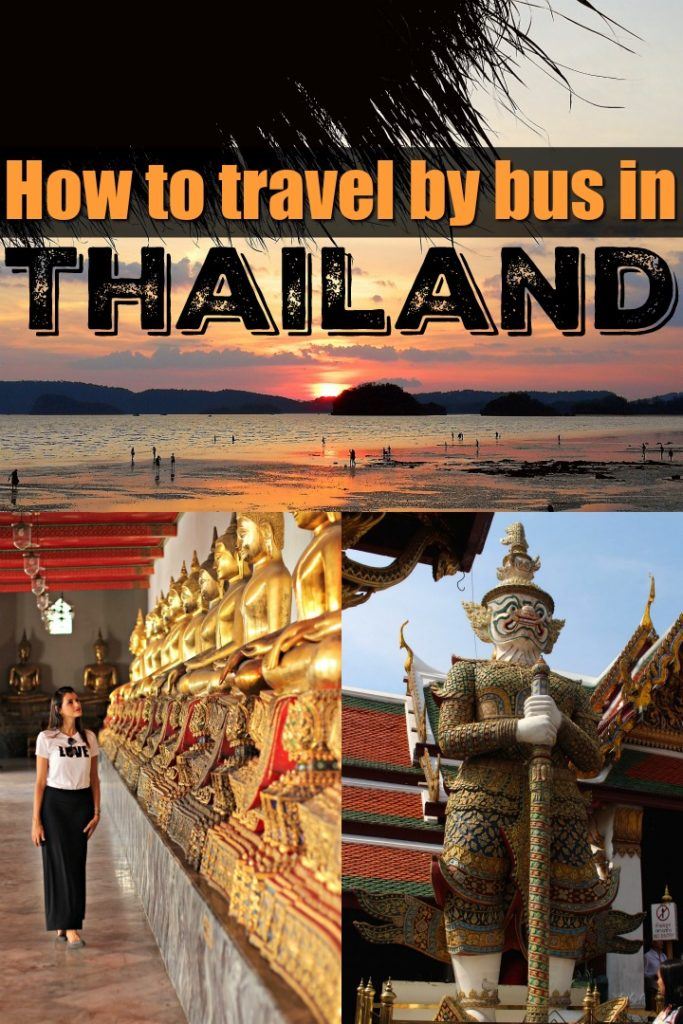
6 thoughts on “How to travel in Thailand by bus – all you need to know”
I enjoyed reading your article about buses in Thailand. It was very informative. I didn’t know that there were different kinds of buses available. I didn’t know that they served meals too and that there were VIP buses with entertainment units.
Happy to help Carlyn! In some buses we got 5 stars service 🙂
Well done to the author. Love the article.
Really helpful article, thank you! Did you find that it was harder to travel on any particular day (eg Sundays) or that any particular days were busier than others? Thank you!
It all depends on the season and the destination. Places like Bangkok, Chiang Mai, e other touristic destinations have buses (trains and ferries) every day, and the number of trips increases during the high season. If you are planning to travel to lesser-known destinations, you should plan at least a week or five days in advance to ensure there will be a bus and seats available. Cheers!
Leave a Comment Cancel reply
Save my name, email, and website in this browser for the next time I comment.
How to Travel by Bus in Thailand: The Complete Guide
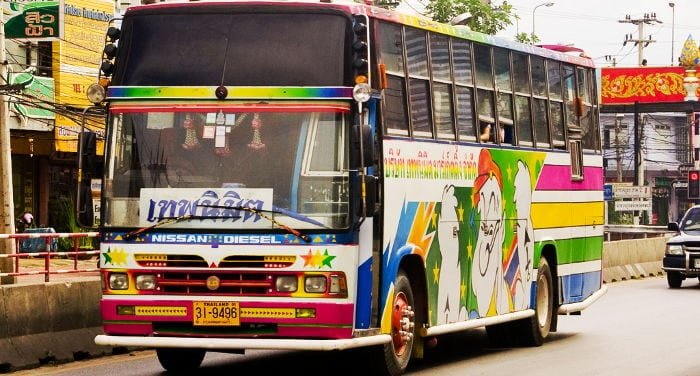
Travel by Bus in Thailand – Index
Why travel by bus the advantages, the disadvantages of traveling by bus in thailand, minivan: a variation on the bus, bus or train, bus stations, traveling by bus within cities, types of buses, a few final suggestions, frequently asked questions.
Traveling by bus in Thailand is very convenient, both in terms of savings and comfort. Bangkok represents the country’s major transportation center ; in fact, from the capital it is possible to reach practically every city in Thailand, and even cities in neighboring countries, such as Myanmar , Laos, Cambodia, and even Malaysia.
Besides cheap prices and excellent connections, traveling by bus in Thailand is a relatively comfortable experience. The vehicles used by various transportation companies are almost all new and equipped with every comfort.
Their are daily buses that offer services such as television, some snacks, and a few even have Wifi connections. Night buses will welcome you with reclining seats, covers and the classic midnight snack!
Buying tickets is simple and intuitive. You can show up in person at various bus stations, or buy them online and show your ticket directly from your smartphone. There are many websites where you can buy tickets and are often run by specific companies.
On the site 12go.asia , after entering your departure and destination cities, you’ll find an exhaustive list of all companies that run that route. The advantage of this site is that it shows the prices for each company, so you can also do a search on the basis of the cheapest ticket.
One of the benefits of choosing buses as the principal means of transport for tourists and locals alike, is the extremely low cost of tickets. Routes of hundreds of kilometers, as would be the case between the capital and cities in the north of the country, cost no more than 20 USD per person, including luggage!
Prices are also low for short to mid-range range. If you want to spend a weekend at the beach, or simply go to another city that isn’t Bangkok, for just 90 THB you can take a bus from the East Station in Bangkok and get to Pattaya in 2 hours. If you’d rather relax on paradise-like white sand beaches like those on Koh Samet then your 3 hour trip will cost about 150 THB.
When traveling on a continent like Asia, one of the most fascinating things for a tourist is definitely seeing the locals way of life. Traveling by bus you’ll have the chance to meet local people, get to know the customs and even admire the splendid landscapes that characterize the country.
Obviously there’s no disadvantage when it comes to buying tickets online, but there are disadvantages in having to communicate with the Thai people in a foreign language like English.
Despite the fact that in Thailand English is taught in practically (almost!) all schools , the Thai population still remains in the lowest classification when it comes to understanding English.
So if you decide to buy a bus ticket in person, or ask specific questions of the bus staff, arm yourself with lots of patience and a sense of interpretation!
Generally in bus stations, both drivers and hostesses are able to provide basic information in the English language. A great idea is to always write the name of your destination in Thai. Obviously this won’t be a problem if your objective is a city like Phuket , or Chiang Mai , but it would be useful for lesser known destinations less visited by tourists.
Another disadvantage of traveling by bus, compared to other forms of transport like by air for example, is travel times. Even though the country’s roads are for the most part suitable for high speed driving, the Kingdom of Thailand extends for many kilometers, making itineraries like Bangkok–Phuket or Bangkok–Chiang Mai interminable trips of over 12 hours.
One version of buses in Thailand,are the minivans. These little vans have 12–15 places, plus a small trunk where you can put your luggage. Unlike buses which are larger, minivans are smaller; this offers two advantages and two disadvantages.
The first is in the fact that being smaller, there’s less spaces, and consequently less comfort. In addition if you’re traveling with particularly large bags, you’ll be asked to pay for a supplementary ticket to be able to place your bag on a seat. So it’s not the best transport option if you have to travel far or with large luggage.
An advantage of the minivans (which is also a disadvantage!) is that being smaller than buses they can travel faster. Sadly this characteristic combined with the Thai style of driving makes this form of transport more like little unstable missiles.
In recent years, many people have lost their lives on the country’s highways because they decided to travel by minivan. Drivers are often at the wheel for over 12 hours, going at speeds of 140 km (and more!) on the highway, often gambling on improbable maneuvers. The chance of getting into an accident with, or because of, this type of transport, is quite high.
In Thailand the bus is generally the preferred means of transport over the train, simply because they offer more connections, and it’s (almost always!) cheaper. Train rides though are not to be undervalued either.
An essential difference between the two means of transport is in the fact that if you decide to travel by train you can choose the class that you prefer. On night trains that leave from the central station in Bangkok arriving at Chiang Mai for example, you can choose between third, second, or even the comfort of first class.
By train moreover, you can admire the country’s beauty, passing through areas that the bus doesn’t travel simply because there are natural areas where there are no paved roads.
The largest bus stations, for obvious reasons are found in the capital. Nevertheless, besides Bangkok other cities with high numbers of tourists now have stations of respectable dimensions.
In Pattaya for example, just a few years ago the new bus station was inaugurated just 3 kilometers from the center.
All stations offer more or less the same services: ticket office, waiting room, restrooms, little shops where you can buy drinks and snacks, a timetable with departure times, and an area reserved for taxis.
Often the stations, located outside the city center and far from other means of transport, arrange for a taxi service to bring you to your hotel . Make sure that the meter is turned on when you get into the car, otherwise you might be cheated.
Sadly in cities like Phuket finding a taxi driver that works “legally” is practically impossible. In this case I recommend that you negotiate the price before getting in the car. Bear in mind that prices start at a minimum of 500 THB a ride.
In stations like Pattaya , they offer a local taxi service, where the price of the ticket is fixed at 100 THB a person.
In Bangkok the taxi service functions well, like all the other transport networks in the city. Once you get to one of the main bus stations, such as Ekkamai (East) and Morchit (North), you can directly take the Sky Train in the case of Ekkamai, or a free bus or taxi in the case of Morchit.
Up til now we’ve only spoken about mid to long range buses, or those connecting cities. In this section of the article I’ll explain how to get around a city by using local buses.
The most developed city in urban terms is Bangkok, which offers every type of bus imaginable or possible.
The main hub, when it comes to transport, is Victory Monument, a large roundabout with an imposing monument dedicated to warriors from the Second World War.
Up until last year it was actually from Victory Monument that all minivans departed for various destinations in Thailand and that’s not all. Starting from last winter however the Thai government decided to “clean up” the area, moving the minivans to stations to the east and north of the city.
Taking a bus from Victory Monument can be a truly difficult task. All buses in the city pass through this roundabout more or less frequently.
Let’s start right off by saying that there are no timetables, nor departure times, and not many ticket offices. Once you decide where you want to go, head to Victory Monument and, if you follow a little advice, you’ll see that you can manage to handle it without any particular problems.
Once you decide on your destination, you need to find out what number bus you need to take. For this operation you need to check with the Thai transportation site , which will tell you exactly which number/s will work for you.
Once you have your number, you need to know which direction your bus will take. Arriving at the Victory Monument BTS, more specifically walking on the elevated overpass, you’ll arrive at a fork: left or right?
If you want to go to the north of the city, go down the stairs on the left and you’ll find bays with all the buses going north or west. If instead your intention is to go south or east, then take the stairs on the right.
Here’s a practical example to show you how important it is to know the number and direction of your bus. Bus number 29 goes to both the north and south of the city. From the counters located on the left of the roundabout, bus 29 goes towards the province of Pathum Thani, passing by JJ Market. On the right of the roundabout, bus number 29 heads to China Town.
Once you have your direction and bus number, the trip can begin! When you see the bus you want pulling up, wave your hand to let the driver know that you want to get on the bus and he’ll let you on.
Payment for tickets takes place right on the bus without automatic ticket machines. The only way to pay is to give your money directly to the conductor who will pass through looking for payment.
Obviously you’re not forced to leave from Victory Monument if you know which bus stop you’re interested in. Starting at Victory Monument makes things a little easier especially if you’re new to the city.
There are no timetables for the city bus lines even though the first runs start from around 5 in the morning with the last at around midnight. In the city of Bangkok there are a few bus lines to that run 24 hours a day; to learn more check with the official site of the Thai government .
There are instead specific timetables for buses traveling between one city and another. Timetables can be checked directly on the companies’ sites or at the bus stations. Even in this case, the first runs (same goes for the minivans) leave from around 5.30 with the last going deep into the night.
As I said before, there are basically two types of buses, of which can be divided into sub-categories.
The first category is buses that make rather long runs. An example are those that in 5 hours leave from Bangkok for Siam Reap in Cambodia. In this category we can also include minivans, which make shorter runs than the buses, and don’t travel by night, but still cover an important part of the country’s urban network.
The second category are the local buses, which only travel within the cities. This distinction is divided in turn into two types of buses:
- Red buses, without air conditioning, often free or at a fixed cost for all (regardless of the stop) of 6.50 THB.
- The small orange buses, without air conditioning but with fans. Even for these buses tickets have a fixed cost (7 THB), regardless of the stop.
- Blue buses, with air conditioning. The cost is the same no matter what your route or stop: 9 THB.
- Yellow buses: you’ll notice right away that they’re newer; the cost of a ticket varies between 13 THB and 21 THB, depending on your stop.
Traveling by bus in Thailand, and in southeast Asia in general, is simple and cheap. There are however a few common sense matters to always keep in mind. An example is to always keep an eye on your bags in case you decide to travel by bus at night, or when requested to leave your luggage in the cargo hold, keep your valuables, including your travel documents, with you.
The majority of buses and minivans make intermediate stops to get gas, or let people use the facilities. In any case I recommend that you bring something to eat and drink with you, since it is often at the discretion of the driver whether to stop or not.
Personally I traveled from Koh Samet to Bangkok in a minivan where the driver never stopped in over 5 hours of driving.
- Local buses
- Express buses
- VIP & VIP24 buses
- Tourist charter buses
- Combo tickets with the ferry connection
- International buses and border crossing
- Don’t participate in excessive drinking
- Don’t become angry
- Sit close to a monk (especially if you’re a girl
- Complain about noisy music or chatting
About The Author
Stefania Battaglia
Related posts.

Teaching English in Thailand: My experience in a kindergarten

Ayutthaya, the old capital of Thailand (Photo Essays)

The Damnoen Saduak floating markets near Bangkok (Photo Essays)
Leave a comment cancel reply.
Your email address will not be published. Required fields are marked *
Save my name, email, and website in this browser for the next time I comment.
Privacy Overview
Get 3 Months FREE with EXPRESS VPN
+ Best VPN For China + 30-Day Money-Back Guarantee + 24/7 Live China Customer Support + 3 Months Free on 12 Months Package
Traveling by bus in Thailand
With so many things to see and do in Thailand, many tourists who visit this Southeast Asian country plan a trip to visit different cities, temples, beaches and landscapes. But Thailand is a big country and it is not always easy to find the best way to get from one place to another. You may be surprised that traveling by bus in Thailand is the most common. Long-distance buses in Thailand are cheap, and because the network is so extensive, you can go almost anywhere with this mode of transport. Our guide to traveling by bus in Thailand tells you the details, pros and cons of traveling by bus, both in public and private services and in VIP options.
Is it safe to travel by bus in Thailand?
The truth is that traveling by bus in some Asian countries can be a bit scary when you encounter a reckless driver driving on narrow and bumpy roads. Fortunately, buses in Thailand have a very good reputation. Local public bus services often have buses that are a bit old and not very comfortable, making them an undesirable option for long journeys. However, there are private companies that have a fleet of modern buses that are in very good condition and are a safe medium for long distance travel. The seats are comfortable, the buses are air-conditioned and many have a bathroom on board. In general, drivers have rather cautious speeds, around 60-70 km/h, depending on the type of road and its condition.
Where to buy tickets to travel by bus in Thailand
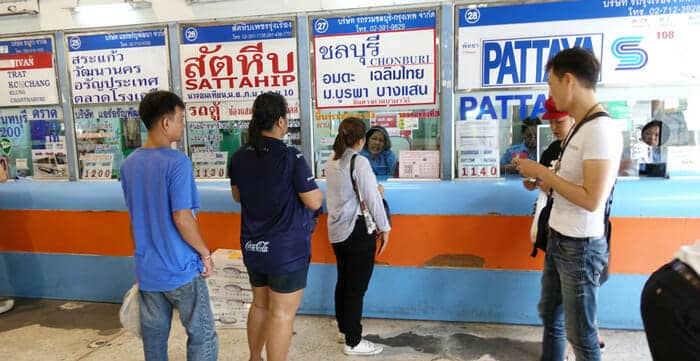
There are several options to buy your bus tickets. The most obvious place is at the bus station itself, but you can also opt for a travel agency in the city where you are staying or an online tour operator such as 12Go. While it’s usually easy to buy tickets at the station, it can be a bit tricky if you don’t know exactly what types of tickets are available and which ones you want to buy. Travel agents can eliminate that step, but you’ll likely pay more for the ticket because the agent charges a commission. In addition, there are unscrupulous travel agencies operating in places like Khao San Road in Bangkok, something to keep in mind when buying your tickets.
For this reason, we recommend using a reliable travel website and 12Go has a very good reputation. Buying online is easy because you can see all available options at once, read the opinions of other travelers and make the best decision. Plus, you get the support of a major company in case a problem arises or you need to make a change.
Public bus service in Thailand

As we mentioned earlier, there are two types of buses in Thailand: public and private. Public buses, as you know, are operated by local authorities and are designed to be affordable for everyone. You can use this type of bus to get around within a city or for short trips, but there are some services that also run between cities on the most popular routes. As they are mostly older buses that are not very comfortable and may not be in very good condition, we do not recommend using public buses to travel from one city to another in Thailand, although they are perfect for short local rides.
Private bus companies in Thailand
Private bus companies are a fantastic option for long journeys. In general, in Thailand, there are two classes of private buses, Express and VIP
Bus Express in Thailand

Although they are known as express buses, they are probably not the fastest way to get from one city to another. Yes, they are much faster than local buses, but express buses in Thailand can make several stops at different stations along the way and even pick up passengers along the way. While this makes the journey longer, it can be an advantage if you’re on the outskirts of a city or haven’t had time to buy the ticket in advance. Get on an express bus and buy your ticket on board.

The truth is that the express buses in Thailand are quite comfortable. The seats are soft and can usually recline a bit. In addition, they usually also have air conditioning and a bathroom on board. Depending on the operator, they may also provide you with water and/or snacks during the trip. These buses stop along the way so you can get off to stretch your legs or grab a bite to eat.
The main drawback is that you may not have much leg and arm room, but they are very reasonably priced and widely available, especially on the more popular routes. But keep in mind that they are also heavily used by the locals, so they usually fill up in a short time and it’s a good idea to buy tickets in advance, especially during holiday periods. Book through 12Go to ensure you make the most suitable purchase.
VIP bus in Thailand

Despite the name, VIP buses in Thailand are not only used by important people. The abbreviation VIP stands for a higher level of comfort and luxury than with other buses. Traveling with a VIP bus in Thailand is safe, fast, comfortable and, with all that in mind, affordable. Yes, the VIP buses are the most expensive in Thailand, but compared to transport prices in Western countries, they are still very good value for money.

VIP buses have only three seats per row, arranged with two seats on one side of the aisle and a single seat on the other. This allows for more arm room and a bit more legroom as they have a few rows fewer seats than the express. The seats are soft and recline quite a bit so if you are traveling at night you can get some sleep.
VIP buses in Thailand usually provide water and snacks, as well as bathrooms and televisions, although the channels are only in Thai. The price of the ticket usually includes a voucher to buy food during a stop in a service area, so that you can have dinner or buy something to eat on the bus.
Traveling with a VIP bus in Thailand has a number of disadvantages. One is that while air conditioning is a must, it is usually so strong it can get very cold, so bring a jacket or blanket to keep you warm. Another disadvantage is that they do not stop as long as the express buses. This can also be an advantage, but if you like to get up and stretch often, a VIP bus may not be the best option for you. Although by making few stops you arrive at your destination earlier.
Green Bus in Thailand

Green Bus is worth mentioning as they are a great bus company for anyone traveling in Northern Thailand, although they also run routes throughout the rest of the country, east to west and even south to Phuket. But the main station is Chiang Mai, and almost all of its services are provided in that city. The route from Chiang Mai to Chiang Rai is the most popular. Nearly 20 buses a day run this route, making Green Bus a fantastic option if you plan to travel from Chiang Mai.

On the one hand, Green Bus runs with new and very comfortable buses that even exceed other popular bus companies. Therefore, if you do not mind spending more to travel more comfortably, this is the best option. In any case, there have also been complaints about old buses that are not in such a good condition and that usually run certain routes (express buses),
and these do not offer those levels of comfort. If you are concerned about the services offered by the bus you are traveling on, make your purchase through 12Go, where you can easily compare the prices and services of each bus.
In short, traveling by bus in Thailand is a fantastic way to visit this beautiful country. You see a lot more from the bus window than from an airplane, and buses are considerably cheaper than flights. With great flexibility of routes and destinations to travel to, buses are the most practical option for getting around Thailand. It is an economical, comfortable and safe option, and the only drawback they offer is the length of the journeys.

Transportation in Thailand – Ultimate Travel Guide [2024]
- Last Updated: January 12, 2023
A detailed and straightforward guide to help travellers understand transportation in Thailand.
One of the hardest parts of travelling is often the time spent in transit on the road.
When you’re in a destination enjoying the land and the culture, everything is exciting and new. But getting from place to place can feel overwhelming, confusing, or even stressful at times.
However, with a bit of research and preparation, you can take on public transport in any country and be able to travel around with ease.
Getting around Thailand is very easy, straightforward, and often stress-free.
Most travellers tend to follow similar paths throughout the country, so the planes, trains, buses, and ferries between popular cities are developed and consistent.
Many people speak English in touristy areas as well, so it is easy to ask for help if you need it.
But transportation in Thailand is often hassle-free, and it is extremely affordable.
You can find long-haul flights into Bangkok , take overnight buses cross-country, and zip around a city in a tuk-tuk, all for super cheap prices.
So don’t let the idea of deciphering a foreign transportation network intimidate you!
READ MORE: Plan your trip to Thailand with our awesome Thailand Travel Guide !
Table of Contents
Air Travel to Thailand
Overland travel, entry requirements, motorcycle taxis, metro and public bus, research the price of a journey, keep your belongings safe, google maps , transportation in thailand.
The Thais have made it very easy for tourists to travel around their country, and this guide will hopefully clear up any confusion about the best ways to get around.
You will learn about travel to and from Thailand, travel between different areas of Thailand, intra-city urban transportation, and some useful travel tips.
Travelling to Thailand
Thailand is becoming one of the world’s most popular tourist destinations, so it is very well-connected to the rest of the world.
Whether you are flying to Thailand from the other side of the world, or just crossing the border overland from a neighbouring Southeast Asian country, you shouldn’t have any problems entering this vibrant country.
Flying into Thailand is straightforward and often affordable.
There are so many different international airlines that connect Thailand with cities all over the globe, and if you search in the right places you can find flights that won’t break the bank.
Using a search engine like Skyscanner or Google Flights is helpful because you can select an entire month as your departure date and see a calendar that has the prices shown for every day.
It is also helpful to shop for prices using an incognito window that does not store data from your previous searches. Airfares are notorious for their variety due to cached information.
This allows you to select the cheapest departure date and save plenty of money.
If you choose to travel to Thailand between May and October, you will save even more money on flights because prices tend to drop during the offseason.
Try to pack as lightly as possible for your flight to Thailand. When you only have carry-on bags, you will save money on baggage fees and have a more convenient time travelling.
Most long-haul international flights will fly into Bangkok.
There are two major airports in Bangkok: Suvarnabhumi Airport (BKK) and Don Mueang Airport (DMK. Just make sure you clarify which airport is on your ticket so you don’t get confused.
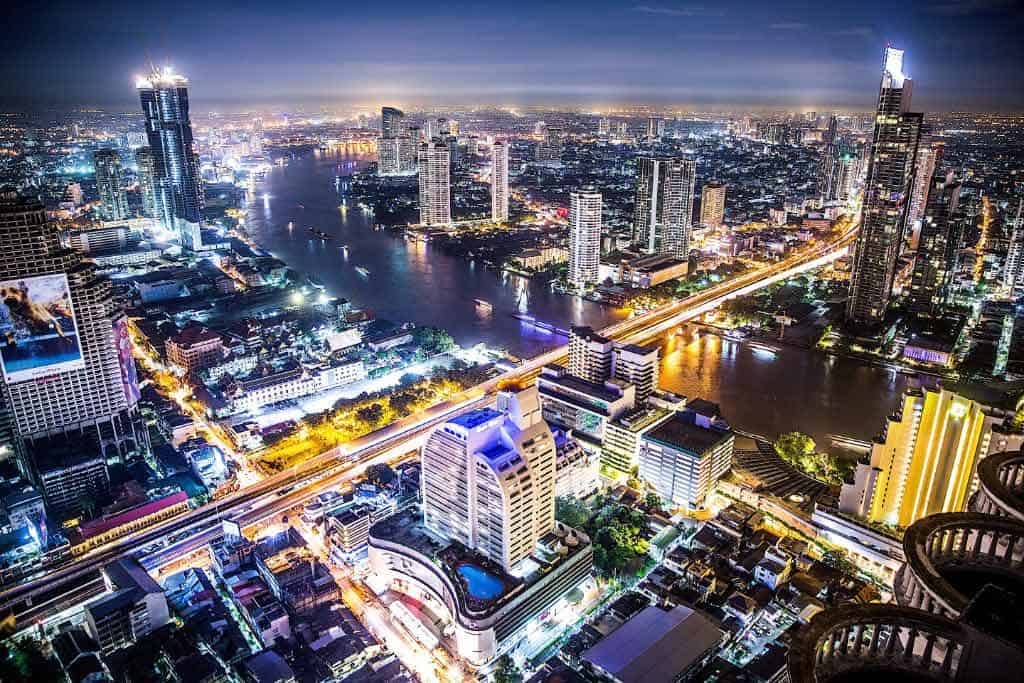
There are multiple border crossings between Thailand and its four neighbouring countries, Myanmar, Laos, Cambodia, and Malaysia.
If you are entering Thailand by train or bus from any of these countries, the border crossing process isn’t much different from the border crossing at the airport.
Your passport will be stamped and you’ll be granted a 30-day visa on arrival.
In the next section, “Entry Requirements,” you’ll learn more about whether you need to obtain a visa in advance before heading to Thailand.
If you are entering Thailand with a car or motorbike that is yours or is a rental, you’ll have to provide your international driver’s license, vehicle registration, and vehicle insurance to the officers at the border.
Border crossings can be quick and easy, or they can be very long if there happens to be a lot of traffic.
Plan on having a good amount of snacks, water, and local currency just in case the border crossing takes longer than expected.
Many visitors to Thailand will need a visa, for which you can apply online before entering the country, or obtain at the airport upon arrival.
A Thailand tourist visa costs around 30 USD – 50 USD, and of course, you have to have a valid passport for the duration of your stay.
There are several countries that have made visa-exempt agreements with Thailand, so citizens of these countries do not need a visa.
If your nationality is on this visa-exempt list, you can enter Thailand for free but you cannot stay longer than 30 days.
Check the Thai embassy website to see if your nationality is on the visa-exempt list or not.
Getting Around Thailand
Once you arrive in Thailand, travelling within the country is quite easy.
It has become such a popular tourist destination that there is a well-developed public transport network to get you where you need to go.
Long Distance Transportation
For travelling long distance within Thailand, you have a few different options. Whether it be a flight, ferry, or tuk tuk ride, there are plenty of ways to travel a long distance.
Domestic flights are actually one of the quickest and easiest ways to get around Thailand.
If you are heading straight from Bangkok up to Chiang Mai in the north or heading down to any of the islands, there is quite a bit of distance to cover.
Rather than sitting on a bus or train for 10 or more hours, it is worth just catching a 1-hour flight to the other side of the country.
In cities like Chiang Mai and Bangkok, the airports are only 20-30 minutes away from the city centre, and you only need to arrive about one hour before domestic flights.
So flying often turns out to be the most convenient way to travel in Thailand.
Thailand has plenty of budget airlines where you can get easy domestic flights for as cheap as $40 USD.
Thai Lion Air, Air Asia, Bangkok Airways, VietJet, Nok Air, Thai Airways and Thai Smile are just a few of the reputable and affordable airlines you can fly around Thailand. Most flights pass between the bigger cities of Bangkok and Chiang Mai.
Keep in mind these low-cost carriers are so cheap because they provide the bare minimum. You’ll have to pay for food, drinks, and any checked baggage.
Air travel is best for travellers who want to see a lot of the country in a small amount of time.
READ MORE: Plan the perfect Thailand itinerary with our comprehensive travel guide!
For those who have a longer time frame to travel in Thailand, the train can be appealing because it allows you to see more of the countryside.
Trains are not much more expensive than buses and they are much more comfortable. But the tickets tend to sell out so try to book yours at least a few days in advance.
We recommend using 12Go.asia to buy your train tickets in Thailand.
You can get first, second, or third-class tickets, and you’ll get to enjoy the scenery along the way.
The overnight train from Bangkok to Chiang Mai is an experience in itself, with bumpy old tracks and stunning scenery.
Though trains tend to be very punctual in many countries, they are often late or the journey takes longer than expected in Thailand.
Train travel is best for travellers with a bit of time to spare, and who would prefer a more spacious and relaxed journey.

Buses are cheaper than trains or planes, but they take much longer.
The most common long-distance routes leave from Bangkok and head either north to Chiang Mai or south to Krabi, and these journeys usually cost between 500 and 1,500 Baht.
The most reputable bus companies are the ones owned by the government-subsidized transport company known as BKS.
Overnight buses are convenient for long journeys, such as the 12-hour ride from Bangkok to Chiang Mai.
Buses are the best option for travellers looking to save the most money.
But don’t put any valuables in your check-in bags (it’s not unheard of to show up at your destination and find all the bags have been completely cleaned out).
Also, keep your money locked away in money belts or in zipper pockets, and sleep with your day backpack on your lap and padlock it.
Just like with trains, 12Go.asia is your best bet for finding reliable bus routes in Thailand.
If you are visiting any of the Thai islands, you’ll need to catch a ferry. (Unless you are only visiting one large island with its own airport, like Phuket or Koh Samui )
It is pretty easy to just show up to a ferry port and buy your boat ticket on the spot. And sometimes the longer journeys have snacks and drinks on board.
Ferries are a lovely way to see some ocean scenery, and they are usually quite comfortable.
Your bags are often stored at the front of the boat, sometimes wrapped in a tarpaulin (but often just piled in the open), and the staff will direct you onto the boat and where to seat.
If you get seasick, take some motion sickness medicine before you get on board.
Book these ferries ahead of time in 12Go.asia .
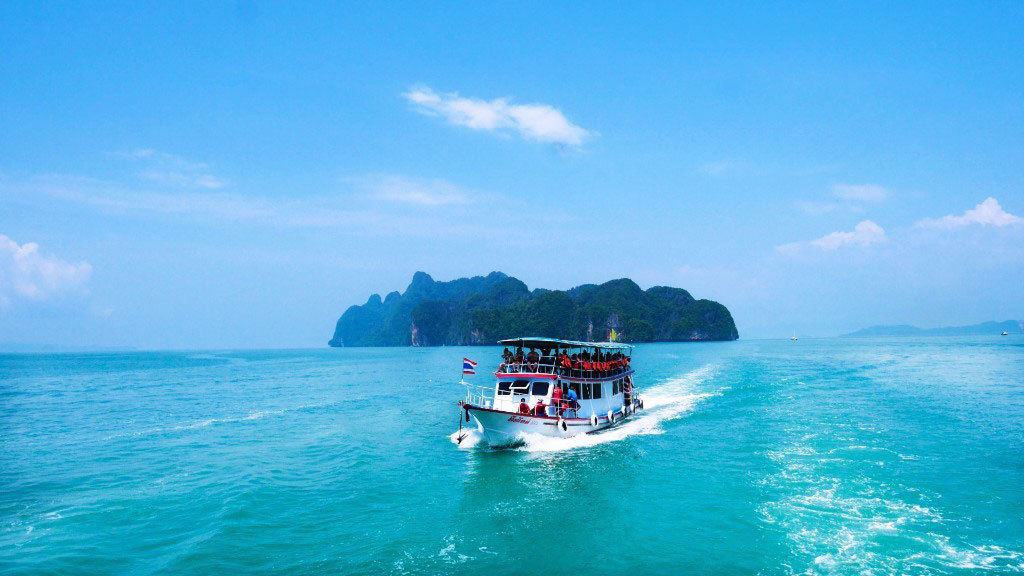
Urban Transportation
For travel within Thai cities or towns, there are plenty of public transport options.
Walking is definitely the best way to get around, as it provides exercise, costs no money, and allows you to see the city the best.
But in a big metropolis like Bangkok or Chiang Mai, or on a huge island like Phuket , you’ll need to catch some form of transport to see different places.
Taxis are the easiest and most direct form of public transport and compared to many other countries they are quite affordable.
There are more taxis available in bigger Thai cities than in rural areas, but in places like Bangkok all the taxis, fortunately, have meters so you won’t get ripped off.
Elsewhere in Thailand, taxis aren’t as common and sometimes they don’t have meters, so agree on a price beforehand to ensure you don’t get overcharged.
If there is a meter and the driver refuses to turn it on, he is most likely trying to rip you off so you should get out and find a new taxi.
Other taxi drivers will claim that the meter isn’t working, and that’s a pretty good indicator that they may try to rip you off.
Avoid these drivers unless you can negotiate a good price before you get in.
We use Grab in Thailand , which is like Uber. You know the price and you have the information of the driver and car if needed.
Our little tip with Grab is to only pay in cash. Do not put your card on file as some drivers are still taking advantage and taking tourists long ways, even the wrong way, and charging them an arm and leg for it.
Track your trip on your map, don’t be scared to speak up if they are taking you the incorrect way or long way, be firm not to pay more than agreed and report them to the company.
Most of them are fine, there is just one or two that are dodgy.
Make sure you have all your belongings on you before exiting the taxi.
READ MORE: Learn some great Thailand travel tips to make your journey more enjoyable!
For a cheaper alternative to a taxi, you can take a red pick-up truck known as a songtaew.
These trucks have two long benches in the back, so they can fit lots of people and they act as shared group taxis.
Songtaews are common transport in Thailand around touristy places, as there are lots of travellers heading to the same popular places and songtaews can easily pick everyone up and drive them together.
Sometimes you’ll have to wait a while for the truck to fill up, but once it’s full the ride is cheaper because the total cost is split between more people.
Just ask your hostel staff or other locals where a songtaew to a particular destination leaves from and they will point you in the right direction.
If the driver says they won’t take you, don’t be offended, as they are probably just not going that way. Just flag down another songthaew and ask them.
To hail a songthaew, stand on the side of the road and with the palm of your hand facing down, waving your arm calmly in an up-and-down motion.
Probably one of the most famous forms of transport in Thailand is the tuk tuk, and riding in one is quite the experience.
These mini, three-wheeled, open-air vehicles are a staple of Southeast Asia, and they are great for catching a quick ride. A tuk tuk can also be called a motorcycle taxi or motorbike taxis
A Tuk tuk is often more expensive than a taxi, so they are better used for short journeys around a city.
Because tourists love riding in tuk tuks, locals can easily overcharge them for a ride so make sure you agree on a decent price before the journey begins.
If you have lots of luggage with you, choose the spacious taxi over the cramped tuk tuk ride.
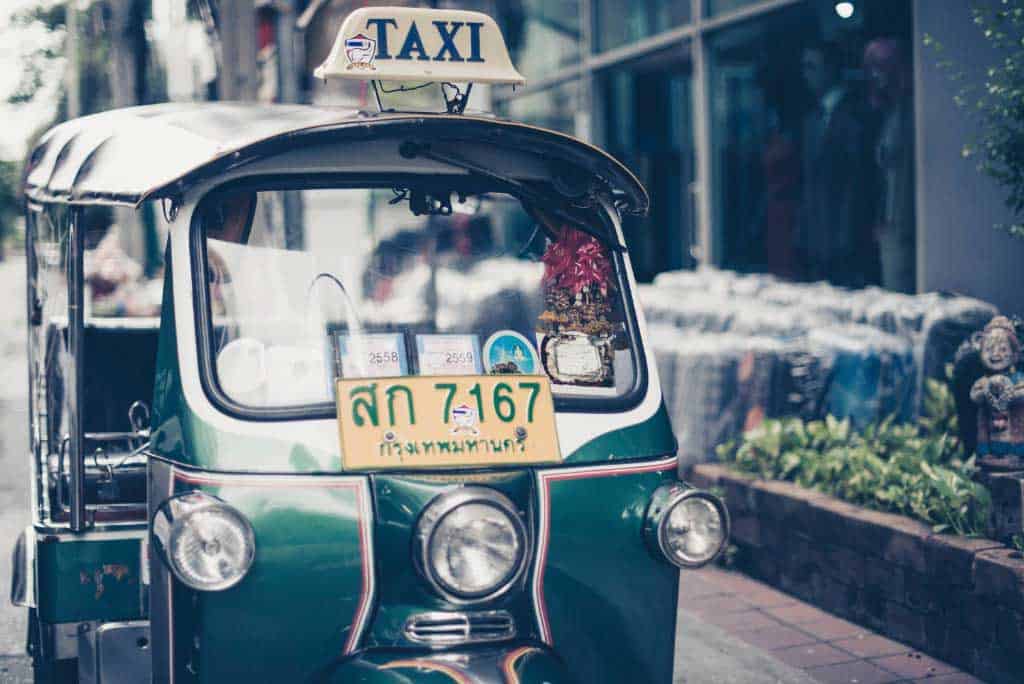
Climbing on the back of a local’s motorbike and whizzing around the city is probably the quickest form of public transport as you can cut through traffic if necessary.
Obviously, there is nowhere to store luggage and you can only fit a maximum of two people on a motorbike.
So a motorcycle taxi is only logical if you’re trying to get somewhere quickly and cheaply and you don’t have any bags.
Because of the convenience and affordability of songtaews, taxis, tuk-tuks, and motorcycle taxis, common forms of public transport like the metro and public buses aren’t that common in Thailand.
The only exception to this is Bangkok, where metro and buses are necessary due to the sheer number of people living and travelling in this massive city.
Bangkok has lots of different bus companies and usually, a journey costs less than 10 Baht.
Just ask around in your local area where and when the public bus leaves from because it isn’t a set standard.
In Bangkok, you can also take the BTS Skytrain , an overground train, or the MRT Subway , and underground metro, for travelling to different areas of the city.
The best way to get around is to rent a car and explore on your own! We recommend Rental Cars , which has the largest range of vehicles for the best value on the market.
General Tips for Transportation in Thailand
Now that you know all the options for transportation in Thailand, here are some general tips to help your journeys run as smoothly as possible.
As previously mentioned a few times, local drivers often try to overcharge tourists for taxis or tuk tuks.
The best way to avoid this is to research the price of a journey beforehand so you can negotiate with the driver and secure a fair price.
Whether you do a bit of research online, or just ask your hostel staff or local friends, have an idea of what a specific journey should cost so you don’t look clueless to the local drivers.
An even better way to avoid getting overcharged is to learn a bit of Thai. If you speak the language, locals won’t look at you as a tourist and they may charge you the local price.
Theft isn’t a huge problem in Thailand, but it isn’t unheard of.
Especially on overnight buses, trains, or any form of transport when your bags are stored separately, make sure you take the necessary precautions to secure your things.
Always have a smaller backpack, a purse or a fanny pack that you can keep on your person, and keep all your most valuable things in there including passports, electronics, and wallets.
Keep luggage locks on your bigger bags and suitcases so no one can get in and try to nick your stuff.
Just use common sense and you shouldn’t have any problems with transportation in Thailand.
READ MORE: Learn more about travel safety in Thailand .
Important Note! Before you book any international trip, we honestly recommend getting travel insurance. You never know when things will go wrong, and medical bills can add up quickly if you get sick or injure yourself overseas.
Our personal recommendation based on our own experience is World Nomads .
Apps to Consider for Travelling in Thailand
It is possible to travel Thailand the old-school way, with nothing but a paper map and the confidence to ask locals for directions.
But we are lucky to live in an age with so much useful technology that makes travelling in a foreign country much easier.
Here are a few Apps that can help you with transportation in Thailand.
Google Maps is very useful for finding your way throughout Thailand.
Most popular attractions are listed on this universal navigation platform, so all you have to do is search for your destination and Google Maps will give you the exact address and location.
This is especially helpful for traveling in more remote areas where exact street addresses aren’t as common.
For example, the island of Koh Samui has one main road that circumnavigates the island, and the smaller streets branching off this main road don’t always have names.
So many attractions on Koh Samui don’t even have real street addresses. Having Google Maps can help you actually see where the attraction is instead of just guessing.
Maps.me functions similar to Google Maps, though there are a few differences.
It is a newer and less developed App than Google Maps, so it doesn’t have as many attractions listed on it.
However, this App comes in handy for those who don’t travel with cellular data and just rely on Wifi. You can download entire area maps while you have Wifi and then the maps still function while you are offline.
So Maps.me is very helpful to have in case you get lost somewhere because you can open up your downloaded map and see exactly where you are, even if you don’t have Wifi.
Rome2Rio is an incredibly useful international website and App that compares different forms of transportation between destinations.
You can select your departure and arrival cities, select your dates, and then watch in amazement as Rome2Rio lists all the possible ways to take public transport to your destination.
With all the options laid out, you can see which method of transportation in Thailand is the fastest, the cheapest, and the most convenient.
DISCLAIMER: Some of the links in this article are affiliate links, which means if you book accommodation, tours or buy a product, we will receive a small commission at no extra cost to you. These commissions help us keep creating more free travel content to help people plan their holidays and adventures. We only recommend the best accommodations, tours and products that ourselves or our fantastic editorial team have personally experienced, and regularly review these. Thanks for your support, kind friend!
Gabby Boucher
Hi, We’re Alesha and Jarryd!

We’ve been traveling the world together since 2008, searching for the planet’s best destinations and adventures.
Love Travel?
Sign up for our free weekly newsletter for the best travel tips, ideas and deals!
We respect your privacy. Unsubscribe at any time.
READ MORE...
17 EPIC Things to Do in Pai, Thailand [2024 Guide]
The 23 Best Things to Do in Phuket
The 22 Best Things to Do in Koh Samui, Thailand
Related Posts
The 20 best things to do in koh tao, thailand (2024 guide), how to get a sak yant in chiang mai (hygienically and safely in 2024), the perfect 3 days in krabi itinerary (2024 guide), leave a comment cancel reply.
Save my name, email, and website in this browser for the next time I comment.
How to Travel Thailand by bus, train, ferry and airplane
[vc_row][vc_column][vc_raw_js]jtndjtixls0lmjbfdmvudcuymhnuaxbwzxqlmjbmb3ilmjbwaxnpdcuymcuyniuymzm5jtncvhjhdmvsjti2jtizmzklm0ilmjbwywdljtiwy29udmvyc2lvbiuymhbhz2ulmefjbiuymhlvdxilmjbodg1sjtiwcgfnzsuyqyuymgfkzcuymhrozsuymhnuaxbwzxqlmjbhbmqlmjbjywxsjtiwz3rhz19yzxbvcnrfy29udmvyc2lvbiuymhdozw4lmjbzb21lb25ljtiwy2xpy2tzjtiwb24lmjb0agulmjbjag9zzw4lmjbsaw5rjtiwb3ilmjbidxr0b24ujtiwls0lm0ulmeelm0nzy3jpchqlm0ulmefmdw5jdglvbiuymgd0ywdfcmvwb3j0x2nvbnzlcnnpb24lmjh1cmwlmjklmjaln0ilmeelmjalmjb2yxilmjbjywxsymfjayuymcuzrcuymgz1bmn0aw9ujtiwjti4jti5jtiwjtdcjtbbjtiwjtiwjtiwjtiwawylmjalmjh0exblb2ylmjh1cmwlmjklmjalmjelm0qlmjalmjd1bmrlzmluzwqlmjclmjklmjaln0ilmeelmjalmjalmjalmjalmjalmjb3aw5kb3cubg9jyxrpb24lmjalm0qlmjb1cmwlm0ilmeelmjalmjalmjalmjaln0qlmeelmjalmjaln0qlm0ilmeelmjalmjbndgfnjti4jti3zxzlbnqlmjclmkmlmjalmjdjb252zxjzaw9ujti3jtjdjtiwjtdcjtbbjtiwjtiwjtiwjtiwjtiwjtiwjti3c2vuzf90byuynyuzqsuymcuyn0fxltc5nda1odyynsuyrkq1cnvdtc1ickpnqkvjr18wzm9djti3jtjdjtbbjtiwjtiwjtiwjtiwjtiwjtiwjti3zxzlbnrfy2fsbgjhy2slmjclm0elmjbjywxsymfjayuwqsuymcuymcu3rcuyosuzqiuwqsuymcuymhjldhvybiuymgzhbhnljtncjtbbjtdejtbbjtndjtjgc2nyaxb0jtnfjtbb[/vc_raw_js][/vc_column][/vc_row][vc_row][vc_column][vc_column_text] how to travel thailand by train, bus and ferry in a time when we do everything with our phones, it’s good to have a reliable website where you can book all your thailand trips online, at a good price and in just a few minutes. buses, ferries, transfers, trains and even flights. at 12go.asia […].
[vc_row][vc_column][vc_raw_js]JTNDJTIxLS0lMjBFdmVudCUyMHNuaXBwZXQlMjBmb3IlMjBWaXNpdCUyMCUyNiUyMzM5JTNCVHJhdmVsJTI2JTIzMzklM0IlMjBwYWdlJTIwY29udmVyc2lvbiUyMHBhZ2UlMEFJbiUyMHlvdXIlMjBodG1sJTIwcGFnZSUyQyUyMGFkZCUyMHRoZSUyMHNuaXBwZXQlMjBhbmQlMjBjYWxsJTIwZ3RhZ19yZXBvcnRfY29udmVyc2lvbiUyMHdoZW4lMjBzb21lb25lJTIwY2xpY2tzJTIwb24lMjB0aGUlMjBjaG9zZW4lMjBsaW5rJTIwb3IlMjBidXR0b24uJTIwLS0lM0UlMEElM0NzY3JpcHQlM0UlMEFmdW5jdGlvbiUyMGd0YWdfcmVwb3J0X2NvbnZlcnNpb24lMjh1cmwlMjklMjAlN0IlMEElMjAlMjB2YXIlMjBjYWxsYmFjayUyMCUzRCUyMGZ1bmN0aW9uJTIwJTI4JTI5JTIwJTdCJTBBJTIwJTIwJTIwJTIwaWYlMjAlMjh0eXBlb2YlMjh1cmwlMjklMjAlMjElM0QlMjAlMjd1bmRlZmluZWQlMjclMjklMjAlN0IlMEElMjAlMjAlMjAlMjAlMjAlMjB3aW5kb3cubG9jYXRpb24lMjAlM0QlMjB1cmwlM0IlMEElMjAlMjAlMjAlMjAlN0QlMEElMjAlMjAlN0QlM0IlMEElMjAlMjBndGFnJTI4JTI3ZXZlbnQlMjclMkMlMjAlMjdjb252ZXJzaW9uJTI3JTJDJTIwJTdCJTBBJTIwJTIwJTIwJTIwJTIwJTIwJTI3c2VuZF90byUyNyUzQSUyMCUyN0FXLTc5NDA1ODYyNSUyRkQ1cnVDTC1IckpnQkVJR18wZm9DJTI3JTJDJTBBJTIwJTIwJTIwJTIwJTIwJTIwJTI3ZXZlbnRfY2FsbGJhY2slMjclM0ElMjBjYWxsYmFjayUwQSUyMCUyMCU3RCUyOSUzQiUwQSUyMCUyMHJldHVybiUyMGZhbHNlJTNCJTBBJTdEJTBBJTNDJTJGc2NyaXB0JTNFJTBB[/vc_raw_js][/vc_column][/vc_row][vc_row][vc_column][vc_column_text]
How to Travel Thailand by Train, Bus and Ferry
In a time when we do everything with our phones, it’s good to have a reliable website where you can book all your thailand trips online , at a good price and in just a few minutes. buses, ferries, transfers, trains and even flights. at 12go.asia they have almost every types of (public) transports for all the main routes in southeast asia. book all your trips from the same platform and most importantly, keep all your bookings and tickets in just one place. for your convenience, find your tickets directly with the 12go.asia tool below., is 12go.asia reliable and legit.
If like us your priority is price and convenience, the 12go.asia it’s right at the top off traveling apps in Southeast Asia. You can use their website for pretty much all your backpacking trips around.
- No need to bargain. You can see in seconds all the different options for a route and pick the one that fits your budget and schedule.
- No need to print tickets. Even if some recommend that you print your tickets, our experience is that just showing the receipt on your phone will always work. This way you don’t loose your tickets and you don’t need to look for a printer in a city you don’t know. Oh, and there is no waste of paper ;).
- All your bookings on one platform. Imagine if you need to book 10 transfers during your trip in Thailand and you have 4 people with you. That’s 50 different tickets to hold with you or to have in your inbox. Forget that, book everything with the same website and save yourself some headaches.
- It’s convenient. No need to go to a travel agency, book everything from your phone or computer.
[/vc_column_text][vc_column_text]
Getting to Koh Phangan
Ferry and bus, airplane and ferry, train and ferry.
[/vc_column_text][/vc_column][/vc_row]

Home » Blog » A Guide to Exploring Thailand by Bus
A Guide to Exploring Thailand by Bus

Bus Travel in Thailand: A Comprehensive Guide for Adventurous Travelers
Thailand has long been a favored destination for tourists from around the world. With its rich cultural heritage, stunning natural landscapes, bustling cities, and mouth-watering cuisine, the country has something to offer for every type of traveler.
If you are, what tourist authorities like to call, a ‘foreign independent traveler’ (FIT), experiencing the authentic charm of Thailand often means venturing beyond the well-trodden tourist paths and immersing oneself in the local way of life. One of the most affordable and efficient ways to do this is by utilizing the country’s extensive public transportation network, especially the bus system.
The bus system in Thailand is not only comprehensive but also remarkably accessible for foreign travelers, making it a great option for those looking to explore the country on their own terms. In this article, I will provide a thorough overview of the different types of buses available, tips for navigating the system, and recommendations for must-try bus routes.
But First . . . Why Take the Bus?
By choosing to travel by bus in Thailand, foreign independent travelers not only benefit from the cost savings and convenience but also have the opportunity to enrich their travel experience by connecting with locals and fellow travelers along the way. The shared experience of navigating the Thai bus system allows for a more authentic and engaging insight into Thai culture and daily life, creating memories that will last long after the journey has ended.
As you plan your bus adventure through Thailand, consider incorporating both popular and off-the-beaten-path routes to ensure a diverse and comprehensive exploration of the country’s many wonders. Don’t be afraid to step out of your comfort zone and engage with locals, fellow travelers, and the ever-changing landscapes that unfold outside your window. By doing so, you will forge lasting connections and create stories that will stay with you long after you’ve returned home.
Traveling by bus in Thailand offers an unparalleled opportunity to experience the beauty, warmth, and hospitality of this pretty cool country. By embracing the adventure and approaching each new experience with curiosity and respect, you’ll discover a side of Thailand that few tourists ever see, making your journey truly memorable.
Hopefully by the end of this rather long guide, you will be well-equipped to embark on an unforgettable journey through the diverse landscapes and vibrant cultures of Thailand, all from the comfort of a bus seat – or possibly discomfort should find the only option in a remote corner of the country is an open sided pick-up truck taxi.
Types of Buses in Thailand
Local city buses.
Local city buses are the backbone of public transportation in Thailand’s urban areas, offering an affordable and convenient way for residents and visitors alike to navigate the cities. These buses come in various sizes, from large, air-conditioned coaches to smaller, open-air vehicles, and they typically operate on fixed routes with designated stops.
City buses are usually painted in different colors, each representing a specific route or fare class. Fares are often paid in cash to the conductor, who will either approach you for payment or be stationed near the entrance of the bus.
In Bangkok, the color-coded buses are designed to help passengers identify the type of service and fare. Each color represents a specific fare class or route. Here are the main color-coded buses you will encounter in Bangkok:
Cream-Blue: These buses are the most basic and cheapest option, usually without air-conditioning. The fares are fixed, regardless of the distance traveled, and are typically around 8 THB.
Cream-Red: Similar to the Cream-Blue buses, these are non-air-conditioned buses with a fixed fare, usually around 9 THB. They may follow slightly different routes or serve other areas compared to the Cream-Blue buses.
White-Blue: These are air-conditioned buses with a higher fare that varies depending on the distance traveled. Prices can range from around 12 THB to 24 THB or more. They tend to cover more extensive routes and may have fewer stops than the non-air-conditioned buses.
Yellow-Orange: These buses are air-conditioned and have a fixed fare, usually around 13 THB to 20 THB. They often operate on shorter routes or serve specific areas within the city.
Pink: Pink buses are air-conditioned and have a fixed fare, typically around 15 THB to 25 THB. They generally follow express routes or limited-stop services, which can make for a quicker journey.
Blue: These modern blue buses are air-conditioned and follow specific routes within Bangkok’s suburbs, connecting outlying areas with the city center. Fares for these buses vary depending on the distance traveled.

Major cities and routes
Local city buses serve most major cities in Thailand, including Bangkok, Chiang Mai, Phuket, and Pattaya, among others. In Bangkok, the extensive bus network connects various parts of the city, from historical sites to shopping districts, with key terminals such as Mo Chit, Ekkamai, and Sai Tai Mai (Southern Bus Station).
Chiang Mai’s local buses, known as songthaews, are essentially converted pickup trucks with benches in the back, providing a unique way to explore the city and its surrounding attractions.
In popular beach destinations like Phuket, Hua Hin or Pattaya, local buses called “songthaew” or “baht buses” operate on set routes, ferrying passengers between beaches, attractions, and nightlife hotspots for a fixed fare.
Intercity buses
Intercity buses in Thailand provide an efficient and cost-effective way to travel between cities and provinces. These buses are operated by both government-run companies and private operators, offering varying levels of comfort and amenities.
The most basic intercity buses are non-air-conditioned, while air-conditioned options come in different classes, such as express, first-class, and VIP. First-class and VIP buses usually have more spacious seating, reclining seats, onboard restrooms, and refreshments, making them a more comfortable option for long-distance journeys.
Intercity buses typically have scheduled departure times and follow major highways, stopping at designated bus stations or terminals along the way. Depending on the route and distance, some buses may also make brief stops at roadside rest areas for passengers to stretch their legs, use restrooms, and purchase snacks.
Main bus terminals
Thailand’s major cities and tourist hubs have central bus terminals that serve as departure and arrival points for intercity bus routes. For instance, Bangkok has three primary bus terminals: Mo Chit (Northern and Northeastern routes), Ekkamai (Eastern routes), and Sai Tai Mai (Southern routes).
Chiang Mai’s Arcade Bus Station serves as the main hub for buses connecting the city to other parts of Northern Thailand and beyond. In other cities, like Phuket and Pattaya, the main bus terminals can be found near the city center, providing easy access to popular attractions and accommodations.
Tourist and VIP buses
Tourist and VIP buses are specifically designed to cater to the needs and expectations of foreign travelers, providing a higher level of comfort and convenience compared to regular intercity buses. These buses are usually operated by private companies and can be easily identified by their modern exteriors, comfortable seating, and onboard amenities such as air-conditioning, reclining seats, personal entertainment systems, USB charging ports, and Wi-Fi. Some VIP buses even offer complimentary snacks, drinks, and blankets for overnight journeys.
In addition to their upscale services, tourist and VIP buses often provide direct connections between popular tourist destinations, bypassing the need to transfer between multiple buses or navigate local transportation networks. They may also offer additional services such as hotel pick-up and drop-off or tour packages that include guided excursions to popular attractions.
Tourist and VIP buses are available on numerous routes throughout Thailand, connecting major cities like Bangkok, Chiang Mai, and Phuket with well-known tourist destinations such as Ayutthaya, Sukhothai, Pai, and the islands of Koh Samui, Koh Phangan, and Koh Tao.
Some of the reputable companies offering these services include Nakhonchai Air , Green Bus, and Lomprayah High-Speed Ferries (for routes involving island destinations). To find the best options for your desired route, it’s a good idea to research and compare services, schedules, and prices offered by different operators.

Minivans and songthaews
Minivans and songthaews are popular alternatives to buses for shorter distances and local transportation within cities and towns across Thailand. Minivans are typically air-conditioned, have 12-15 seats, and offer faster travel times compared to regular buses due to their smaller size and more frequent departures. They operate on set routes and usually pick up passengers at bus terminals, train stations, or popular tourist spots.
Songthaews, on the other hand, are a unique Thai mode of transportation. These are converted pickup trucks with two rows of bench seating in the back, covered by a canopy for shade. Songthaews can operate on fixed routes or as shared taxis, where passengers can flag them down and request a specific destination within the service area. Fares are generally paid in cash to the driver upon disembarking.
Minivans and songthaews are widely available throughout Thailand and can be particularly useful for reaching smaller towns, attractions, and beach areas not serviced by larger buses. They are commonly found in popular tourist destinations like Chiang Mai, Phuket, and Pattaya, where they provide affordable and flexible transportation options for sightseeing and exploration.
In Chiang Mai, red songthaews, known as “rot daeng,” operate on a shared taxi basis, while in Phuket and Pattaya, blue and white songthaews, respectively, run along specific routes with fixed fares. Minivans, on the other hand, are frequently used for regional travel, such as between Bangkok and nearby provinces like Kanchanaburi, Ayutthaya, or Hua Hin, as well as for traversing the Andaman Coast and the islands in the Gulf of Thailand.
Navigating the Thai Bus System
Bus schedules and timetables:.
Understanding bus schedules and timetables is crucial for a seamless travel experience in Thailand. While schedules can vary depending on the type of bus and the specific route, there are some general patterns that can help you plan your journey.
Local city buses: City buses usually operate from early morning (around 5:00 AM) until late evening (around 10:00 or 11:00 PM), with some night buses running in Bangkok. During peak hours, buses tend to arrive more frequently, while service may be less frequent during off-peak hours and weekends. Keep in mind that traffic congestion can sometimes cause delays or unpredictable arrival times.
Intercity buses: Intercity bus services typically have multiple departures throughout the day, with long-distance routes often offering both daytime and overnight options. Buses to popular tourist destinations or major cities generally have more frequent services, while buses to remote or less-traveled areas may have limited departures. It is advisable to check the schedule in advance, particularly during peak travel seasons when buses can fill up quickly.
Tourist and VIP buses: These buses often have fixed departure times, usually in the late afternoon or evening to accommodate travelers’ sightseeing schedules. It’s essential to book your ticket in advance, as these buses can sell out, especially during high season.
Minivans and songthaews: Minivans typically have frequent departures throughout the day, while songthaews operate on a more flexible schedule, running from early morning until late evening. For songthaews following set routes, it’s helpful to familiarize yourself with the route map or ask locals for guidance.
How to Buy Bus Tickets
To ensure a smooth and hassle-free journey on Thailand’s buses, it’s important to familiarize yourself with the various ticket purchasing options available to foreign independent travelers. Here are the most common methods:
In-person: For local city buses, tickets are usually purchased onboard by paying the conductor in cash. It’s a good idea to carry small change with you, as conductors might not always have enough change for larger bills. For intercity buses, tourist and VIP buses, and minivans, tickets can be bought at the bus terminal or station, either from the ticket counter or a designated booth representing the specific bus company. Be sure to arrive early, particularly during peak travel seasons, as tickets can sell out quickly.
Online platforms: Several online platforms allow you to book bus tickets in advance, which can be particularly useful for popular routes or during high season. Websites like 12go.asia, BusOnlineTicket.co.th , and ThaiTicketMajor offer a wide range of options for intercity, tourist, and VIP buses from various operators. Of these, 12go.asia is the easiest to navigate and use as it is aimed specifically at tourists.
These platforms often provide information on schedules, prices, and seat availability, enabling you to compare options and choose the best one for your needs. After booking, you’ll typically receive an e-ticket via email, which you can either print or show on your mobile device when boarding the bus.
Mobile apps: Some bus operators and transportation companies have their own mobile applications, allowing you to book tickets, check schedules, and even track your bus’s location in real-time. Examples include the Green Bus app for routes in Northern Thailand and the Lomprayah app for combined bus and ferry services to the islands. Downloading and using these apps can provide added convenience and flexibility when planning your bus journeys in Thailand.
Tips for understanding bus signs and announcements
Navigating the Thai bus system can be slightly challenging due to language barriers, as bus signs and announcements may not always be in English. However, with a few tips and tricks up your sleeve, you can confidently make your way around the country by bus.
Learn a few basic Thai words and phrases related to transportation, such as “rot” (bus), “sathani rot” (bus station), “rot me” (air-conditioned bus), and the names of popular destinations in Thai script. This will help you recognize and understand bus signs, even if they’re not in English.
Download a reliable translation app, like Google Translate, to help you decipher signs and announcements in Thai. Additionally, having a map app like Google Maps on your phone can be invaluable for confirming bus routes and stops, as well as tracking your progress during the journey.
Don’t hesitate to ask locals, fellow travelers, or bus station staff for assistance. Most people in Thailand are friendly and willing to help, even if their English may be limited. To ensure clear communication, consider writing down your destination in both English and Thai and showing it to the person you’re asking for help.
Look for bilingual signs. In some popular tourist destinations and on certain bus routes, you may come across bilingual signs or announcements in both Thai and English. These can be especially helpful when determining the correct bus to board or the right stop to disembark.
Observe color-coded buses. In cities like Bangkok, buses are often color-coded according to their route and fare class. Familiarize yourself with the color system to easily identify the bus you need to take.

Local etiquette for using buses
To ensure a pleasant and smooth experience when taking a bus, it’s useful to be aware of local etiquette and safety practices. Here are some tips to help you navigate the Thai bus system with ease and respect:
As a sign of respect for Thai culture, dress modestly when using public transportation, especially in more conservative areas. Avoid wearing revealing clothing, and consider covering your shoulders and knees.
Keep an eye on your personal items , particularly in crowded areas or on packed buses. Avoid displaying valuable items, such as expensive cameras or jewelry, which might attract unwanted attention. It’s also a good idea to keep your important documents, like passports and tickets, in a secure and concealed location.
Keep noise levels down . Avoid speaking loudly or playing music on your devices without headphones, as this can disturb other passengers. It’s also courteous to silence your phone or switch it to vibrate mode while onboard.
Be patient and flexible . Traffic congestion and delays are not uncommon in Thailand, especially in bustling cities like Bangkok. Allow for extra time when planning your journey and be prepared for occasional delays or schedule changes.
Be cautious at night . If you’re traveling on a night bus or arriving at your destination after dark, be aware of your surroundings and take necessary precautions to ensure your safety. Arrange for a taxi or trusted transportation to take you to your accommodation, and avoid walking alone in unfamiliar areas – the same as you would in any unfamiliar location in your home country
Safety and Comfort on Thai Buses
To ensure a safe and comfortable journey while traveling by bus in Thailand, it’s important to choose the right bus type based on your personal preferences, budget, and itinerary. Here are some factors to consider when selecting which bus to take:
Comfort and amenities: If comfort is your top priority, consider traveling on tourist or VIP buses that offer air-conditioning, reclining seats, and additional amenities like personal entertainment systems or complimentary snacks. For shorter distances, air-conditioned intercity buses or minivans may be a more comfortable choice compared to non-air-conditioned local buses.
Travel duration: For long journeys or overnight trips, you might prefer a bus with sleeper options, such as VIP buses with reclining seats or sleeper berths. Alternatively, you can break up your journey by stopping at points of interest along the way and using shorter bus trips or minivans to explore different regions.
Budget considerations: While tourist and VIP buses offer greater comfort, they can also be more expensive than regular intercity buses or local transportation options like songthaews. Consider your budget and weigh the trade-offs between cost, comfort, and convenience when choosing your mode of transportation.
Route and destination: Some bus types may only serve specific routes or destinations, so ensure that the bus you choose aligns with your travel plans. For example, tourist and VIP buses often provide direct connections between popular tourist sites, while local buses or minivans may be more suitable for reaching off-the-beaten-path locations.
Safety and reliability: Research bus operators and choose those with a solid reputation for safety and reliability. Reading reviews from fellow travelers or seeking advice from locals can help you make an informed decision. Additionally, prioritize well-maintained buses with experienced drivers to minimize the risk of accidents or breakdowns.
Arrive early: Give yourself ample time to reach the bus terminal or station before your departure, as this allows you to find your bus, confirm your seat, and avoid last-minute stress. Arriving early also helps you secure a good seat, especially if you have a preference for sitting near the front or back of the bus.
Pack wisely: Bring essential items like water, snacks, and any medication you might need during the journey, as stops may be infrequent or limited. Additionally, pack a lightweight blanket or scarf, as the air conditioning on some buses can be quite cold.
Keep your valuables safe: Store your valuables in a secure place, such as a money belt or hidden pouch, and avoid leaving them unattended. When placing luggage in the overhead compartment or under the bus, make sure your bags are properly secured and locked.
Be prepared for motion sickness: Thai bus drivers aren’t known for their silky smooth driving skills. So, if you’re prone to motion sickness, pack anti-nausea medication or natural remedies like ginger chews. Choosing a seat near the front of the bus or close to a window can also help minimize motion sickness symptoms.
Dress comfortably: Wear comfortable clothing and shoes that are easy to remove, as you may need to take off your shoes when boarding the bus or entering certain rest stops. Dressing in layers is also a good idea, as temperatures can vary between the air-conditioned interior of the bus, which may well be similar to a refrigerator, and the outdoor climate.
Stay connected: Keep your phone charged and have a power bank handy, as not all buses have charging ports available. This will allow you to use your phone for navigation, communication, and entertainment during the journey.
Know your stop: Familiarize yourself with the bus route and your destination stop. Set an alarm or use a GPS app to track your progress and ensure you don’t miss your stop, especially during overnight journeys.
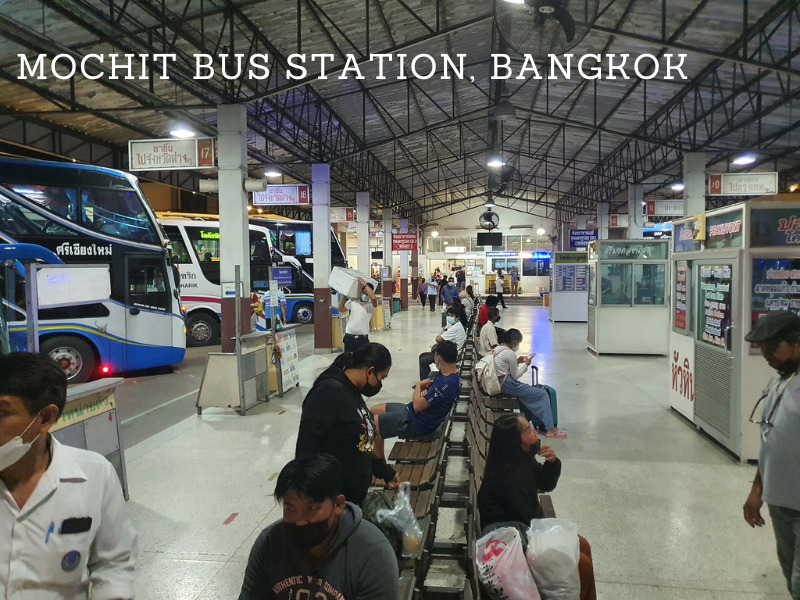
Dealing with potential issues and emergencies
While traveling by bus in Thailand is generally safe and comfortable, it’s important to be prepared for potential issues or emergencies that may arise during your journey. Here are some tips on how to handle various situations:
Breakdowns or delays: In the event of a bus breakdown or unexpected delay, remain patient and follow the instructions provided by the bus driver or conductor. They will typically arrange for a replacement vehicle or alternative transportation. Keep your ticket and any receipts as proof of your journey in case you need to request a refund or compensation.
Lost luggage: If your luggage goes missing during the journey, inform the bus driver or conductor immediately. They will likely help you locate your belongings or direct you to the bus company’s lost and found department. To minimize the risk of lost luggage, label your bags with your name and contact information and secure them properly in the designated storage areas. Keep valuable and important items on your person or in a bag which is kept in sight during the journey.
Theft or pickpocketing: If you suspect that your belongings have been stolen or you’ve been pickpocketed, inform the bus driver or conductor and file a report with the local police. Be vigilant with your valuables, keep them secured and out of sight, and avoid displaying expensive items to minimize the risk of theft.
Communication difficulties: In situations where language barriers make communication challenging, use translation apps or phrasebooks to help convey your message. You can also try to enlist the help of fellow passengers who might speak English or your native language.
Unexpected changes in route or schedule: Stay flexible and be prepared for potential changes in bus routes or schedules due to factors like traffic, weather conditions, or local events. Have a backup plan in place, such as alternative transportation options or accommodations, in case your journey is significantly affected by these changes.
Personal safety and security
Ensuring your personal safety and security while traveling by bus in Thailand is essential for a worry-free experience. Follow these guidelines to stay safe and protect your belongings during your journey:
Choose reputable operators: Select bus operators with a good track record for safety and reliability. Reading reviews from fellow travelers or seeking recommendations from locals can help you make an informed decision.
Be vigilant in crowded areas: Bus terminals and popular tourist destinations can be crowded, making them prime targets for pickpockets or scammers. Keep your belongings secure and stay aware of your surroundings at all times, especially in crowded areas.
Secure your luggage: Use locks or other security measures to protect your bags, both those stored in the overhead compartments and those placed in the luggage storage area beneath the bus. Keep your valuables and important documents with you at all times in a secure, hidden location.
Sit strategically: If possible, choose a seat near the front of the bus, close to the driver or conductor, as these areas are typically safer and less prone to theft. Avoid sitting near the rear exit, as this can be an easy target for thieves.
Travel in pairs or groups: If you’re traveling alone, try to make friends with other travelers or sit near other passengers to minimize your vulnerability. Traveling in pairs or groups can help deter potential thieves or scammers.
Avoid drawing attention to yourself: Dress modestly and avoid displaying expensive items, like jewelry, cameras, or smartphones, which can make you a target for theft. Blend in with the local environment and try to appear confident and aware of your surroundings.
Trust your instincts: If you feel uncomfortable or unsafe at any point during your journey, don’t hesitate to alert the driver or conductor, or even disembark the bus if necessary. Trusting your instincts can help you avoid potentially dangerous situations.
Budgeting for Bus Travel in Thailand
Estimating costs and finding the best deals.
Traveling by bus in Thailand can be an affordable and convenient way to explore the country. However, it’s essential to plan your budget accordingly and know where to find the best deals to make the most of your bus travel experience. Here are some tips to help you estimate costs and find great deals for your Thai bus journey:
Research fares and options: Start by researching the different types of buses available, their fares, and any additional costs, such as booking fees or luggage charges. This will help you get an idea of the average costs for your desired routes and choose the most suitable bus type based on your budget.
Book in advance: For popular routes or during peak travel seasons, consider booking your bus tickets in advance to secure the best prices and avoid last-minute surcharges. Some bus operators may offer early-bird discounts or promotions, so it’s a good idea to keep an eye out for these deals.
Use online booking platforms: Utilize online booking platforms or apps to compare prices and find the best deals for your desired routes. These platforms often offer discounts or promotional fares that can help you save money on your bus journey.
Leverage local knowledge: Seek advice from locals, such as hotel staff, tour guides, or fellow travelers, to get insider tips on the best bus operators, routes, and deals. They might be aware of discounts or special promotions that are not widely advertised to tourists.
Consider off-peak travel: Traveling during off-peak periods, such as weekdays or outside of the high season, can result in lower fares and less crowded buses. Be flexible with your travel dates and times to take advantage of lower prices and a more comfortable experience.
Look for bundled deals: If you plan to visit multiple destinations or use different types of transportation during your trip, look for bundled deals or packages that combine bus tickets with other services, such as accommodations, tours, or activities. These packages can sometimes offer significant savings compared to booking each component separately.
How to save more money while traveling by bus
In addition to finding the best deals on bus fares, there are several ways to save money. Here are some tips to help you cut costs and make the most of your budget during your trip:
Use local transportation, not tourist buses: When possible, opt for local transportation options like songthaews, tuk-tuks, or motorbike taxis for shorter distances or exploring off-the-beaten-path locations. These options are often more affordable than tourist buses and can provide a more authentic and immersive experience.
Bring your own snacks and drinks: Purchasing food and drinks at bus terminals or rest stops can be expensive, so consider packing your own snacks, water, or other beverages for the journey. This will not only save you money but also ensure that you have access to your preferred food and drink options during the trip.
Travel overnight : If you’re traveling long distances, consider taking an overnight bus, which can save you money on accommodations. Be sure to choose a bus with comfortable reclining seats or sleeper berths to ensure a restful night’s sleep.
Limit your luggage: Some bus operators may charge extra fees for oversized or excess luggage, so try to pack light and limit your belongings to avoid these additional costs. If you do need to bring more luggage, research the fees in advance and factor them into your budget.
Share expenses with fellow travelers: If you’re traveling with friends or meet other travelers during your journey, consider sharing expenses, such as taxi rides to and from bus terminals, snacks, or even accommodations if you’re stopping overnight along the way. Sharing costs can help you save money and make your trip more affordable.
Hidden costs and fees to be aware of
It’s important to be aware of potential hidden costs and fees that may arise during your journey. Here are some common expenses to keep in mind when budgeting for your bus trip:
Booking fees: If you’re booking your bus tickets through a travel agency or online platform, you may be charged a booking or service fee. Factor this into your budget and consider booking directly with the bus operator if possible to minimize costs.
Seat selection fees: Some bus operators may charge a fee for reserving specific seats, especially those with more legroom or near the front of the bus. If you have a seating preference, research the associated fees and decide whether the added comfort is worth the extra cost.
Onboard amenities: While many tourist and VIP buses include amenities like complimentary snacks, beverages, or entertainment, others may charge additional fees for these services. Be prepared to pay for any extras you may want or need during your journey, or consider bringing your own snacks, drinks, and entertainment to save money.
Transportation to and from bus terminals: This is probably the biggest additional expense. Don’t forget to factor in the cost of getting to and from bus terminals, whether by taxi, tuk-tuk, or local transportation. Research the typical fares for these services in your destination and budget accordingly.
Recommended Bus Routes for Independent Travelers
Scenic and culturally rich routes.
Thailand is a country filled with stunning landscapes and rich cultural experiences, making it an ideal destination for independent travelers seeking adventure and discovery. Here are some recommended bus routes that showcase the best of what Thailand has to offer:
Bangkok to Chiang Mai: This popular route takes you from the bustling capital of Bangkok to the serene northern city of Chiang Mai, passing through picturesque countryside, lush forests, and charming towns along the way. In Chiang Mai, you can explore ancient temples, sample delicious northern Thai cuisine, and immerse yourself in the city’s rich cultural heritage. In addition, you can treat yourself an enjoy a rather luxurious bus journey in airplane style business class seats on Nakornchaiair bus company. Take a look:
Bangkok to Kanchanaburi: A relatively short journey from Bangkok, Kanchanaburi offers a mix of natural beauty and historical significance. Visit the famous Bridge over the River Kwai, explore the Hellfire Pass Museum, and enjoy the region’s stunning landscapes, including the Erawan National Park with its beautiful waterfalls.
Chiang Mai to Pai: This scenic minibus route takes you on a 762 bend journey the mountains of northern Thailand to the laid-back town of Pai. Known for its relaxed atmosphere, Pai is a haven for travelers seeking natural beauty, outdoor adventures, and a taste of local life. The journey offers spectacular views of lush valleys, rice paddies, and rolling hills.
Surat Thani to Khao Sok National Park: From the southern hub of Surat Thani, take a bus to Khao Sok National Park, one of Thailand’s most diverse and pristine ecosystems. With its ancient rainforest, towering limestone cliffs, and the breathtaking Cheow Lan Lake, Khao Sok is a must-visit destination for nature lovers and adventure seekers.
Krabi to Koh Lanta: This coastal route takes you from the bustling tourist center of Krabi to the tranquil island of Koh Lanta. With its pristine beaches, crystal-clear waters, and vibrant coral reefs, Koh Lanta is an ideal destination for those seeking relaxation, snorkeling, or scuba diving.
Chiang Mai to Nan: For a lesser-known but equally rewarding experience, take a bus from Chiang Mai to the remote province of Nan. This journey offers breathtaking mountain views and an opportunity to explore the region’s unique cultural heritage, including traditional handicrafts, ancient temples, and local cuisine.
Off the beaten path routes
For travelers seeking to venture off the well-trodden tourist paths and explore lesser-known destinations, Thailand offers a wealth of hidden gems accessible by bus. Here are some off-the-beaten-path bus routes that will take you to unique and captivating locales:
Bangkok to Sukhothai: Journey from Bangkok to the ancient city of Sukhothai, a UNESCO World Heritage Site, and discover the fascinating ruins of the Sukhothai Historical Park. This former capital of the Sukhothai Kingdom offers a glimpse into Thailand’s rich history and is an excellent alternative to the more popular Ayutthaya.
Pai to Mae Hong Son: Take a bus from Pai to the remote town of Mae Hong Son, nestled in the mountains near the Myanmar border. This picturesque region is known for its misty valleys, diverse ethnic communities, and a slower pace of life, making it a perfect destination for travelers seeking an authentic Thai experience away from the hustle and bustle of Pai.
Nakhon Ratchasima to Phimai: Travel from Nakhon Ratchasima to the small town of Phimai, home to the Phimai Historical Park. This impressive collection of well-preserved Khmer temples rivals those of Angkor Wat in Cambodia and offers a unique cultural experience without the crowds.
Udon Thani to Nong Khai: From Udon Thani, take a bus to the border town of Nong Khai, situated along the Mekong River. This relaxed riverside town is the perfect base for exploring the mysterious “Sculpture Park,” a collection of massive concrete sculptures depicting Hindu and Buddhist deities, and visiting the nearby Thai-Lao Friendship Bridge.
Trang to Satun: Travel south from Trang to the coastal province of Satun, a lesser-known destination with stunning islands, untouched beaches, and pristine marine parks. Satun offers the beauty and charm of southern Thailand without the tourist crowds, making it an ideal choice for independent travelers seeking a more tranquil experience.
Phetchabun to Phu Thap Boek: Take a bus from Phetchabun to Phu Thap Boek, a high-altitude village nestled in the mountains of central Thailand. Known for its cool climate, lush greenery, and breathtaking vistas, Phu Thap Boek is a peaceful retreat for those looking to escape the hustle and bustle of urban life.

Island hopping routes
Thailand is famous for its idyllic islands and pristine beaches, making it a paradise for sunseekers and water enthusiasts alike. For independent travelers looking to island-hop and explore the diverse beauty of the Thai islands, here are some recommended bus routes combined with ferries or speedboats:
Bangkok to Koh Chang: Take a bus from Bangkok to the Trat province, and then hop on a ferry to the beautiful island of Koh Chang. This less crowded and more tranquil island offers stunning beaches, lush rainforests, and opportunities for trekking, diving, and snorkeling.
Krabi to Koh Phi Phi: From Krabi, catch a bus to the pier, and then board a ferry to the picturesque island of Koh Phi Phi. Known for its crystal-clear waters, dramatic limestone cliffs, and vibrant nightlife, Koh Phi Phi is a popular destination for travelers seeking both relaxation and adventure.
Surat Thani to Koh Samui, Koh Phangan, and Koh Tao: From Surat Thani, you can take a bus to the pier and then a ferry or speedboat to the famous Gulf of Thailand islands – Koh Samui, Koh Phangan, and Koh Tao. Each island offers a unique experience, from the luxury resorts and white sandy beaches of Koh Samui to the world-renowned Full Moon Party on Koh Phangan and the excellent diving and snorkeling spots of Koh Tao.
Phuket to Koh Lipe: Travel from Phuket by bus to the pier and then take a speedboat to the remote island of Koh Lipe. With its powdery white sand, crystal-clear waters, and vibrant coral reefs, Koh Lipe is a hidden gem that offers a more peaceful and secluded island experience.
Krabi to Koh Jum: From Krabi, take a bus to the pier and then board a ferry or longtail boat to the small, unspoiled island of Koh Jum. With its laid-back atmosphere, pristine beaches, and lush forests, Koh Jum is the perfect escape for independent travelers seeking tranquility and natural beauty.
Ranong to Koh Phayam: Take a bus from Ranong to the pier, and then board a speedboat to the charming island of Koh Phayam. This lesser-known island boasts uncrowded beaches, a vibrant local community, and a relaxed pace of life, making it an ideal destination for travelers seeking an authentic island experience.
You may also like

Visiting Thailand Solo: A Safety Guide for Female Travelers
Venturing Alone: The Allure of Solo Female Travel in Thailand The thought of solo travel has captivated the hearts of many adventurers around the world. In recent years, there has been a significant...read more...

The Future of Koh Chang
During the 2023 low season, there’s been quite a lot of chatter on Thai Line groups about how quiet the island has been recently and the lack of budget allocated to promote the island or do...read more...

- Explore Thailand & Neighbors
- Northern Thailand
- Northeastern Thailand
- Western Thailand
- Central Thailand
- Eastern Thailand
- Southern Thailand
- Festivals, Tradition, & Language
- Climate & Weather
- Good to know & Emergency
- Worth Remembering
- TheBear.Group
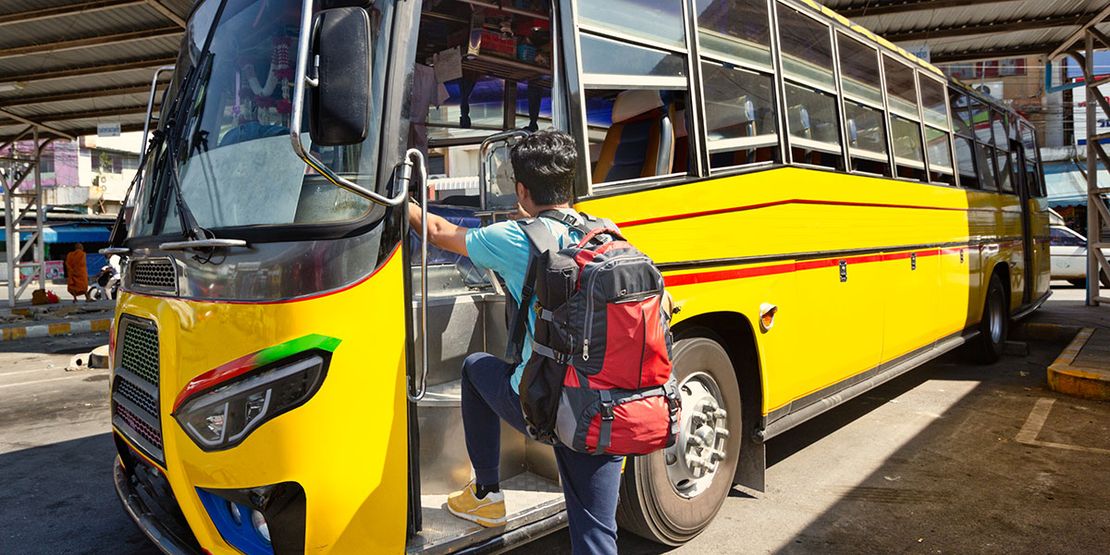
When in Thailand: The Ultimate Guide to Bus Travel
B us travel in Thailand is one of the lesser-known ways for tourists and expats to get around the country 🧐 Since we don’t take the bus very often in our own countries, it is also not our first thought here.
For most Thai people, it is the best way to get around at the lowest cost , and it is the same for foreigners. For tourists, it’s a great way to see more of the country during your vacation. For expats, it’s an economical alternative to driving or flying 👓
The key to bus travel in Thailand during your vacation is to get all the correct timetable information for where you are going. This is easy to do, and you will enjoy your trip more when you leave the driving to them!
Bus Travel during your Thailand Vacation
B us travel to almost everywhere in Thailand is straightforward from anywhere, especially from Krung Thep Maha Nakhon (Bangkok) . All major cities, provincial capitals, and most small towns have a bus terminal 🧐 The Government subsidized bus line “BKS” has the best busses and services and is the safest and most reliable.
Buses are very cheap in Thailand. For example, a one-way ticket from Krung Thep Maha Nakhon (Bangkok) to Khon Kaen is only 400 Thai Baht. Long-distance trips like this always take 20 min. rest stops, and water and snacks are provided 📜 Riding a major bus line is also much safer than driving yourself, and you won’t get stopped at police checkpoints.
There are very few bus accidents in Thailand. Buses also offer convenience. They go places where you can’t fly, save you money 👓 , and often save you time.
5 Reasons to Travel by Bus in Thailand
#1 - busses in thailand are cheap .
T he bus from Krung Thep Maha Nakhon (Bangkok) to Pattaya is only 120 Thai Baht ($4.00). It is 1,300+ by taxi, and driving there yourself costs 600+ in gas and tolls 👓 To Koh Samui , the bus is only 1,000 Thai Baht, including the ferry to the island. To Chiang Mai , it’s 700 each way. The bus fare from Krung Thep Maha Nakhon (Bangkok) to Nong Bua Daeng in Isaan, a distance of 350 km, is only 300 Thai Baht. These prices are impossible to beat. The price of long-distance travel by bus also includes a meal at the rest stop, snacks, and water. What a deal ! 💯
#2 - The bus goes everywhere.
E very town and city in Thailand has a bus terminal. Sometimes that means just a small shelter, but there is a proper bus station with staff in all towns and cities with over 10,000 people. This is great compared to flying 🧐 , and especially important if you go home or to family in the country. Often the nearest airport is nowhere near where you are going, even if it is a district capital.
#3 - The bus is restful.
T here is absolutely no stress when you ride the bus. No hassles at security checks, no long waits at the gate, and no worries about paying attention to the road. The seats on the bus are comfortable and recline much further than in an airplane 👓 If you bring earplugs and a blindfold, you will go out like a light and wake up ready to roll. If you really can’t sleep, they have video entertainment on TV screens, and you can always play with your phone 📎
#4 - There is much more of Thailand to see.
I t is impossible to see Thai life on the ground from 10,000 meters up 🧐 If you are a tourist and travel by plane everywhere, you don’t see the country at all. You will miss all the culture of the Buddhist temples everywhere. You won’t see any of the mountains and forests up close. Farms, fields, and towns along the way are entirely invisible 🎓 Worse, if you always fly, you have no contact with Thai people's real life. Looking out the bus window, you see life in Thailand all around you the whole way.
#5 - You don’t have to drive.
W hether you are a first-time tourist or have lived here for years, it is very stressful to drive in Thailand. If you are from the European continent or the Americas, driving on the left only adds to the stress 👓 Thailand has one of the highest accident rates globally. Still, the percentage of bus accidents is very small. Less than 1% of road fatalities occurred in commercial bus accidents in 2016 (the latest statistics). But the best thing about not driving may be that you will not have any issues at police roadblocks 📜 Unless they are looking specifically for you. That’s a different problem.
How to Travel by Bus From Bangkok?
B angkok’s main bus terminal, Mo Chit, is the best in Thailand. It has all the information on the entire bus network for the country 🧐 The other good one is the eastern main bus terminal at Ekamai. If you are even thinking of taking the bus somewhere, it is strongly suggested you visit one of these places beforehand. Booking online is not possible (yet), but you can call and book by phone and pay at any 7-11 stores nationwide.
Try and get an idea of the schedules by checking tour operator websites. But look things up and still go to the station 👓 Third-party operators charge more and don’t always have up-to-date information. It is best to go to the bus terminal on the day of travel an hour or so before departure and buy tickets in person.
Tips About Bangkok Bus Terminals
M o Chit is easy to find but not simple to get to, especially if you have a lot of luggage. If you have to travel heavily or just come in big suitcases, take a taxi there 📜 The BTS goes to a station called Mo Chit, which is not within walking distance of the terminal. The best and cheapest way there is to use a motorbike taxi from the BTS. But this is also the scariest way for first-timers and impossible with big luggage.
Ekamai is fine from the BTS, only 20 meters from the terminal, but Ekamai buses don’t go everywhere. Ekamai is the best terminal to go to Pattaya or further in that direction, like Cambodia. Insider secret: from downtown Bangkok to Pattaya , use the Airport Rail Link to Suvarnabhumi and take the bus from there 👓

Thailand has 390,000 km of highways; the number of registered vehicles here is over 40 million. Bus travel is the most popular mode of transportation in Thailand, and one of the oldest bus services is the Government-run BKS or Baw Khaw Saw, which was formed 80 years ago.
Tips about Riding the Bus in Thailand
B e careful about drinking before you get on the bus, especially in Krung Thep Maha Nakhon (Bangkok). In the past, there was no issue with this 🧐 But now, if they see you with booze or smell alcohol, they are likely not to let you board; There is beer at rest stops, and you can consume it freely. But on the bus, you must be very discreet about drinking.
I t is a good idea to bring as much food as possible with you on the bus to eat on the journey. They have everything you could want in and outside the terminals. You can also eat well cheaply at rest stops on shorter routes where meals are not included 👓 Salty snacks, and heavy food are best to bring to avoid frequent trips to the “loo.” If you bring food, bring tissue and napkins, too, or you will be a mess.
G et one of the blankets they have on board and two if there are not too many people. The A/C on the bus is cold ! 🧐 If you are ok with the cold blowing, the blankets double nicely as pillows. Thai people will always need a jacket. They get cold if it is anything below 70 degrees (21 degrees Celsius).
First Class
T ry to “upgrade” to the first floor. This only costs about 10 Thai Baht more, but it is well worth whatever it costs 🎓 There are not too many seats on the bottom floor, and the restroom is right there. Getting in and out of the bus seats is complex, and the aisle is tight to walk through. Coming down from upstairs to the bathroom is much more work.
D on’t even TRY to smoke in the bathroom of a bus, no matter how easy it looks. Smoking on a bus is just as bad as on an airplane. The fine and the problems the bus staff will give you are not as rough as on an airplane 🧐 But the attitude of the people riding with you will turn unfriendly, which will not suit you.
Enjoy Bus Travel in Thailand
N ow you know more about bus travel in Thailand, so sit back and enjoy the ride. We hope you better understand that this is one of the excellent ways to get around the country 🧐 In fact, the bus is the most recommended way to get the most out of a visit to Thailand economically. When you add the hours on each end, you spend in an airport; you might reconsider the options now. Nobody will be impressed that you took the bus, but did you come to Thailand to show off or enjoy and know the place 👓 ? NO! So enjoy it while you can!
W ith the bus travel in Thailand vacation tips, you will save expenses and lots of travel time and get hassle-free baggage carrying 🧐 The best part of traveling to Thailand by bus during vacations is enjoying the surrounding sights and traveling safely.
BTS : the Bangkok Mass Transit System, commonly known as the BTS or the Skytrain
Hassle : difficulty or annoyance
BKS : Baw Khaw Saw, or BKS, is the Government subsidized bus line in Thailand
Subsidized : having part of the cost of production paid to keep the selling price low
Timetable : schedule (something) to take place at a particular time : a chart showing trains, buses, or aircraft departure and arrival times.
Dr. Theodore (Professor Bear)
Hi! I'm Dr. Theodore Bennet (Professor Bear), your scholarly travel companion who brings history to life with immersive tours and expert guides. With a Ph.D. in History and years of travel writing experience, I offer authoritative insights for unforgettable journeys.
The Bear Travel | Experience like a Local
A fast-growing Thailand Travel Blog written by Expats and Thais since 2017. We will share our experiences and ideas from an insider point of view for you to create your own unique Thailand experience.
For the latest news and events about The Bear Travel, follow us on Facebook, Instagram, Twitter, Pinterest, or YouTube.
For any issues, concerns, or queries, don’t hesitate to CONTACT us.
Recommended for you
From pixels to panels: the ultimate guide to monitors and displays.

Chao Por Koh Chang Shrine: A Sacred Site on the Island
The Bear Team

Thriving in a Buzz: The Perks of Working from a Coffee Shop

Pang Sida National Park: Enjoying the Wildlife in Sa Kaeo

Orca Baker & Butcher: A Delightful Loft-Style Restaurant at Lasalle's Avenue in Bangkok
Tle (Hungry Bear)

Top 10 Reasons Why Thailand is the Perfect Place for Expats to Call Home


The Ultimate Guide to Traveling from Bangkok to Phuket by Bus
Traveling by bus in Thailand offers a unique experience that allows you to see the landscape and culture up close. While it may take longer than flying, many travelers find the journey rewarding. The scenic views, local interactions, and the chance to experience the country beyond the tourist hotspots make bus travel an appealing option. In this guide, we’ll explore the various options available for bus travel and why it might be the best choice for your trip to Phuket.
Introduction to Bus Travel in Thailand
Bus travel in Thailand is an integral part of the transportation system, catering to both locals and tourists. With a well-developed network connecting major cities and tourist destinations, buses offer an affordable and relatively comfortable means of transportation. Different bus operators provide a range of services, from basic to luxury, allowing travelers to choose based on their preferences and budget. One of the primary benefits of bus travel is the opportunity to witness the stunning landscapes of Thailand, including lush countryside, bustling towns, and serene coastal areas. This immersive experience is often missed when flying. Moreover, buses can access routes and destinations that may not be reachable by air, allowing you to explore more of what Thailand has to offer.

Types of Buses: VIP vs. Minibus
When choosing your bus, you can select between VIP buses and minibuses, each offering distinct advantages and disadvantages. VIP buses are designed for comfort, featuring amenities such as reclining seats, air conditioning, and sometimes even onboard refreshments. These buses typically have fewer stops, allowing for a more direct journey. They are an excellent choice for those who prioritize comfort over speed. On the other hand, minibuses are generally quicker and cater to a larger number of passengers. However, they often come with a trade-off in terms of comfort; seats may be cramped, and the driving can be less cautious. Minibuses also tend to make more frequent stops, which can extend the travel time. Understanding these differences will help you make an informed choice based on your priorities. If comfort is your main concern, opt for a VIP bus. If you’re looking for a faster option and don’t mind a bit of tight space, a minibus could be the way to go.
Booking Your Bus Ticket
Booking a bus ticket in Thailand can be done through various channels, including travel agents, online platforms, or hotel reception desks. It’s advisable to book in advance, especially during peak travel times such as public holidays or festival seasons. Many travelers make the mistake of waiting until the last minute, only to find that their preferred bus is fully booked. When booking your ticket, consider using reputable online platforms that allow you to compare prices and read reviews about the bus operators. Look for operators with a good safety record and positive customer feedback. Additionally, be aware of the cancellation policies in case your travel plans change unexpectedly. A little research can go a long way in ensuring a smooth travel experience.
The Journey: What to Expect
The bus journey from Bangkok to Phuket typically takes around 10 to 14 hours, depending on traffic and the type of service you choose. It’s important to be prepared for the long haul, which might include several stops along the way for food and bathroom breaks. Most buses will stop at convenient locations, allowing you to stretch your legs and grab some local snacks. To make your trip more enjoyable, consider packing snacks, entertainment, and any necessary medications. Download movies, podcasts, or books to keep yourself occupied during the ride. Many travelers also recommend bringing a travel pillow and a light blanket for added comfort. Remember to stay hydrated, but be mindful of how often you drink to avoid too many restroom breaks.
Safety Concerns and Tips
Safety is a major consideration when traveling by bus in Thailand. While buses are generally safe, there are reports of theft and reckless driving, particularly with minibuses. It’s essential to choose reputable bus operators known for their safety standards. Look for those with a good track record and positive reviews. To protect your belongings, keep your valuables close and avoid displaying expensive items. Use a money belt or a secure bag that can be locked. If you’re traveling with large luggage, consider using a secure luggage compartment. Additionally, always be aware of your surroundings, especially when boarding and disembarking from the bus. Following these safety tips can help ensure a worry-free journey.
Alternative Travel Options
If bus travel isn’t for you, there are other options to consider when traveling from Bangkok to Phuket. The most common alternative is flying, which can significantly reduce your travel time to around one hour. However, flights can be more expensive, particularly during peak seasons. If you’re on a tight budget, booking in advance can help you find better deals. Another option is to hire a private taxi, which can be a more comfortable but pricier alternative. This allows for flexibility in your travel schedule, and you can make stops along the way for sightseeing. Additionally, some travelers opt for train travel, which offers a scenic route but may not go directly to Phuket. Each mode of transportation has its pros and cons, so consider your travel style and budget to determine the best option for you.
Local Transportation Upon Arrival
Once you arrive in Phuket, navigating the island can be a challenge if you’re unfamiliar with the area. Several local transportation options are available, including taxis, Grab rides, and local buses. Taxis are a convenient option, but be sure to negotiate the fare beforehand or ensure the meter is running to avoid overcharging. Grab, a popular ride-hailing app, is widely used in Thailand and offers a reliable way to get around. It’s generally more affordable than traditional taxis, and you can pay electronically. Local buses, or “songthaews,” are another option for budget-conscious travelers. These shared rides follow fixed routes and can take you to various destinations around the island. When using local transportation, familiarize yourself with the routes and typical fares to avoid confusion and ensure a smooth journey.
Budgeting for Your Trip
Understanding the costs associated with bus travel is crucial for budget-conscious travelers. Bus ticket prices from Bangkok to Phuket can vary significantly depending on the type of bus and the operator. On average, expect to pay between 600 to 1,200 Thai Baht for a ticket, with VIP buses being on the higher end of that range. In addition to the ticket price, consider other expenses, such as meals during the journey, snacks, and any additional fees for luggage. If you plan on using local transportation upon arrival in Phuket, factor in those costs as well. Having a clear budget will help you manage your finances effectively throughout your trip.
Conclusion: Making the Most of Your Travel Experience
In conclusion, taking the bus from Bangkok to Phuket can be a delightful experience if planned properly. With the right information and preparation, you can enjoy a comfortable and scenic journey while immersing yourself in the local culture. Whether you choose a VIP bus for a more luxurious ride or a minibus for a quicker trip, the journey itself can be an adventure worth experiencing. As you prepare for your trip, remember to book your tickets in advance, prioritize your safety, and budget wisely. Embrace the opportunity to see Thailand from the road, and you may find that the journey is just as rewarding as the destination. Happy travels!
28 Aug 2024
Sign up to get our weekly free guide to selling digital downloads
Your ad here.

- Search Please fill out this field.
- Newsletters
- More to Explore
Getting Around Thailand: Transportation Options
Top Options for Getting From Place to Place in Thailand
:max_bytes(150000):strip_icc():format(webp)/greg-rodgers-adventure-ed92646b25f247049e53af6d36f6c15f.jpg)
Nathan Hutchinson / Getty Images
Getting around in Thailand is extremely easy thanks to the excellent tourism infrastructure and high volume of travelers.
But not all transportation options in Thailand are equal; some involve a little more expense and hassle to get you where you're going. Save time and money on your trip by choosing wisely!
Tuk-Tuks in Thailand
Riding in a tuk-tuk at least once is a unique experience not to be missed while traveling in Thailand . In Chiang Mai and other places where taxis are rare , tuk-tuk may be your primary transportation option.
Listening to your fast-talking driver try to up-sell you, meanwhile, sucking in exhaust fumes are all part of the "fun." If you're really lucky, your Redbull-crazed driver will treat you to a few high-speed misses. Tuk-tuks don't have seatbelts for passengers, but you do get a metallic dollar sign to stare at.
That said, know that even though tuk-tuk means "cheap cheap" in Thai, they often cost more than safer, air-conditioned taxis — particularly for foreign travelers. Because tuk-tuks don't have meters, you'll have to negotiate your fare before getting inside, otherwise, expect to pay way more than you should.
Tuk-tuk drivers in Thailand are famous for their scams. Never agree to stop at shops the driver recommends along the way — this is a classic scam in Thailand.
Songthaews in Thailand
Songthaews are covered pickup trucks with bench seats in the back, and they're as ubiquitous in Thailand as tuk-tuks.
You'll generally encounter two kinds of songthaews: ones that ply fixed routes around a locale and ones you hire as you would a tuk-tuk. In the case of the latter, you'll need to confirm the fare before you get in.
Common destinations (the airport, bus terminal, etc) likely have fixed rates; you won't be able to haggle. You may be able to negotiate fares for other destinations (e.g., your hotel), but the driver is allowed to pick up other passengers along the way. By default, Songthaews are one of the slower transportation options in Thailand.
The red songthaews seen circling places such as Chiang Mai and many of the islands often follow a set route. Fares are fixed and very inexpensive. Locals just seem to know the system, but you won't find it on signs or advertised. You'll have to confirm with the driver where they're going before you get in. Don't delay them too long; much like Jeepneys in the Philippines, they're often crammed with locals who need to get somewhere!
Taxis in Thailand
Taxis in Thailand are often cheaper and more comfortable than going by tuk-tuk, assuming you ensure that the driver uses the meter. Just because the sign on top says "Taxi Meter" does not guarantee that the driver will use the meter — many will adamantly refuse. Don't get caught by surprise; confirm the meter usage by speaking through the window before you get inside.
If your driver won't turn on the meter and instead tries to negotiate a fare with you, simply walk away! Chances are there will already be three additional taxis queued behind him. To increase your chances of finding an honest driver, there are a few, do these two things:
- Hail taxis that are on the move. The ones parked around tourist areas must pay into a hierarchy to sit there.
- Choose a driver who is wearing dress clothing. Drivers who wear shorts or T-shirts are most likely part of the local taxi "mafia." You can also judge the appearance of the vehicle. Older, banged up taxis should be avoided.
You'll be expected to pay a surcharge for leaving the airport , and you will also be expected to pay any tolls encountered. Have cash ready or tell the driver you don't want to use the "expressway."
Ridesharing in Thailand
Much to the dismay of the local taxi mafia, using ridesharing apps is still a good transportation option in Thailand. Overall, you'll pay a little more, however, you won't have to deal with a dirty driver showing you vouchers for local "massage" parlors or claiming the meter is broken.
In 2018, Uber merged Thailand operations with Grab to, the leading rideshare service in Southeast Asia.
Motorcycle Taxis
Although a few nefarious proprietors may offer you a ride on their personal motorbikes, official motorcycle taxi drivers in Thailand must wear a colored vest. You'll need to negotiate your fare before getting on, then hold on tight — taking a motorcycle taxi in busy cities can be a hair-raising experience!
Note: Motorcycle taxis are useful for getting around traffic in a hurry . Your driver will literally squeeze between cars and use sidewalks to save time. Keep in mind most travel insurance policies rarely, if ever, cover accidents that occur on motorcycles.

Trains in Thailand
Traveling by train in Thailand can be a very enjoyable experience , particularly on short, scenic jaunts such as the stretch between Bangkok and Ayutthaya . Unlike long-haul buses, trains often fill up quickly in Thailand; try to book your ticket several days in advance to get the class you want.
Thailand has a mixed assortment of trains running the rails, so whether you end up with a new, modern carriage or a squeaky, aging one is simply a matter of luck. Regardless, trains are better than buses for both scenery and the freedom to stretch the legs.
For overnight trips, travelers typically default to second-class sleeper cars. An attendant will come around to convert the facing bench seats into two bunks with privacy curtains. Top bunks are slightly cheaper but shorter in length; travelers with long legs will be cramped.
The dining car at the back of overnight trains is an option, however, you can avoid overpriced train food by bringing your own snacks and fruit.
Tourist Buses and Government Buses
When taking long-haul buses in Thailand, you basically have two options: tourist buses and government buses. Tourist buses depart from corners and lots in places such as Khao San Road in Bangkok , meanwhile, government buses use proper stations as their bases.
Visitors to Thailand more often than not end up on tourist-only buses with tickets sold by travel agencies and reception desks. Going by bus is a cheap, popular way to get from Bangkok to Chiang Mai , however, trains and domestic flights are more comfortable options.
Although volume sometimes makes tourist bus prices cheaper than the government buses, tourist buses are often unpleasant — passengers are herded like cattle — and sometimes even the targets of theft. Rather than get treated as a customer, you'll often end up treated as a nuisance.
For a more comfortable, long-haul bus experience, you'll need to make your own way by taxi or tuk-tuk to the bus station and purchase your own tickets rather than going through an agent. Navigating the station and finding the right queue can sometimes be a challenge, however, government buses are often more comfortable; many segments include water and snacks served in route.
Night Buses in Thailand
Taking a night bus in Thailand has some advantages. You'll save a night of accommodation, wake up at your destination, and won't waste a nice day moving between points. But unless you're well practiced, don't expect to get much sleep on a night bus as your driver blows the horn and careens over rough roads! Legroom can be cramped, particularly if the passenger in front of you fully reclines their seat.
Although a tiny squat toilet will usually be found on board night buses, you'll hopefully make one or two stops so that the driver can take a break. Stops at the sprawling roadside travel centers are typically very brief — you'll have just enough time to maybe use the toilet and grab a drink.
Tip: Bring a fleece or blanket with you on the bus. Although a blanket is sometimes provided, they are of questionable cleanliness. You'll be glad you brought some warm clothing as the air conditioning often reaches freezing temperatures!
Theft on Night Buses in Thailand
If you choose to take the overnight tourist bus, do not leave any valuables in your luggage that will be stored beneath. A decades-old problem, the drivers' assistants climb into the luggage compartment of your bus while it is rolling down the road and riffle through bags. Small items such as pocketknives and phone chargers often go missing. Your bus and the thieves will long be down the road before you discover what's gone.
Here are some tips to avoid theft on night buses in Thailand:
- Thieves don't always go for big items. Even expensive items such as sunscreen and razorblade replacements are stolen.
- Lock your luggage or use plastic zip ties to connect zippers; you can cut them off after you arrive.
- Pack only laundry — the dirtier the better — at the top of your bag to discourage snooping.
- Close your bags in a secretive way so that you can tell if they have been opened. Use your imagination.
- In the passenger area, don't place bags near the center aisle, and never fall asleep with a phone or MP3 player in your hand.
- Write down the bus company, license plate, and keep your ticket. You can file a claim, but the tourist police will be of very little help.
The problem of theft on night buses is especially rife on the tourist buses from Khao San Road in Bangkok to the Thai islands and Chiang Mai .
Although certainly not the cheapest transportation option, budget flights are always the safest and most comfortable way to move around Thailand.
The earlier you book with budget carriers, the more money you'll save. Fares between Bangkok and Chiang Mai could make you spit out your coffee — in a good way. Rates for a one-way ticket can be as low as US $25, but you'll still have to pay extra for luggage, seat selection, etc. Even still, reducing a painful, overnight bus trip down to 1.5 hours is tempting in many ways.
Bangkok's Suvarnabhumi Airport (BKK) does a good job at handling the high volume of travelers, however, you'll probably be flying out of the old airport, Don Mueang (DMT), when booking on budget airlines. Nor Air and AirAsia are two of the most popular budget choices for domestic flights in Thailand .
Some major airports for getting around in Thailand:
- Bangkok (BKK) — the big "main" airport
- Bangkok Don Mueang (DMT) — the old airport restored as a budget-carrier hub
- Chiang Mai (CNX) — for Pai and other points in the north
- Koh Samui (USM) — for access to islands such as Koh Phangan and Koh Tao
- Phuket (HKT) — for access to islands on the west side of Thailand
- Krabi (KBV) — for access to islands on the west coast and places such as Railay
- Surat Thani (URT) — for access to islands in the Gulf of Thailand such as Koh Lanta.
Renting Scooters in Thailand
You can rent scooters throughout Thailand for between US $5 – $10 per day . If you're comfortable driving one, renting a motorbike can be a fun, inexpensive way to explore islands and visit sites outside of town.
Unless you're an experienced driver in Asia , leave driving in the big cities for another trip. Remember: You drive on the left in Thailand!
Sadly, per the World Health Organization, Thailand has one of the highest road fatality rates in the world. Drive safely and always wear the helmet.
Related Articles
More related articles.

Complete Guide: Getting Around Thailand
by Melissa Giroux | Last updated Feb 24, 2023 | Asia , Thailand , Travel Tips
You booked your flights to Thailand and you’re starting the planning session? Here’s everything you need to know when it comes to transportation in Thailand.
Backpacking Thailand sounds fun, but getting around the country isn’t always super easy! (Sometimes, I wish I could snap my fingers and teleport myself elsewhere.)
Ready To Travel? Don't Go Without Travel Insurance.
Check Prices
This guide will be perfect for you especially if this trip is your first one in Southeast Asia. I’ll explain the different types of transportation available in Thailand as well as how to get around the country.
Depending on the time you have, you might have to prioritize shorter options, but if you do have enough time, take a look at the budget-friendly options too.
Before we start with all this blah, blah, I’d like to reassure you. Traveling around Thailand isn’t too dangerous.
It’s easy to get “ripped off” as a tourist, but I’ll make sure to tell you all about the scams. That being said, traveling by bus, flight, train or van with reputable companies should be all good!
Understanding the Different Transport Options in Thailand
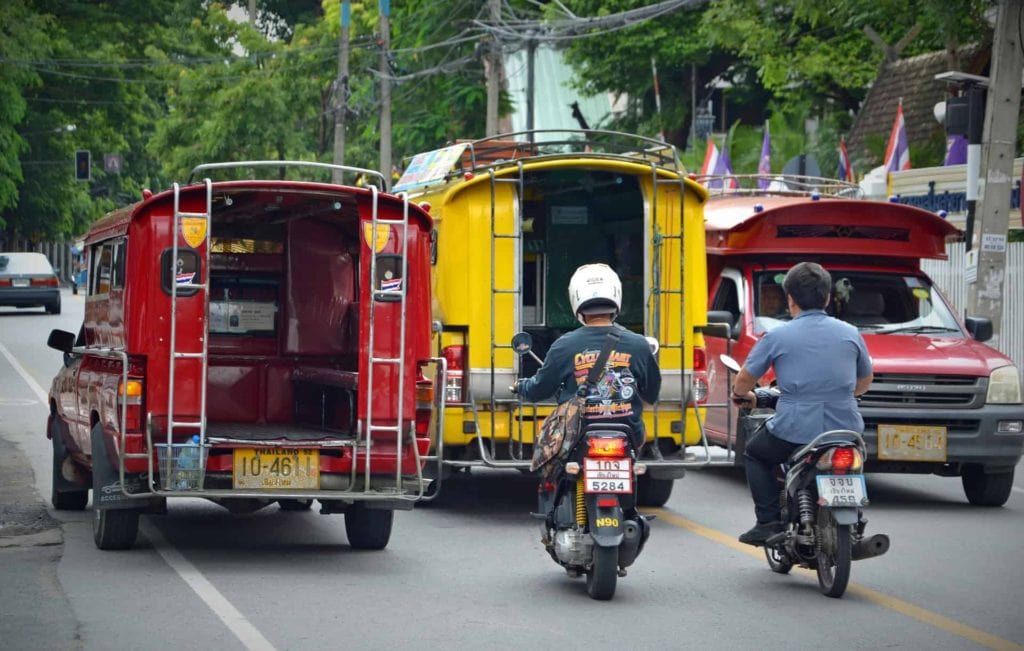
If it’s your first trip to Southeast Asia, you might not be aware of all the options yet when it comes to transportation. Ever heard of a tuk-tuk? Motorbike drivers? Or even songthaews?
As soon as you land in Thailand, you’ll be amazed by the options available to get around a city. These options are great and affordable if you’re looking for a ride to the city or for short distances.
What’s a tuk-tuk?
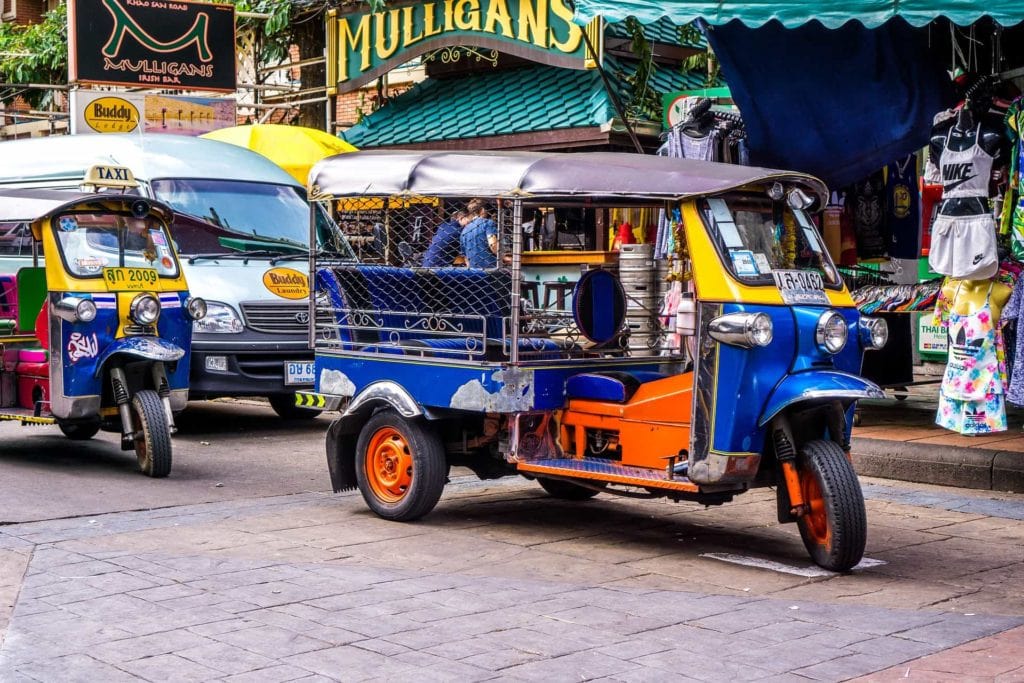
A tuk-tuk (also known as a rickshaw) is basically a three-wheel scooter and is used as a taxi in Southeast Asia.
There’s no fixed price for a tuk-tuk, you basically have to negotiate your price with the driver.
Ideally, you’re going to negotiate before sitting in the tuk-tuk. You can normally fit 1 to 2 (or maybe 3) people in a tuk-tuk.
What’s a motorbike taxi?
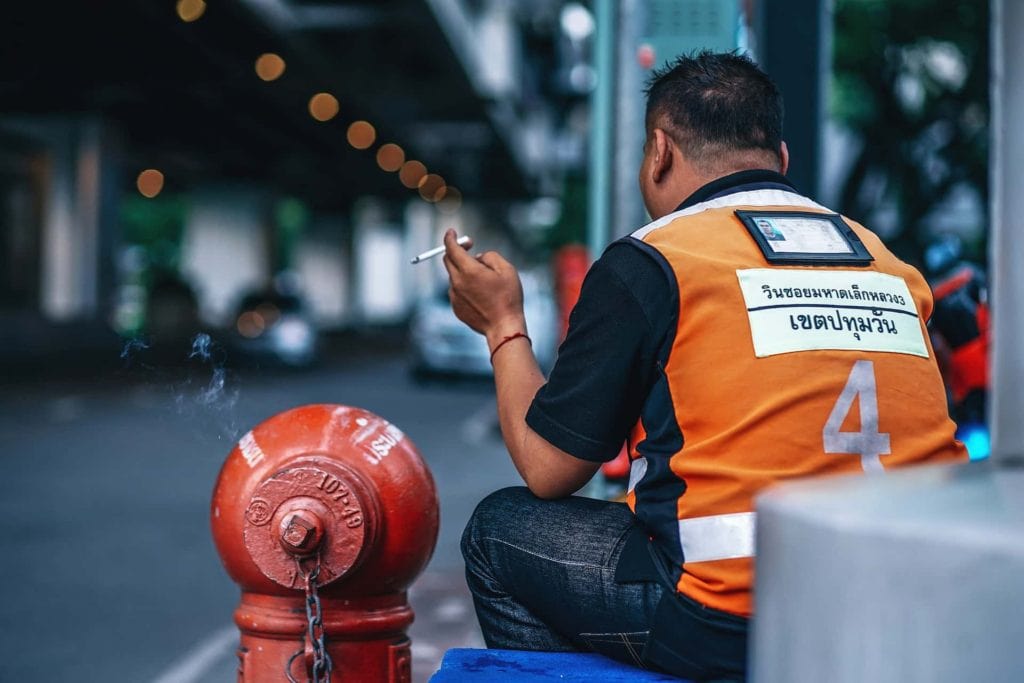
Planning your upcoming adventures? Travel by bus! (It's cheap!)
If you only have a backpack, a great option to consider is the motorbike taxi driver. This option is perfect if you’re traveling solo.
In Thailand, most of the motorbike taxi drivers were an orange jacket so they are easy to recognize. Similar to the tuk-tuk drivers, you should always agree on a price beforehand.
What’s a Songthaew?
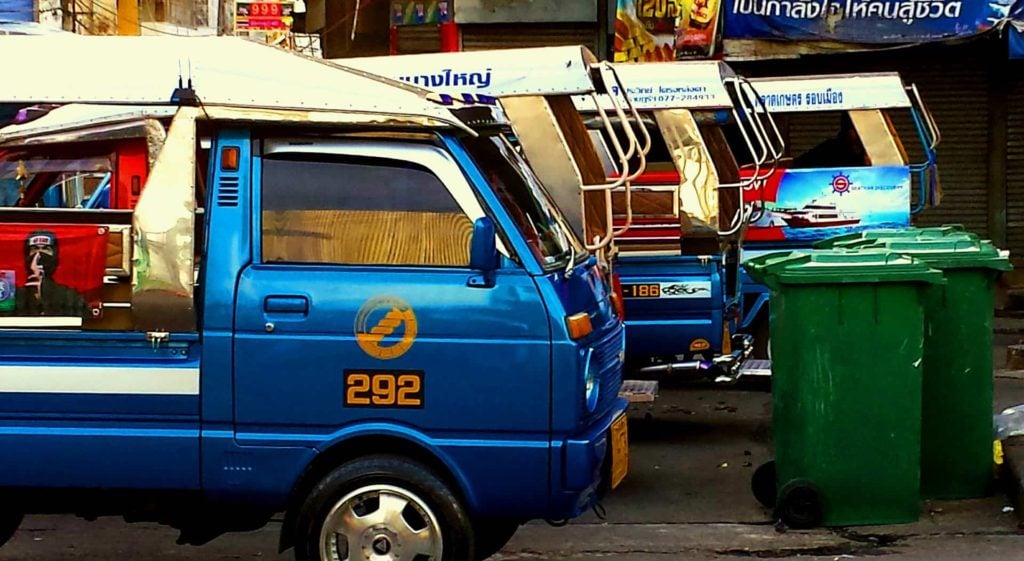
A Songthaew is basically a small truck/pick-up adapted with seats in the back.
These are normally super cheap and used by locals too. As you are sharing the ride with other people, it shouldn’t be too expensive. Obviously, you also need to agree on the price first.
What about “normal taxis”?
I’m not a big fan of taxis in Southeast Asia as this it’s easy to get scammed. Some taxi drivers could drive you in wrong directions, ask for extra money or bring you to shops instead of your hotels. To avoid these scams, I normally prefer to use Grab as it shows you a fixed price beforehand and reviews from previous customers. Grab is a popular app in Southeast Asia, but you will need the Internet to be able to use it.
Now that you can reach your destination in a city, let’s take a look at the option when it comes to getting around Thailand.
How to Get Around Thailand by Flight
The fastest option to get around Thailand is obviously by flight. Although, it’s not necessarily the cheapest. It is worth checking though because sometimes you can get a flight for $10 more than the bus and you could save plenty of your precious time in Thailand.
POPULAR TRAVEL ROUTES
From Bangkok:
From Chiang Mai:
From Krabi:
How to Get Around Thailand by Train
Another fast way to consider which is also budget-friendly is traveling around Thailand by train.
It’s more comfortable than the bus and it gets you to your destination faster. Although, the bus would still be cheaper. I’d say it’s the best mid-range option when it comes to getting around Thailand.
You can check trains and book your tickets on 12GO . Note that trains aren’t running everywhere in Thailand.
POPULAR TRAVEL ROUTES (Click on destinations to check the price)
How to get around Thailand by Bus (or Van)

The most budget-friendly option when it comes to getting around Thailand is by bus.
You can normally take the overnight buses too if you’re covering a long distance (which could make you save money on accommodation too). It’s not the most comfortable option, but I used to travel on overnight buses a lot when I was a bit younger.
If you are wondering how to travel to Thailand by bus and more importantly how to find the right companies and all, it’s pretty easy!
I normally use 12GO to find the right bus for my Thailand travels. The website is easy to use and it gives you plenty of options to pick from.
Buses in Thailand are pretty popular, so you could always just show up at the bus station and get a ticket there too.
I mentioned “vans” above. What did I mean? For shorter transfers, sometimes you’ll get a van instead of a bus. I had a van from Krabi to Koh Lanta.
How to Get to Thailand Islands by Ferry
If you’re planning on doing Thailand island hopping while you’re there, you will likely have to take a ferry at some point.
If you’re booking with 12GO , you can have a mix of bus, van or ferry to reach your destination. Another option would be to go to the pier yourself and book your ticket there.
If you’re wondering how to get around Thailand islands, the best way is to rent a scooter or use the transport options as mentioned above.
- Koh Phangan
From Koh Phangan:
From Koh Lanta:
- Koh Phi Phi
What’s the most budget-friendly option when it comes to getting around Thailand?
As I mentioned above, the most budget-friendly option would be to travel around Thailand by bus. You can plan your trip and your expenses by looking at the options on 12GO in advance.
There aren’t any sales when it comes to buses in Thailand. The prices are normally fixed but can change during the high season.
What’s the best way to travel around Thailand?
The first thing to keep in mind when planning your trip to Thailand is to create a smart itinerary. You want to plan the best route to travel Thailand considering different factors (how long you have in Thailand, what will be the season, etc.)
Domestic travel in Thailand can sometimes be long.
That being said, if your trip is going to be short, you won’t want to waste time traveling on a bus for hours. In that case, the best way to travel around Thailand would be by flight or by train.
Depending on your budget and priorities, your options might be different!
How to book your transports in Thailand?
As I said before, 12GO is a golden tool to book transports in Thailand. You can pay directly online which makes my life easier.
Although, you could always book at your accommodation, at the bus stations or at the pier. You can then compare prices. You should know that booking at your hostel might be more convenient, although, it might be a bit more expensive.
Planning your trip to Thailand?
You can book your accommodation on Booking.com or HostelWorld .
Make sure to get travel insurance before your trip too.
You can check the options on Genki or SafetyWing .
You can always read more about Thailand:
- Thailand SIM card
- Is Bangkok safe
- Is Koh Samui safe

MY TOP RECOMMENDATIONS
BOOK HOTEL ON BOOKING.COM
BOOK HOSTEL ON HOSTELWORLD
GET YOUR TRAVEL INSURANCE
LEARN HOW TO START A TRAVEL BLOG
LEARN HOW TO VOLUNTEER ABROAD

The best ways to travel around in Thailand

Aug 28, 2024 • 6 min read

Plan your travels around Thailand with our guide to transportation. John Harper/Getty Images
Thailand is extremely well-connected, which is good news for the many tourists that want to explore this Southeast Asian nation beyond Bangkok . Whether you’re heading north to the mountains of Chiang Mai or south to an island , there are flights, trains, buses, minivans and boats ready to get you there. And better yet, most of these options are efficient and good value.
To help you plan your routes and methods of transportation, we’ve put together this guide to getting around in Thailand.
Flying is the fastest way to get around Thailand
Planes are the most efficient way to get around Thailand, although obviously not the most sustainable choice. The country’s expansive air network links Bangkok with all the major tourist destinations – Chiang Mai, Ko Samui , Phuket , and Krabi – as well as just about every provincial capital you’ve never heard of. And if your destination is an island, some of the low-cost carriers also offer airport-bus-ferry transfers.
Note that Bangkok has two airports, with Don Mueang International Airport functioning as the de-facto budget/domestic hub, and Suvarnabhumi Airport as the primary international hub. A taxi is the quickest way to get into central Bangkok from either airport. Expect to pay at least 350B for the fare, plus the obligatory airport fee of 50B and an additional fee for toll roads. Both airports are also linked to Bangkok’s urban train network, and there’s a shuttle bus that runs between the two airports.
The major domestic operators are AirAsia , Bangkok Airways , Nok Air , Thai Lion Air and VietJet Air . The competition means domestic flights are relatively cheap, but as some of these airlines are essentially budget airlines, they can be sticklers when it comes to luggage weight and size – you’ve been warned.

The train is the slow but steady way to see Thailand
If you’re not in a hurry, and if the rails lead to where you want to go, the State Railway of Thailand offers a cheap, comfortable way to get around Thailand. The country’s rail network spans four main long-distance lines – Northern, Northeastern, Eastern and Southern.
Bangkok shiny new train station, Krung Thep Aphiwat Central Terminal, north of the city center, opened in 2023. It’s the terminus for the Northern, Northeastern and Southern lines and is also connected to the Metro network. With the completion of this station, there are plans for high-speed trains to crisscross the country, with one route to Nakhon Ratchasima under construction. The former terminus, Bangkok Railway Station (Hua Lamphong), in Chinatown, remains the hub for local, commuter and tourist trains, as well as all trains on the Eastern Line.
To avoid scams or overpaying, buy your tickets directly at one of the stations mentioned above, or via the State Railways of Thailand website or hotline (1690 from within Thailand). There are various types of seats, outlined below.
First-class
- Available on Overnight Express and Special Express trains only, first-class tickets include an air-conditioned cabin, two twin beds, a private bathroom and a lockable door.
- These are ideal for couples or a family looking for privacy.
- Book several days in advance, especially in peak season (November to March).
Second-class
- The most popular option and available as seats or sleepers depending on the route.
- Can choose between a more expensive air-conditioned cabin or one with a fan.
- Great for solo female travelers – there are women-only sleepers available on some trains.
Third-class
- Recommended for short distances.
- No frills wooden seats with no air-conditioning.
- A good option for those on a tight budget .

Save money by taking a bus or minivan
Buses and minivans form the most comprehensive – and cheapest – network of transportation in Thailand. There are a variety of bus companies, but the most reliable are those run by the government-subsidized the Transport Co . Buy tickets online or in person at the bus station to avoid scams. In particular, be wary of buses that operate directly out of tourist centers, such as Bangkok’s Khao San Road , as there have been cases of baggage theft and commission-seeking stops.
As with most transport in Thailand, there are different levels of luxury.
- VIP, Super-VIP, and 1st-class buses are recommended for overnight journeys as they have plenty of room to recline and a toilet on the bus. Some even have meal vouchers and bus stewards. Be sure to bring a sweater and perhaps earplugs, as sub-zero air-con and movies on full-blast are the other “perks” of this class.
- Second-class means air-conditioning, but no on-board toilet, and perhaps a few more stops.
- "Ordinary" non-air-con buses are a dying breed these days, although they still can be found in more rural areas. These buses are very slow, with frequent stops.
For an increasing number of short and medium-distance routes in Thailand, minivans are superseding buses. Both private and run by the Transport Co., they’re cheap and quick, but passengers are typically jammed in like sardines, and drivers can be reckless.
For more freedom, consider a car or motorcycle
Although renting a car in Thailand may seem intimidating, driving is a great way to explore the country outside of urban areas. That said, Thailand is home to some dangerous roads, and it’s essential to take things slow and be extra cautious.
Cars can be rented in most major cities and airports both from local companies and the usual international chains. Motorcycles can be hired from guesthouses and small mom-and-pop businesses. For the latter, most businesses ask that you leave your passport as a deposit. Before driving off, check the condition of the motorcycle and ask for a helmet (which is required by law).
In theory, short-term visitors who wish to drive any vehicle (including motorcycles) in Thailand need an international driving permit. In practice, this rule is rarely enforced.
Take a long-tail boat for short-haul and ferries for longer journeys
There’s a variety of boat travel in Thailand, spanning both river and sea. For short hauls, including trips along Bangkok’s canals, the standard method of aquatic transport is the open-air long-tail boat. Typically you’ll need to haggle for a price in advance. Larger, roofed, inboard engine boats are used for trips of up to an hour or two. Hydrofoils, ferries and larger, more comfortable speed boats cover longer boat journeys out to the islands.

Use motosai , túk-túks and taxis to explore Thai cities
A common way to get around large Thai cities is via motosai (motorcycle taxis). You’ll see the vest-wearing drivers on street corners, from where they run routes, generally short distances for set rates, or you can negotiate a ride elsewhere – a clever solution when traffic is bad. Hang on for dear life, and don’t forget to wear a helmet.
Although still common in Thai cities, the three-wheeled open-air vehicles known as túk-túks are less a form of public transport and more a novelty these days. It’s necessary to haggle with the driver before you get in; starting rates are typically astronomical for non-Thais. Also, be wary of drivers who take you on detours to their "friend’s shop." This is a common scam for drivers who get kickbacks from store owners to drive tourists to their businesses.
Taxis are found in most larger provincial capitals, although in some destinations, fares can be set high. To avoid communication problems, download the Grab app (Uber doesn’t operate in Thailand).
Bangkok is the only Thai city with an urban rail system. The Metro (MRT) and Skytrain (BTS) are convenient and expansive, and the network is constantly growing. Fares start at 15B and increase depending on how far you travel. Trains operate from 5:30am to midnight.
Accessible transportation is limited in Thailand
Thai buses and trains don’t typically have facilities for passengers with disabilities, and Bangkok is the only place in the country where there are some provisions. The Bangkok Mass Transit System has elevators in 17 of its 36 stations; the Metro is even more accessible as all stations have an elevator, and there are locks for wheelchairs.
This article was first published Sep 14, 2021 and updated Aug 28, 2024.
Explore related stories

Aug 16, 2024 • 10 min read
Dive in and soak up the world-class vibes: 10 of the most incredible hotel pools worth traveling to for an ideal dip.

Aug 12, 2024 • 12 min read

Aug 8, 2024 • 9 min read

Aug 7, 2024 • 8 min read

Aug 5, 2024 • 6 min read

Jul 25, 2024 • 7 min read

Jul 25, 2024 • 10 min read

Jul 12, 2024 • 7 min read

Jun 15, 2024 • 9 min read

May 23, 2024 • 4 min read

Transport in Thailand – 14 Ways to Get Around (Easy Guide)

In this article, we will explore the various modes of transport available throughout Thailand and weigh the pros and cons of each .
Getting around Thailand

Taxes are ideal if you’re looking for a convenient way to get around Thailand. However, convenience comes at a price – they are often the country’s most expensive mode of road transport.
Taxis are widely available in major cities across the country and are also a great option for getting to destinations that are farther away.
Personally, I have used taxis to travel long distances, such as from Bangkok to Pattaya , or shorter trips, like from Bangkok Airport to the city center .
Regarding affordability, Bangkok is one of the most affordable cities for taxi travel, while areas like Phuket tend to be more expensive.
Public taxis in Thailand operate on a meter system, but for longer distances, you can negotiate a fixed fare.
Taxis are especially convenient for airport pick-ups and traveling around cities. Just be prepared to pay a bit more for the convenience.
- Convenient way to travel in Thailand
- Ideal for getting picked up from airports or traveling around cities
- Can be used to get to further away destinations
- Available in major cities around the country
- Can be expensive compared to other modes of transport
- Prices can be higher in touristy areas like Phuket
- Drivers may not speak English
- Some drivers may refuse to use the meter and insist on a fixed price
Insider Tip:
Ensure that the taxi driver uses the meter or agrees to a fixed price before starting the journey to avoid being overcharged
Motorcycle Taxi
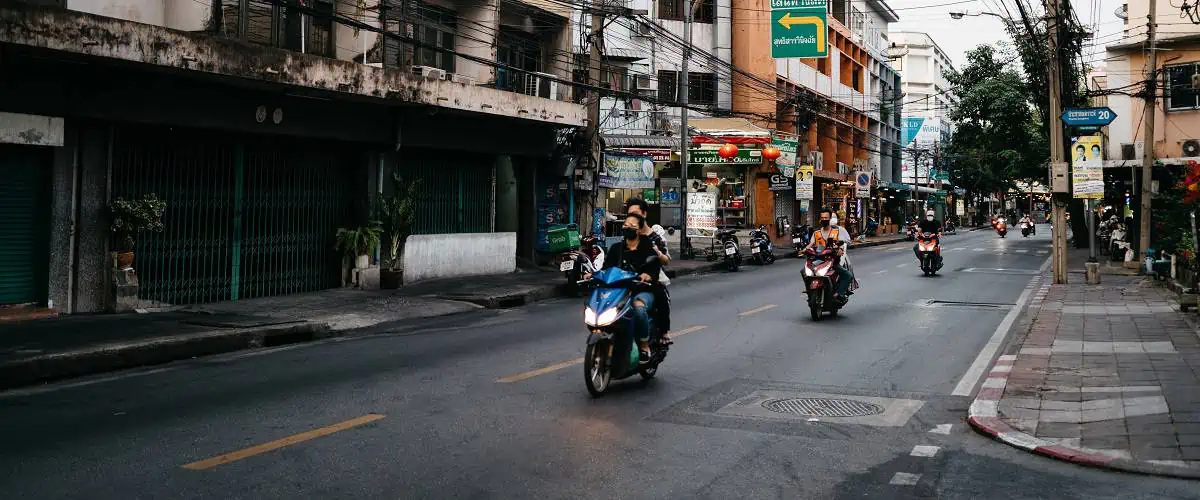
Motorcycle taxis are a popular mode of transportation in Thailand’s big cities, particularly for those who want to avoid traffic.
They are much cheaper than standard taxis, making them an affordable option for locals.
You can find motorcycle taxis near transport hubs and shopping malls in large cities, where the drivers wear distinctive high-visibility vests gathered in groups waiting for customers.
However, it’s important to note that motorcycle taxis can be dangerous despite being cheaper and faster in traffic. For your safety and to comply with local laws, wearing a helmet when riding a motorcycle taxi in Thailand is mandatory .
Motorcycle taxis are not metered; instead, the driver will ask where you want to go and provide a fixed price upfront but only pay the driver when the journey is complete.
- Affordable and often faster than car taxis in heavy traffic
- Can be dangerous, especially if proper safety precautions are not taken
- Can be Difficult to communicate the destination with the driver (tip: show them on Google maps)
- Not suitable for long-distance travel
Motorcycle taxis should always have an extra helmet for the passenger. If they don’t you can wait for the next available taxi that does.

Grab is a well-known ride-hailing service in Asia and is a popular alternative to Uber in Thailand since Uber no longer operates here .
With the Grab app, you can easily manage all your local road transport needs, including selecting your pickup and drop-off points, and the type of vehicle you prefer.
Grab offers multiple vehicle types to cater to different budgets and accepts multiple payment methods.
Although Grab may not be cheaper than using a local taxi, it provides the convenience of managing everything through the app and offers additional safety measures.
I personally use Grab on numerous occasions to travel both short and long distances. For instance, I booked a Grab from Bangkok to Pattaya for around 2,000 THB.
- Convenient app for managing all your transport needs
- Multiple vehicle types to choose from
- Accepts multiple payment methods
- Additional safety measures
- More expensive than local taxis
- Surge pricing during peak hours or high-demand times
- Limited availability in some areas outside major cities
Insider tip:
Get a tourist SIM to access the internet and book using Grab while out and about.

Bolt is a ride-hailing service that’s been gaining popularity in Thailand, especially in major cities like Bangkok.
It offers a range of vehicle types, from budget to luxury, and generally has lower prices than Grab, although not as low as local taxis.
While Bolt is known for its comprehensive pricing, it only accepts cash payments in Thailand.
As a frequent traveler, I often compare Bolt prices against those on Grab, and sometimes use Bolt when Grab is in high demand and drivers aren’t available.
Keep in mind that while the fare is fixed with Bolt, it can change based on factors such as traffic or other circumstances during the ride.
- Generally cheaper than Grab
- Multiple vehicle types are available
- Only accepts cash
- Not as cheap as local taxis

Tuk Tuks are an iconic mode of transport for tourists in Thailand’s cities like Bangkok and Chiang Mai.
Although more expensive than regular taxis, they’re great for getting around temples or on small streets.
Tuk Tuks are generally found around tourist hot spots and are not on a meter, so you can bargain for a lower fare.
They can hold a maximum of four people and are generally more comfortable than motorcycle taxis, but they are still more pricey.
Most Tuk Tuks in Thailand run on diesel fuel, which can emit a significant amount of smoke and is harmful to the environment. However, a new service called Muvmi is now operating in Bangkok, offering cheaper electric Tuk Tuks as an alternative.
Locals tend to avoid them due to the cost.
- Unique and fun experience
- Great for short trips and navigating small streets
- More expensive than regular taxis or motorbike taxis
- Negotiating the fare can be a hassle
- Not the most comfortable or safest option
Always negotiate the price with the driver before getting in the Tuk Tuk to avoid being overcharged.

Are you ready to explore Thailand on a budget? Introducing the Songthaew! These converted pickup trucks are a convenient and cheap mode of transport in major cities like Bangkok and Chiang Mai.
The covered seating area means you can stay dry during rainy seasons.
The Songthaew is a shared form of transport, usually following fixed routes where you can hop on and off.
Hail the driver, tell them your destination, and negotiate the fixed cost.
Communication with drivers can be tricky, so having a map handy is a good idea. Remember to pay the driver ONLY once you’ve reached your destination!
- One of the cheapest ways to travel in Thailand
- Covered seating area protects from rain
- Ideal for short affordable trips
- Shared type of transport so may not be suitable for those who prefer privacy
- Communication with the driver may be difficult
- Limited to specific routes and may not go to certain destinations.
When taking a Songthaew, it’s helpful to have a map or a translation of your destination written in Thai to show the driver.

Traveling around Thailand on a budget? Buses are your best bet. They’re one of the cheapest forms of transport and are widely available across the country.
You can book bus tickets on the day of travel or plan ahead and book through a platform ticketing platform.
Public city buses in Bangkok can be notorious due to vehicle age, overcrowding and lack of air conditioning, but some newer electric buses have been introduced recently.
Many tourists and locals use regional buses to travel between cities because they’re more affordable than flying or taking a taxi. The major bus stations in Bangkok with regional connections are Ekkamai Bus Terminal and Morchit Bus Station.
I only recommend taking a local Bangkok public bus if you know it’s a newer vehicle with air conditioning.
- One of the cheapest forms of transport in Thailand
- Regional buses are affordable for getting between cities
- Buses can reach destinations that other modes of transport cannot
- Public city buses in Bangkok are mostly dated and overcrowded
- Some public city buses in Bangkok do not have air conditioning
- Can be uncomfortable for long journeys
- Can be delayed due to traffic and other factors
Insider tips:
If you’re taking a public bus in Bangkok, have small change ready, as they may not accept larger notes.

The BTS Skytrain system is one of the most convenient and reliable ways to get around Bangkok.
With multiple lines and stations, the BTS Skytrain network covers many central areas and popular tourist landmarks, including Sukhumvit and Siam, making it a popular mode for tourists and locals.
The BTS network runs above ground, so you can get great city views. Trains are modern, clean, and air-conditioned, providing a comfortable ride.
I recommend avoiding the BTS during peak hours (8-10 am and 5-6 pm) because it gets very crowded with locals heading home from work.
To use the BTS Skytrain, you can buy tickets at the train station or top up a Rabbit Card, a prepaid card that allows you to tap and go at the entrance gates.
If you’re planning to stay in Bangkok, booking a hotel close to an MRT or BTS station is recommended for easy access to transportation.
- Convenient way to avoid traffic in Bangkok
- Modern, clean, and air-conditioned trains
- Good for getting to central areas and tourist landmarks
- Expensive compared to other cities’ inner-city transport
- Crowded during peak hours

The Mass Rapid Transit (MRT) underground train system is a reliable and cost-effective option when exploring Bangkok as a tourist or local.
It connects areas like Asoke and Lat Phrao and is cheaper than the BTS system.
The trains are modern, clean, air-conditioned, and have seating and standing areas.
However, there’s no shared top-up card for BTS and MRT, so purchasing separate tickets or using the MRT’s unique card system is necessary.
The central MRT station is Sukhumvit, connecting the city’s north and south.
Peak hours between 8-10 am and 5-6 pm can be crowded, so it’s better to avoid the MRT during these times.
However, it’s also better to get a train than a car in peak hours.
The MRT system is an excellent choice for exploring non-central areas of Bangkok. If you’re looking for accommodation, choosing a hotel close to an MRT or BTS station is recommended for convenient transportation.
- Modern and clean trains with air conditioning and seating
- Great for getting to non-central areas of Bangkok
- Cheaper than using the BTS
- No shared top-up card with BTS Skytrain, separate tickets, or MRT top-up card required
Plan your route using an app like Google Maps that will show you which stops and exit to take during your journey.

If you’re planning a trip to Thailand and want to explore the country on a budget while being eco-friendly, consider taking the regional train system.
While regional trains in Thailand are typically slow, the government is investing in faster high-speed trains .
Basic class tickets are affordable, but facilities will be limited.
Some carriages lack air conditioning and rely on small overhead fans for cooling.
The train network in Thailand is not extensive, but popular routes with tourists include Bangkok to Chiang Mai (north), Bangkok to Surat Thani (south), and Bangkok to Ayutthaya .
Thailand’s train system offers various classes, including standard and first class, with the unique experience of sleeper trains available for longer journeys. Staff members will assist in transforming your seat into a comfortable flatbed when it’s time to rest.
You can purchase tickets for regional trains at train stations on the day of travel or through online platforms.
While train travel is generally budget-friendly, it’s worth comparing flight prices to ensure you get the best deal.
- Budget-friendly option
- Sustainable travel
- Unique experience with sleeper trains
- Limited routes
- Slow travel
- Basic facilities in lower class tickets
Bring snacks and drinks as the food options on trains can be limited

When traveling within Thailand, it’s hard to beat air travel to get around the country quickly and efficiently.
The country boasts a wide network of domestic airlines like Thai Smile, Thai Lion Air, Nok Air, and Thai Airasia that offer affordable and convenient flights.
Budget travelers can take advantage of the low-cost options, while those willing to spend more can enjoy the luxury of high-end carriers.
The primary international airport is Suvarnabhumi Airport (BKK), but there are other international airports you can fly into Thailand , including Don Mueang, Chiang Mai, and Phuket.
Check my article on flight journey times and routes to Thailand from airports worldwide.
To find the best deals on airfare, I use search engines like Skyscanner or Google Flights to compare prices and book my flights in advance.
- Air travel is the quickest way to get around Thailand
- Thailand has a vast network of domestic airlines
- Air travel is relatively affordable in Thailand
- Getting to and from the airport adds time to your journey
- Domestic flights in Thailand often have strict baggage restrictions
Check the airline’s baggage allowance policies before booking your flight to avoid being overcharged on arrival.

Renting a car might be a good option if you’d like more freedom and flexibility to explore Thailand.
Car rentals are available at major airports or branches within cities like Bangkok or Chiang Mai.
However, before hitting the road, ensure you have the required license to drive legally in the country and are aware of local laws.
Google Maps is an essential tool for navigation in the country, but you need a good SIM with a data plan or the ability to download an offline map.
The car rental will come bundled with basic cover, but read the fine print and understand what you are covered for.
If you’re staying in Bangkok, I wouldn’t recommend hiring a car because plenty of other forms of transport are available, and Bangkok is notorious for bad traffic.
Comparing rental options on Discover Cars or Skyscanner sites can help you find the best deals with regional hire providers.
- More freedom to explore off-the-beaten-path destinations
- More comfortable and convenient for traveling in groups or with luggage
- Road conditions can be challenging and unpredictable in some areas
- Traffic congestion and lack of parking can be frustrating in major cities.
When driving in Thailand, be aware of motorcycles and scooters in blind spots. They are everywhere!

If you want to discover Thailand’s gorgeous islands, then ferries are a fantastic way to travel between them. You’ll find frequent services between popular islands like Koh Samui or Koh Phangan, providing a practical and cost-effective option for exploring the region.
Traveling to Koh Samui? Check my how-to on getting there .
Some ferries can even accommodate cars, which is a game-changer if you’ve hired a vehicle and want to bring it along on your island-hopping adventure.
Booking your ferry tickets is easy.
You can purchase them online in advance on a ticketing platform or on the day of travel.
While ferries may not be the quickest mode of transportation, they offer a comfortable ride and an opportunity to take in beautiful scenery.
What’s more, ferries can be a more practical choice if you have more luggage compared to taking a speedboat.
Of course, safety is paramount when traveling by ferry, so it’s crucial to wear the lifejackets provided.
- An affordable option for traveling between islands
- Can transport cars, making it easier to explore the islands with a hired car
- A comfortable ride with the opportunity to enjoy the scenery
- Slower mode of transportation compared to speedboats
- Can be affected by weather conditions, causing delays or cancellations
Stay up-to-date with ferry schedules, especially during the low season, which can be subject to change.

If you’re short on time and want to reach the islands of Thailand quickly, then speedboats are a great option.
Although they can be more expensive than slower ferries, they are fast and efficient.
Keep in mind that speedboats have limited space for luggage, so if you’re traveling with many bags, this might not be the best option for you.
For those who prefer a more exclusive experience, you can book a private speedboat.
Whether you opt for a private or shared speedboat ride, tickets can be purchased on the day of travel or online, providing flexibility in planning your trip.
Safety is always a top priority when traveling by speedboat, so make sure that lifejackets are always provided and worn.
- Fast way to get to islands
- Private speedboat options are available
- More expensive than ferries
- Limited luggage capacity
Bring motion sickness medication if you’re prone to seasickness, as speedboats can be a bumpy ride.
Thailand transport tips
Stay safe and prepared if you plan to travel when using transport in Thailand.
Below are a few tips based on my personal experience traveling in Thailand
- Get travel cover : It’s always a good idea to have cover for unexpected events such as emergencies, trip cancellations, or lost luggage.
- Look after your belongings : Keep your valuables like passports, phones, and wallets secure and within reach.
- Download essential travel apps : From navigation maps to language translators .
- Check weather conditions : Thailand can experience heavy rain and flooding during certain months, so monitor the weather before your trip.
- Prepare route : Plan your route using Google Maps or a trip planner
- Police: 191
- Tourist police : 1155
- Ambulance: 1669
- Follow the local regulations : When using any form of transportation, always follow the local regulations, including wearing a seat belt in a car.
Thailand transport resources
Below I have included some helpful resources when traveling in Thailand
- Skyscanner and Google Flights are great for comparing flight tickets and finding the best deals for your journey.
- For checking bus timetables, the ViaBus app or transitbangkok website are both helpful tools.
- For navigation, Google Maps is a reliable resource that works well in most parts of Thailand.
- If you plan to travel by train, then the railway.co.th website is the official source for checking rail timetables in Thailand.
- To make communication easier, you can use Google Translate for Thai translations.
- Lastly, for getting around cities and towns, use ride-hailing services that can be accessed via a mobile app.
Before you go…
Looking for other travel guides? We have compiled a list of helpful articles to help you plan your trip to Thailand .
Written by Nicky
Affiliate Disclosure: We may earn a small commission through affiliate programs if you book through a provided link, which helps us maintain and improve the site. Our recommendations are based on independent research and analysis, and we always strive to provide our readers with unbiased and helpful information.

- [email protected]
- Malaysia Ringgit (RM)
- Singapore Dollar (S$)

New Member Exclusive
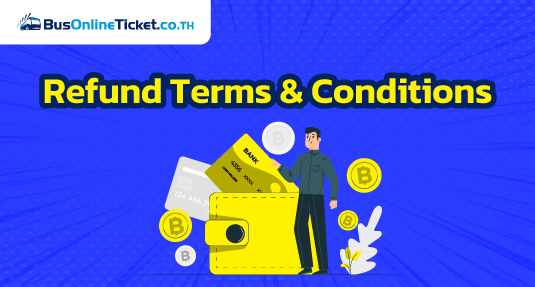
Refund Terms & Conditions
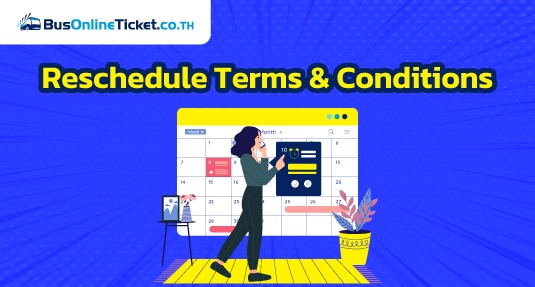
Reschedule Terms & Conditions
Popular bus route.
- Bus from Bangkok to Hat Yai
- Bus from Bangkok to Phuket
- Bus from Bangkok to Nakhon Ratchasima
- Bus from Bangkok to Ubon Ratchathani
- Bus from Chiang Mai to Pai
- Bus from Chiang Mai to Mae Kampong
- Bus from Krabi to Surat Thani
Popular Train Route
- Train from Bangkok to Chiang Mai
- Train from Bangkok to Hua Hin
- Train from Bangkok to Hat Yai
- Train from Bangkok to Chumphon
- Train from Bangkok to Nakhon Si Thammarat
- Train from Chiang Mai to Bangkok
- Train from Hat Yai to Bangkok
Popular Ferry Route
- Ferry from Krabi to Koh Phi Phi
- Ferry from Pak Bara to Koh Lipe
- Ferry from Donsak Pier to Koh Phangan
- Ferry from Koh Phi Phi to Phuket
- Ferry from Donsak Pier to Koh Samui
- Ferry from Koh Samui to Koh Phangan
- Ferry from Trat to Koh Kood
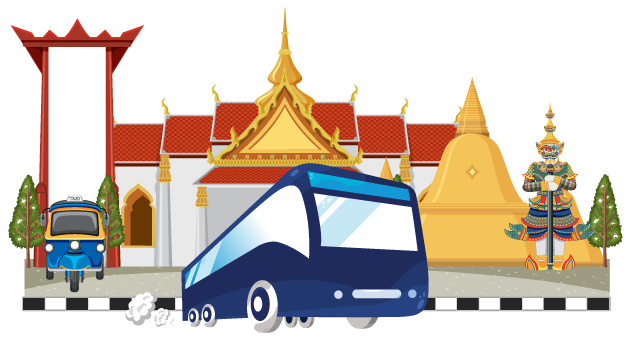
Travelling by Bus, Train and Ferry in Thailand
Looking for an online booking portal to book bus, train or ferry tickets to travel in Thailand? You have come to the right place! Thailand is a big country and planning a Thailand travel itinerary can be though considering how much Thailand has to offer to its visitors. From the north to the south, even on the Isaan (Northeastern) regions, Thailand travel gives you a variety of beaches, highlands, natures, temples, wildness and tranquility. This “Land of Smiles” is rich with cultural and historical background, making Thailand travel a meaningful trip for many visitors.
How We Can Make It Easier For You?
BusOnlineTicket.co.th aims to make your journeys even easier by providing a one-stop online booking portal for bus tickets, train (SRT) tickets and ferry tickets in Thailand. With our service, you can book ticket online in Thailand, and even make advance booking online.
Download Our Apps

Loyalty Program
Frequent traveler? We are happy to welcome you to join our Loyalty Program. With our Loyalty Program, you get to earn BOT Miles every time you book with us and redeem the points to cut off the price for your next purchase. Everyone can join our Loyalty Program. All you have to do is sign up and book bus tickets online at BusOnlineTicket.co.th. Join our Loyalty Program for free and enjoy the extra benefits of online booking at BusOnlineTicket.co.th.

Benefits of Online Booking vs. Buying Your Ticket at the Counter
One of the ultimate benefits when you book bus tickets online, train tickets or ferry tickets is you can book in advance from anywhere and whenever you want. This is especially useful for tourists and for those with difficulties to access the bus terminal, train station or ferry ticket counter. Instead, you can save the cost and time going to the stations and terminals to buy the tickets.
We offer various secured payment options including e-wallet, credit cards, debit cards, internet banking, Alipay and many more for your convenience. Say no more long queues and avoid disappointment of tickets being sold out when you book your bus, train and ferry tickets in advance online.
Start Booking With BusOnlineTicket.co.th Today!
Thailand Transportation Guide: How To Get Around in Thailand for Cheap

- Written by Post author: Michael Smulian
- Post last modified: Updated on April 2, 2024
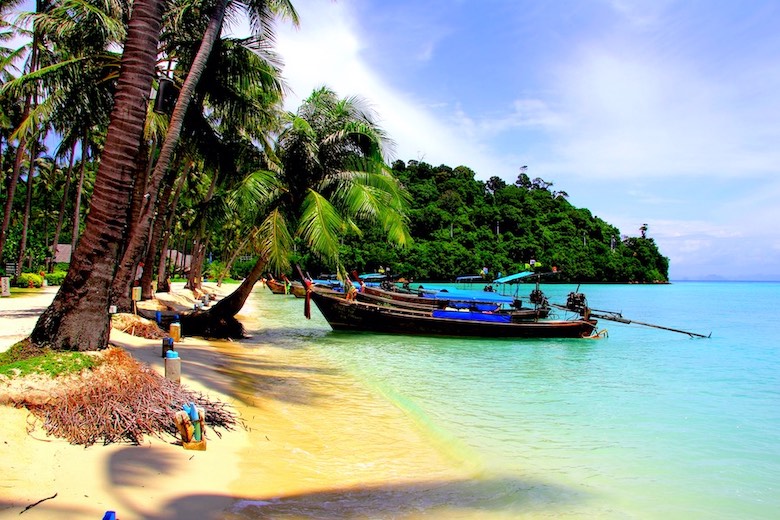
Tips on how to easily get around Thailand on the cheap using public transportation. The best way for travelling around Thailand and discovering hidden gems.
Travelling to a new destination is exciting. Experiencing new cultures, indulging in local cuisine and exploring foreign places, are some of the experiences we most look forward to when we travel.
But sometimes it can be tempting to stay within the boundaries of our resort, village, city or island simply because we don’t know how to use public transport systems abroad.
Let’s change that, starting with Thailand.
This guide will cover how to use public transportation in Thailand (trains, bus and ferries) to easily and affordably explore this beautiful South East Asian gem.
The Fastest Transportation to Get Around Thailand
Flying is generally the fastest way to get anywhere in Thailand but it comes at a premium. Travelling by road, rail or sea is usually a cheaper alternative to flying.
Although flights in Thailand (and generally in South East Asia) are cheaper than in Europe and other parts of the world. You can save even more money, if you consider taking one of these alternative modes of transport.
Not only are buses, trains and ferries generally cheaper, they’ll also the best transportation to take to discover off the beaten path destinations in Thailand.

It’s important to bear in mind that not all places in Thailand are accessible by plane. Some unique and remote places like Khao Sok National Park are only accessible by trains, buses and ferries so it’s a good idea to consider other public transportation options if you’d like to visit less touristy places in Thailand.
If your only option is flying, then make sure to read our Travel For Cheap Guide . We share how we’re able to save as much as 53% when booking flights, hotels and car rentals.
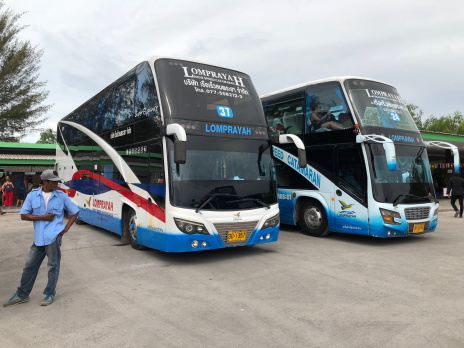
What is the Best Way to Get Around Thailand
The best option depends on where and how far your destination is. Most routes between popular destinations in Thailand have already been defined with regular and direct transportation services available on a daily basis from major towns and cities (Bangkok, Surat Thani, Phuket, etc.).
These routes are usually displayed on timetables at local travel agencies, bus stops and online ( 12Go Asia ). Certain defined routes may include a combination of two or more modes of transportation.
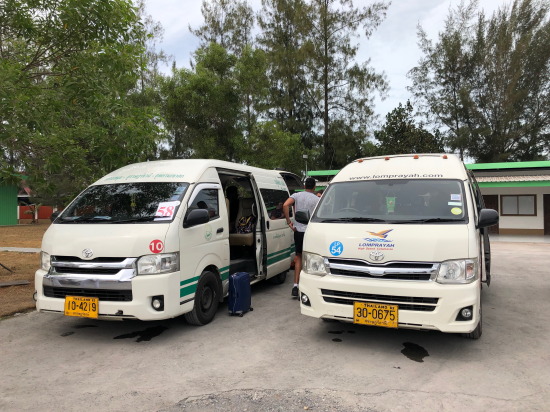
Public Transportation in Thailand
One thing that really confused the hell out of us is the term ‘public’. In Thailand, it is so broadly used that all operators, whether bus, rail or ferry transportation services, are commonly referred to as ‘public’ even though they are operated privately. We’ll explain why and how they work so you can pick the most budget-friendly option to suit your pocket.
Save Me For Later

Buses in Thailand: Private vs Public Operated Buses
The main difference between a privately- and a publicly-operated transportation service in Thailand is simply price, speed and comfort. Often there are a number of privately operated services competing with each other, but departing at different times. So you can easily pick one that suits your schedule.
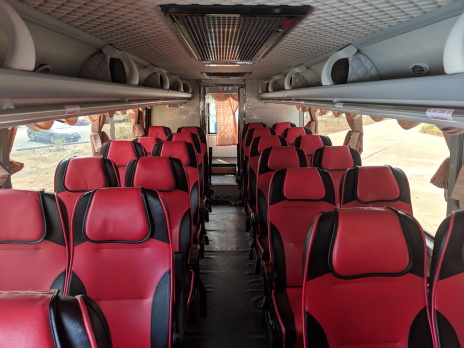
Thailand Bus Transportation with Lomprayah
We used a private operator called Lomprayah to get from Krabi to Koh Phangan because we found that the costs were similar to other privately run operators. Lomprayah cost 100 Baht more (which is less than €3), but it’s absolutely worth it.
The cabin was air-conditioned, the route was direct (non-stop) and the ferry was faster (by at least an hour). The staff also spoke relatively good English, which is great if you don’t speak any Thai.
This it the exact route we took to get from Krabi to Koh Phangan:
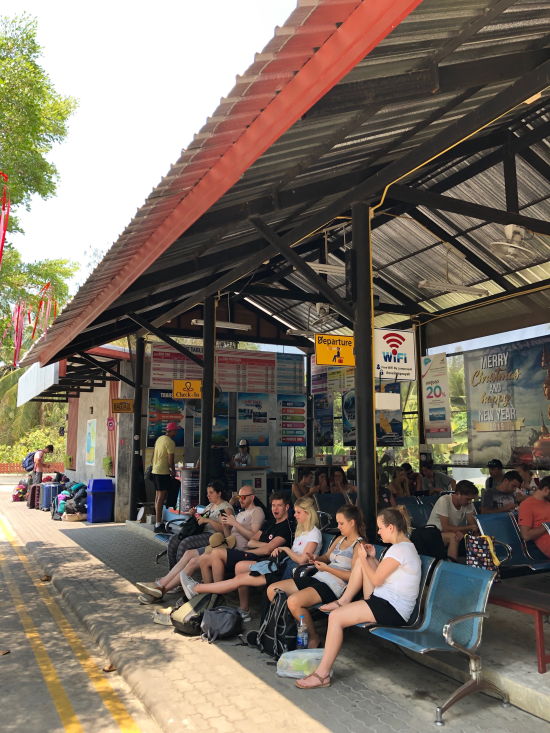
Getting from Krabi to Koh Samui, Koh Phangan and Koh Tao
- A Lomprayah minibus transfer to their main bus station in Krabi (collected us from a meeting point close to our hotel)
- Arrive at Lomprayah main bus station to get stickers for bags and yourself (so you know which bus to get on)
- Get on super comfy, air-conditioned bus for a 3 hour ride to Don Sak port
- At the port, wait for your destination to be called so you get on the right ferry
- Ferry took around 3-5 hours depending on sea conditions. The ferry will first stop at Koh Samui, then Koh Phangan and lastly Koh Tao
Bonus Tip: Try to get on the ferry as soon as possible. Your ticket reserves a spot but does not specify a seat number. If you’re one of the last to arrive on the ferry, you may have to sit in the uncovered sections. This is fine if the weather is great, but if it’s raining… (you get the point).
Thailand Transportation Costs and Budget
Total Cost ( to Koh Phangan ): 700 baht (we opted for the fast ferry which arrived an hour earlier). The slower ferry is 600 baht.
Total Travel Time: 7 hours. Our journey involved bus, minibus and ferry, but it was effortless to say the least.
If your desired route is not available, relax! Don’t despair. You just have to be creative and combine two or more defined routes to reach your destination. It’s easy!
Bonus Tip: Bring water and snacks for the trip. You can buy at the bus or ferry stations, but it will be more expensive compared to 7 Eleven.
Public Bus Transportation in Thailand: The Real Deal
On the other hand, the ‘real’ public bus transportation in Thailand, is not for the faint hearted. Don’t get us wrong. We weren’t born with silver spoons in our mouths but you’ll have to be more open minded and adventurous to use the public bus.
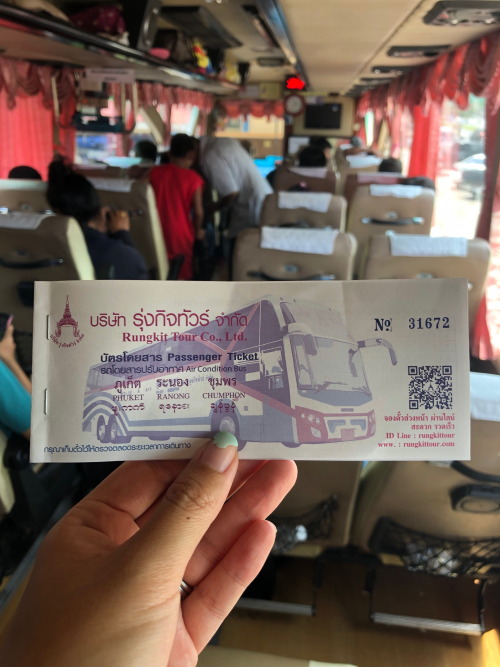
We took the public bus from Khao Sok to Ranong . Then from Ranong to Phuket and paid 80% less (220 and 250 Baht respectively) than taking the private mini-van transport option (1000 Baht per person).
The cabin was air-conditioned but stopped working half way through the journey. The commute took significantly longer because the bus was visually older and stopped every few kilometres at the request of commuters wishing to disembark.
Their staff didn’t speak much English (understandable, since we’re in their country) so we had to rely on a mix of Google Maps, Google Translate and hand gestures to explain where we were getting off.
And the toilet was pretty much out of service. Unless you were willing to hold yourself still (in a moving bus) with one hand. While pinning down your cell phone under your chin (for light), and simultaneously handling your junk with the other hand. TMI?
It wasn’t our finest moment, but we would totally do it again if time is not a factor. After all, why would you pay 5 times the price when you can bake in a bus for 7 hours. We’re not being sarcastic at all. It’s just our inner “thriftiness” coming out.
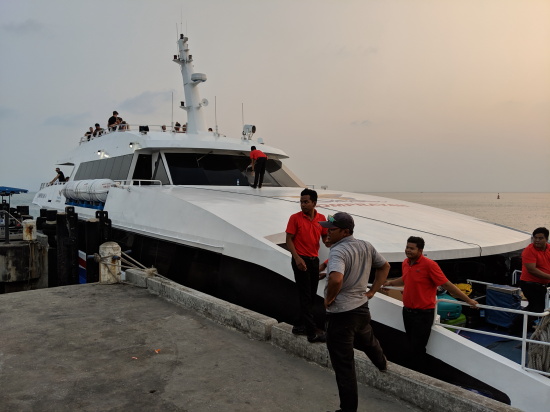
How to Buy Cheap Bus, Train and Ferry Tickets in Thailand
There are only three options for buying transportation tickets in Thailand: street-side agents, online , or directly from the operator. You can buy bus, rail and ferry tickets easily and for cheap using any of these three ways.
Prices are fixed, so either option is just as easy and cheap.
One advantage of buying from a street-side agent though, is that they’ll arrange for you to be picked up from your hotel and taken to the terminal, station or pier for free (if your hotel is within a certain zone) or for a small additional fee. Use this option if you have a lot of luggage and need help with your bags.
Fares are usually displayed on boards or on request, so just shop around first to make sure you’re not paying more than you have to.
Buy Thailand Transportation Tickets Online
The other option is to buy your ticket via an online agent such as 12Go Asia . The advantage of buying tickets online is that you can compare prices to see if you’re getting the best deal. You can also pay with a credit card without being charged an additional 3% to 4% fee, which is the norm in Thailand.
If you prefer to buy your tickets in person, make sure you have cash on you if you don’t want to pay the 3% to 4% credit card fee.
We used our Revolut card on all our travels because we get the best exchange rates. ATM withdrawals are also usually free, but in Thailand the Thai banks do charge a withdrawal fee.
You can read more about it in our Krabi Travel Tips Guide if you want to know which Thai bank has the lowest withdrawal fee.
As we’ve said before, fares from street-side and online agents are usually the same. But don’t take our word for it. Always compare prices to see if you’re getting the best fare. Feel free to use the 12Go Asia search form to compare prices online before buying your tickets.
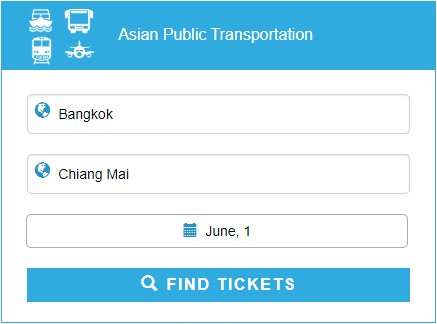
Is Public Transportation Safe in Thailand
We’ve all imagined an overcrowded bus with livestock and baggage tied to its roof. But that’s not the case in Thailand. Having asked locals about getting around in Thailand, many of them recommended we use the public bus, train or ferry.
They themselves rely on it and frankly, if it’s good enough for them, then it’s good enough for us too.
We’ve personally taken the public bus several times and besides it taking a little longer because of the number of stops along the route dropping off and picking up passengers, it’s 100% safe. Some of them are so nice that you can even charge your phone and watch TV (… if you have a VHS tape).
In fact on one occasion, government officials carried out safety inspections on our bus before departure to ensure that it was roadworthy. If that doesn’t give you peace of mind then not even The Avengers can reassure you!
Discover The Top Places To Visit in Thailand
Getting around Thailand is easy and cheap. We’ve done it and so can you. We were pleasantly surprised at how affordable, efficient and extensive the transportation system in Thailand is. It’s probably one of the best in South East Asia.
Learning how to get around in Thailand using public transportation, really gave us the confidence to discover more non-touristy and less crowded places in Thailand.
Some of which, include our recent discovery of the beautiful beaches in Koh Phangan , embarking on our first scuba diving liveaboard experience around Similan and Surin Islands and going on some of the most exhilarating hikes on our 3 day trip in Krabi .
If it’s your first time travelling to Thailand, make sure you read our 7 Krabi travel tips . We may have written it specifically for Krabi, but most of the tips are applicable for travelling anywhere in Thailand.
We’ve shared useful tips like how much to budget daily, whether it is card friendly and even how to rent a scooter in Thailand.
Next time you’re in Thailand, jump on train, bus or ferry and travel like we did, and you too can travel around Thailand for cheap and like a local.
Thank You For Reading
If you enjoyed reading this guide, share it with your friends and family. Have a question or need advice? Contact us via Email, Messenger or WhatsApp. And if you'd like to leave a comment, tweet us . Oh, and don’t forget to subscribe and follow us on social media !
Help the site by leaving a review:
Buy Us A Coffee
Our content is free and always will be. But if this guide has saved you time, money or made your life easier, feel free to buy us a coffee . We’ll really appreciate your support.

Support Our Work
Can't donate? No problem! You can still support us by booking hotels , car rental , and tours with us. Check out our resource page for all offers and discount codes.

📣 This guide contains affiliate links. This means if you click on our links and buy something, we may earn a commission at no extra cost to you. This allows us to work on the website full time and keep Nomad And In Love alive and thriving.
Related Guides

7 Krabi Travel Tips That Will Save You Time, Stress and Money: Thailand Travel Guide

Best Outdoor Things To Do in Krabi, Thailand: An Epic 3 Day Krabi Itinerary

Khao Sok National Park | The Ultimate Adventure Travel Guide
Your Travel Guide to Thailand
All information & tips to prepare your trip in Thailand
Guide of transport to travel around Thailand
- train Trains
- directions_bus_filled Bus
- flight_takeoff Plane
- directions_boat Boats
- local_taxi Transports Bangkok
- airplane_ticket Flights to Thailand

General information about transportation in Thailand
Twenty towns in Thailand have an airport with at least one connection to Bangkok but not always daily flights. To go to the Thai islands, there are ferry companies or speedboats, sometimes local or longtails boats for short distances. And if you plan to rent vehicles to go on an adventure on les routes du Siam , it's better know a few rules first.
For transport in Bangkok, besides the famous tuk-tuks and multicolored taxis, you have several public types of transport: metros, Skytrain, buses, Chao Phraya Express boats or boats on the khlongs, the small water canals running through the city. The metro network is extending a lot lately.
Public transport in Thailand
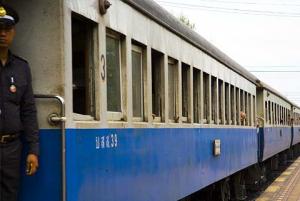
Trains in Thailand
arrow_circle_right More information about trains in Thailand
arrow_circle_right Detailled train search (with all stations)
Search a train in Thailand

Buses in Thailand
arrow_circle_right More information about buses in Thailand
Find Buses in Thailand

Domestic flights in Thailand
arrow_circle_right More about internal flights in Thailand
Search domestic flight in Thailand

Boats and ferry in Thailand
arrow_circle_right More information about boats in Thailand
Find baots (or bus+ferry) in Thailand
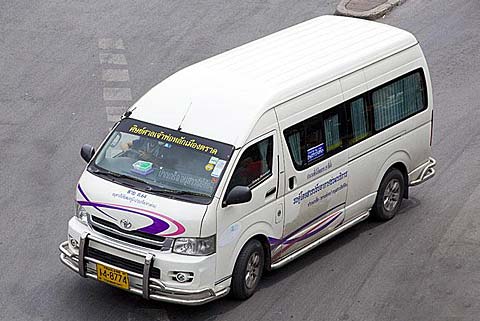
Minivans in Thailand
arrow_circle_right More about minivans in Thailand

Taxis and car with driver apps in Thailand
arrow_circle_right More about taxi and mobility apps in Thailand
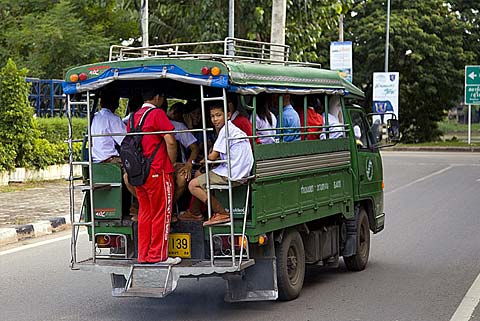
Songthaew in Thailand
Transport in bangkok.

Using public transport in Bangkok
arrow_circle_right More information about transport in Bangkok
BTS, Bangkok skytrain
Mrt, bangkok underground metro, airport rail link, chao phraya express, bangkok bus network, shuttle boats, taximeters in bangkok, pun pun bikes.

Direct buses to Cambodia
arrow_circle_right Book Bangkok-Siem Reap tickets online
arrow_circle_right Book Bangkok-Phnom Penh tickets online
arrow_circle_right Book bus tickets for trips in Cambodia
Individual transportation in Thailand

Taxis in Thailand
arrow_circle_right More information about taxis in Thailand

Tuk-tuks in Thailand
arrow_circle_right More information about tuk tuks in Thailand
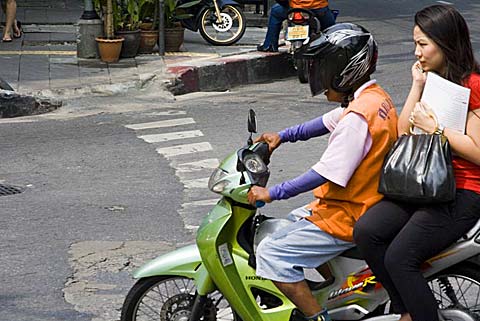
Moto-taxis in Thailand
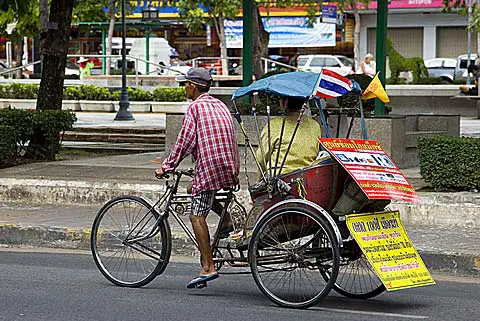
Samlaws in Thailand
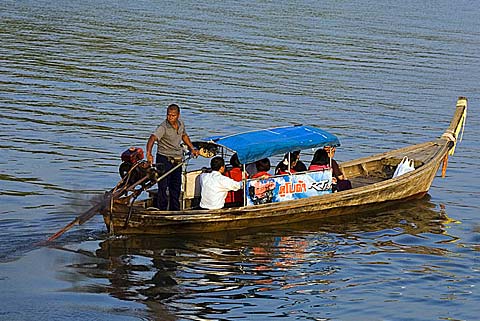
Longtail boats in Thailand
More about transportation in thailand, taking a night train in thailand.

The atmosphere of Thailand night trains is nice and quite cofortable for a cheap price. For the price of a cheap hotel night you have a night sleep and a transport. To be sure to get a sleeper, it's recommended to book your tickets in advance via booking websites like 12Go (or SRT official website).
arrow_circle_right More about night trains in Thailand
Departures from Khao San Road

Khao San Road is known as the backpacker's area in Bangkok. Travel agencies and transportation companies offer bus or ferry + bus packages from Khao San Road to the popular Thai islands like Koh Tao, Koh Samui, Koh Phangan... but also to other destinations in the country.
arrow_circle_right See destinations from Khao San Road
Directs buses from Bangkok to Cambodia

There are direct buses from Bangkok to Phnom Penh or Sieam Reap (the city near Angkor) in Cambodia with border crossing included in the trip. Buses depart from Mo Chit Northern Bangkok BUS Terminal. The number of seats is limited so it is better to book in advance on 12Go .
arrow_circle_right More details about direct buses to Cambodia
Electronic Travel Authorization (ETA) for Visa-Free Visitors
Thailand is gearing up to implement an Electronic Travel Authorization (ETA) system for visitors from visa-free countries, following in the footsteps of international systems like the USA’s Electronic System for Travel Authorization (ESTA), and the proposed European Travel Information and Authorization System (ETIAS), set to come into effect in 2025.
The system will allow authorities to pre-screen visa-exempt travelers before they arrive.
The purpose of this move is to improve the monitoring and screening of foreign nationals entering Thailand, while ensuring the nation’s safety and security.
The system aims to improve border control, identify potential security risks, and facilitate smoother travel into Thailand.
Key Details of Thailand’s ETA
Who will be affected.
The ETA will be applicable to nationals of 93 countries that currently enjoy visa-free entry into Thailand. This includes travelers from Australia, New Zealand, China, Russia, the United States, and the United Kingdom.
The ETA will be compulsory for visa exempt foreign nationals each time prior to entering Thailand by air, land, or sea.
Diplomats are exempt from the ETA. There is currently no exemption for any other group.
Timeline of Implementation
The ETA system is scheduled to begin its pilot phase in December 2024, with full implementation planned for June 2025. However, it is likely that this deadline will be delayed.
The successful launch of such systems typically depends on seamless integration with a variety of third-party platforms, including airlines, travel agencies, and government agencies. This can lead to unforeseen technical or logistical challenges. For instance, Europe's ETIAS (European Travel Information and Authorisation System) faced similar setbacks and has already been postponed once.
How It Works
Applications for the ETA will be made online through Thailand’s official e-Visa platform .
Unlike some countries where similar programs allow for multiple entries over a period of time, Thailand’s ETA will require approval for each individual trip. However, apparently travelers will benefit from expedited entry through automated passport gates once their ETA is approved.
Once approved, applicants will receive an ETA authorization via email, which includes a QR code granting access through electronic immigration gates.
The system will automatically verify passport authenticity, check for any criminal history or disruptive behavior in Thailand, and scan relevant Interpol notices. These checks are identical to those conducted by immigration officers at airports and border crossings, but the ETA process eliminates delays and potential disputes, streamlining entry.
Though complete details regarding the process are still forthcoming, the ETA is expected to be free of charge, offering convenience without additional costs.
Requirements
While the Ministry of Foreign Affairs has yet to release the full details, requirements are likely to include the basics such as proof of accommodation and onward travel.
While the ETA seems like more unnecessary red tape, such schemes are becoming more common, as global security and surveillance is stepped up. Indeed, a similar system is already in place in Malaysia and, to some extent, Cambodia.
Entry Restrictions
It is unknown whether the system will impose limits on the number of 60-day entries allowed in a given year. Until July, Thai immigration restricted visa-free entries to two border trips per year, a rule that has since been lifted. However, the ETA could reintroduce such restrictions, with the system issuing computerized rejections rather than being rejected or told that this is your last entry when you arrive.
Thailand’s Expanding Visa Policies
The launch of the ETA is just one component of Thailand’s evolving visa landscape. The government has been actively updating visa regulations to accommodate a wider range of travelers, including professionals, digital nomads, and freelancers.
One of the most notable changes is the introduction of the five-year “ Destination Thailand Visa” (DTV) . This visa, aimed at remote workers and digital nomads, allows multiple entries over five years with stays of up to 180 days per visit, catering to the needs of the modern workforce.
Extended Visa-Free Stays
In addition to the ETA, Thailand has extended visa-free stays from 30 to 60 days, with the option to apply for a further 30-day extension. The visa exemption and visa-on-arrival lists have also been expanded, simplifying travel for more nationalities.
GET MY NEWSLETTER
Join thousands of others who receive my monthly roundup of content & insider tips on how to survive & thrive in Thailand.
Last Updated on September 16, 2024

Leave a Reply Cancel reply
Your email address will not be published. Required fields are marked *
Notify me when new comments are added.

- Change to white mode
- Change to normal mode
- Change to text yellow mode

3 Airport Bus Connections! Explore Thailand Without a Hitch—Hop on a Bus Right After Landing
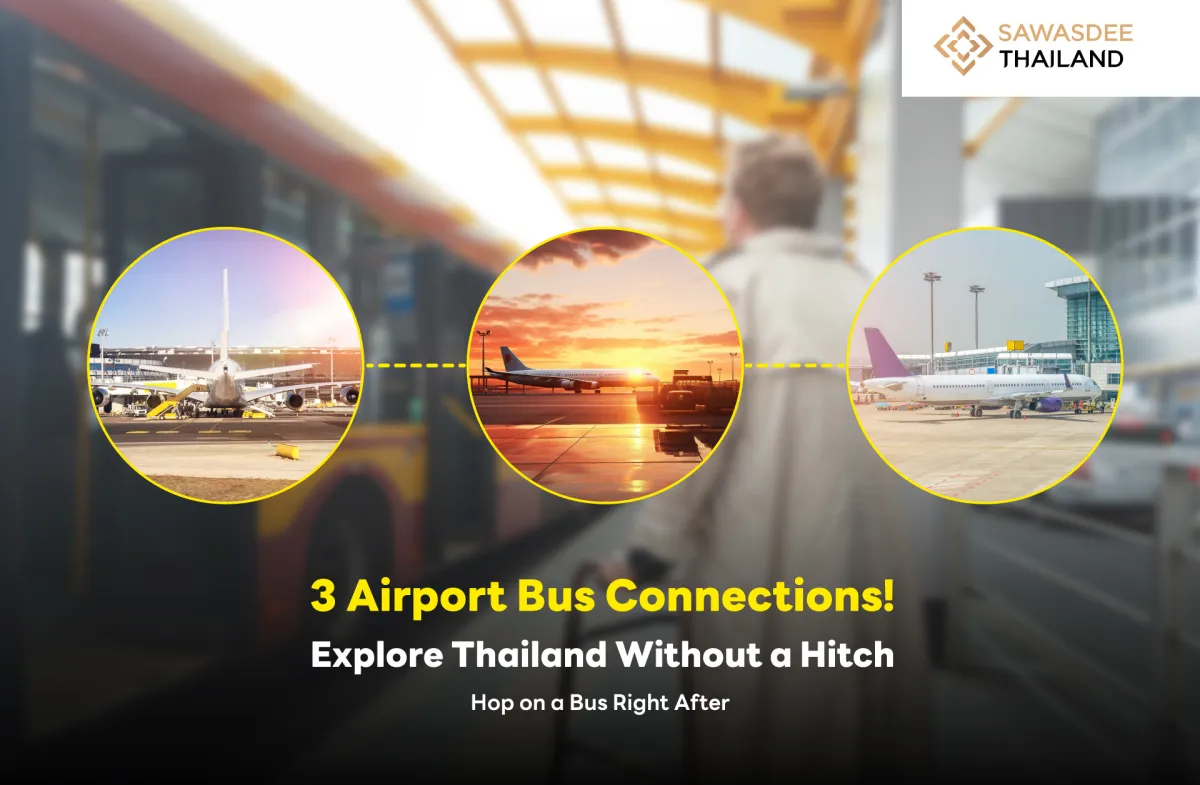
Good news for travelers! The Transport Company Ltd. (BorKorSor) has partnered with the Airports of Thailand (AOT) to open ticket sales points at three airports: Suvarnabhumi, Don Mueang, and Phuket. Get ready to explore Thailand without any delays—step off the plane and hop on a bus immediately for a seamless journey!
The Transport Company Ltd. (BorKorSor) and the Airports of Thailand (AOT) have joined forces to establish bus ticket counters at three major airports in Thailand: Suvarnabhumi, Don Mueang, and Phuket. This initiative ensures your travel is smooth and seamless; no matter which airport you arrive at, you can easily purchase a bus ticket to various provinces, such as Pattaya, Rayong, Nakhon Ratchasima, and Hua Hin. There are also special routes added from Phuket Airport to Khao Lak and Phang Nga to meet the needs of tourists and local residents, reducing travel costs and increasing convenience.
This new service from BorKorSor, set to launch in 2024, not only makes traveling within Thailand easier and more convenient but also helps stimulate the economy and tourism in both major and secondary cities effectively. Get ready to experience seamless travel soon!
More Information : Facebook Anti-Fake News Center Thailand, Ministry of Digital Economy and Society Te l: 0 2141 6747 Link : https://www.facebook.com/AntiFakeNewsCenter
Most Popular
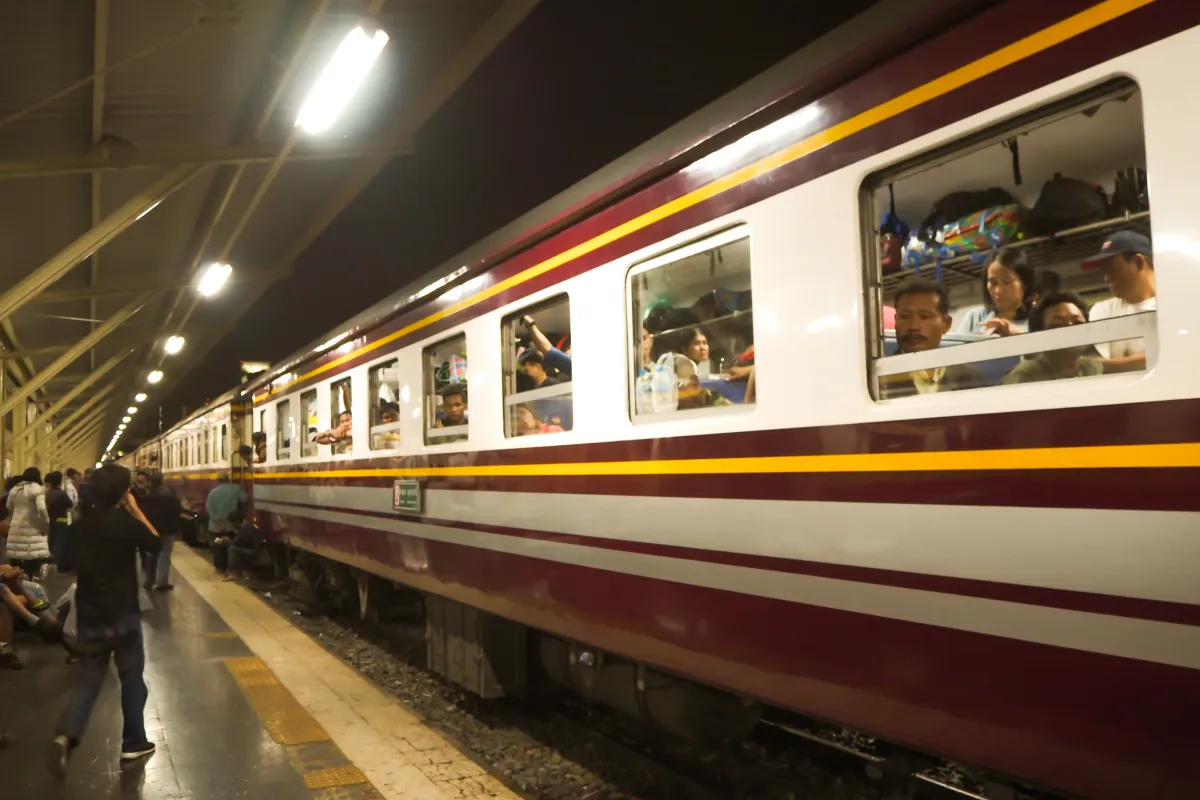
How to buy train tickets online

Bringing Thai or foreign currency into or out of the Kingdom
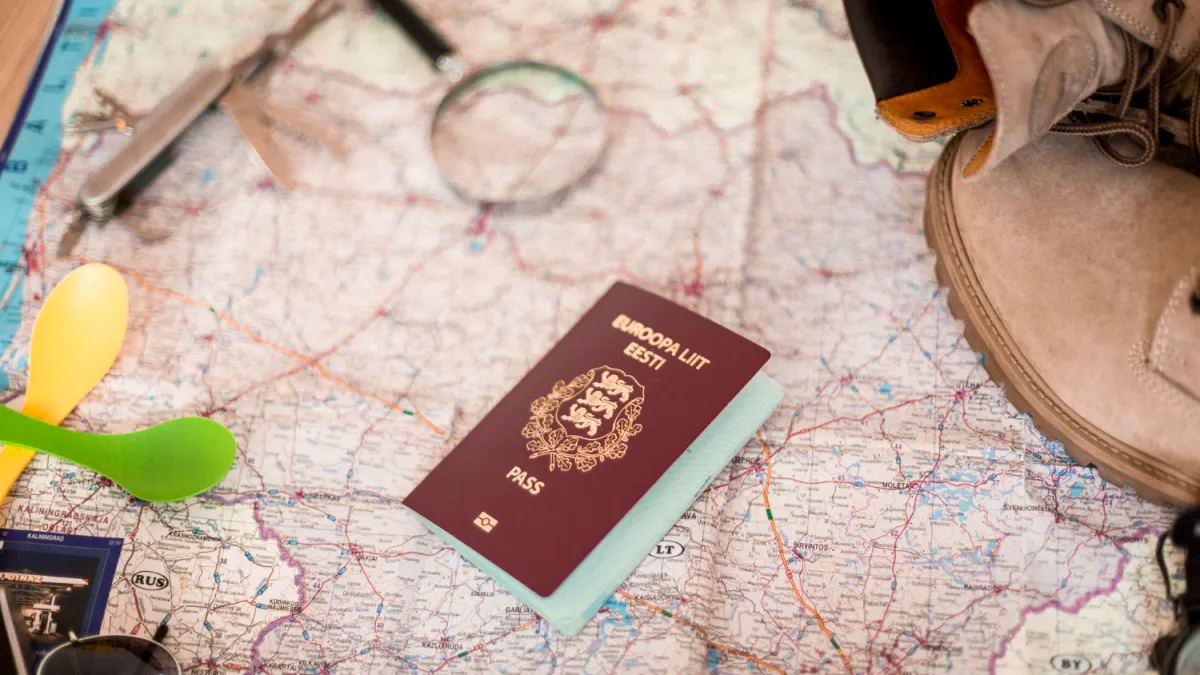
Countries/Territories entitled for visa exemption for a visit of not exceeding 30 days
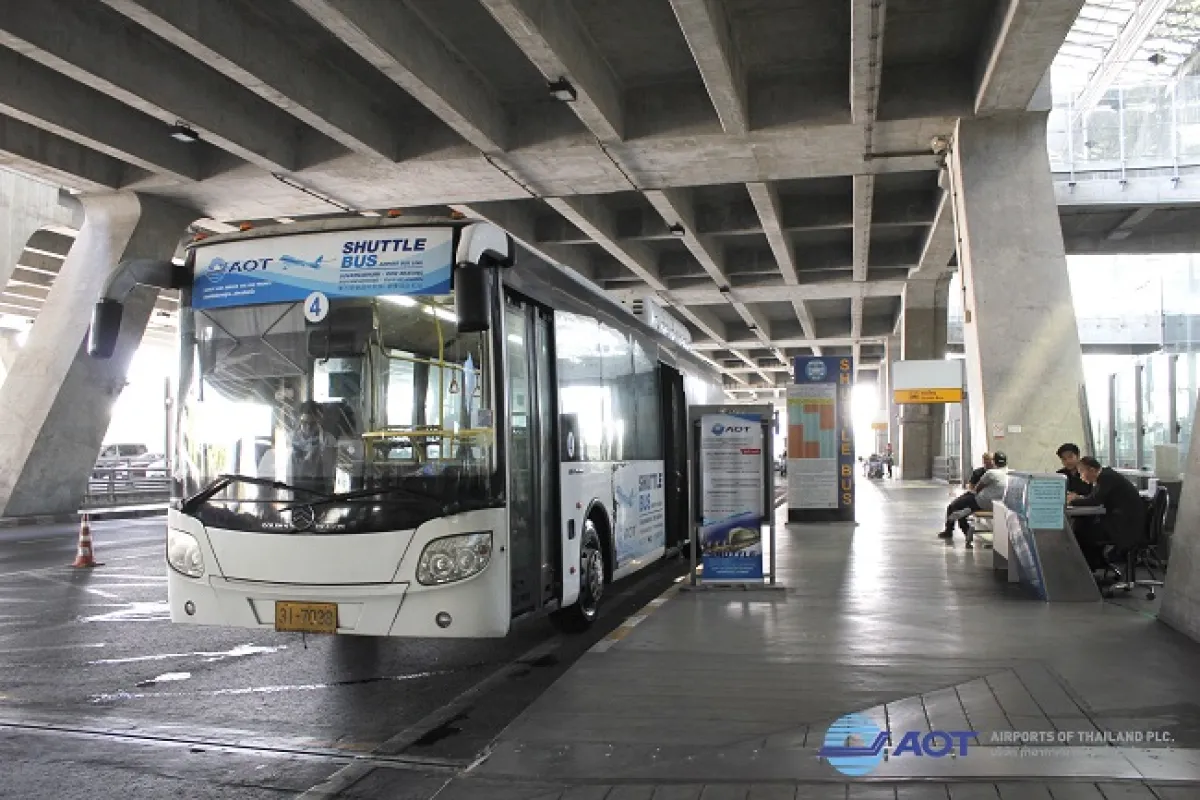
Don Mueang - Suvarnabhumi free airport shuttle bus

Thailand Biggest Fair 2023 (6-14 May)

Travel calendar – Pilates Day Thailand 2023 (6-7 May 2023)

Travel calendar – Beauty and the Beast in concert (20-21 May 2023)

IMAGES
VIDEO
COMMENTS
Well, if you choose to travel in Thailand only by a VIP24 bus, then a bus ticket can cost you as much as an air ticket. But even express class buses in Thailand are relatively comfortable, and a bus from Bangkok to Chiang Mai, or a bus from Bangkok to Phuket , by an express service, can cost you THB 400-450 [about USD12], luggage and a meal ...
044 631 443. 087 608 8792 (mobile) All you need to know to travel by bus in Thailand: bus search, online booking and expert advice.
Bus number 29 goes to both the north and south of the city. From the counters located on the left of the roundabout, bus 29 goes towards the province of Pathum Thani, passing by JJ Market. On the right of the roundabout, bus number 29 heads to China Town. Once you have your direction and bus number, the trip can begin!
In short, traveling by bus in Thailand is a fantastic way to visit this beautiful country. You see a lot more from the bus window than from an airplane, and buses are considerably cheaper than flights. With great flexibility of routes and destinations to travel to, buses are the most practical option for getting around Thailand.
Transportation in Thailand - Ultimate Travel Guide [2024] A detailed and straightforward guide to help travellers understand transportation in Thailand. One of the hardest parts of travelling is often the time spent in transit on the road. When you're in a destination enjoying the land and the culture, everything is exciting and new.
Ferry. From Koh Samui : There are at least 3 ferries a day from Koh Samui's Big Buddha pier to Thongsala pier Seatran Discovery and Haad Rin Queen Ferry directly to Haad Rin. Boats also leaves from Nathon pier (Songserm Express) and Mae Nam pier Lomprayah) to Thongsala 3 times a day. From Koh Tao : get Songserm, Lomprayah or Seatran boats ...
Cream-Blue: These buses are the most basic and cheapest option, usually without air-conditioning. The fares are fixed, regardless of the distance traveled, and are typically around 8 THB. Cream-Red: Similar to the Cream-Blue buses, these are non-air-conditioned buses with a fixed fare, usually around 9 THB.
To Chiang Mai, it's 700 each way. The bus fare from Krung Thep Maha Nakhon (Bangkok) to Nong Bua Daeng in Isaan, a distance of 350 km, is only 300 Thai Baht. These prices are impossible to beat. The price of long-distance travel by bus also includes a meal at the rest stop, snacks, and water. What a deal! 💯.
Ready to uncover Thailand's hidden gems? Join us as we navigate Thailand's diverse transit system! First, we'll explore the efficient bus routes that lead us...
Bangkok-Trat express bus needs at least 8 to 10 hours to travel the distance of just under 400 km. The positive thing about express buses is that you can flag some of these buses down if you happen to find yourself somewhere in the middle of the route. Night express buses are nevertheless a good way to save some baht.
Traveling by bus in Thailand offers a unique experience that allows you to see the landscape and culture up close. While it may take longer than flying, many travelers find the journey rewarding. The scenic views, local interactions, and the chance to experience the country beyond the tourist hotspots make bus travel an appealing option. In this guide, we'll explore the various options ...
Visitors to Thailand more often than not end up on tourist-only buses with tickets sold by travel agencies and reception desks. Going by bus is a cheap, popular way to get from Bangkok to Chiang Mai, however, trains and domestic flights are more comfortable options.
Another option would be to go to the pier yourself and book your ticket there. If you're wondering how to get around Thailand islands, the best way is to rent a scooter or use the transport options as mentioned above. POPULAR TRAVEL ROUTES (Click on destinations to check the price) From Bangkok: Koh Tao. Koh Phangan.
Bus Tickets. Easybook offers Bus, Train, Car, Local Tour and Ferry services to thousands of popular destinations across Thailand, making it the largest online platform of its kind in South East Asia. All transport and tour tickets are available for instant and secure online booking. Our express bus services let you travel a comfortable journey ...
Suvarnabhumi to Pattaya VIP Bus. Bell Travel operates a daily VIP bus service between Suvarnabhumi Airport Terminal to Pattaya. There are six departures a day to Pattaya from 08.00-18.00. You can buy tickets at the counter on the ground floor or reserve in advance on 12Go using the form below. The fare is 320 baht.
A taxi is the quickest way to get into central Bangkok from either airport. Expect to pay at least 350B for the fare, plus the obligatory airport fee of 50B and an additional fee for toll roads. Both airports are also linked to Bangkok's urban train network, and there's a shuttle bus that runs between the two airports.
March 10, 2023 by Nicky. In this article, we will explore the various modes of transport available throughout Thailand and weigh the pros and cons of each. Getting around Thailand. Taxi. Motorcycle Taxi. Grab. Bolt. Tuk Tuk. Songthaew.
Travel Insurance: If you want to travel to Thailand with peace of mind, then get travel insurance with World Nomads. It'll costs less than $10 a day but come with a $300,000 limit on emergency evacuation and repatriation. Car Rental: Renting a car is a great way to explore Thailand, especially when your destination is outside of Bangkok.
BusOnlineTicket.co.th aims to make your journeys even easier by providing a one-stop online booking portal for bus tickets, train (SRT) tickets and ferry tickets in Thailand. With our service, you can book ticket online in Thailand, and even make advance booking online.
By bus. For long distance travel not done via aeroplane, bus transport overshadows ferries and trains. Getting to and from Thailand via bus is possible from or to Laos, Cambodia, Malaysia and Myanmar and bus travel in Thailand proves to be the most affordable means of international travel.
Buses in Thailand: Private vs Public Operated Buses; Thailand Bus Transportation with Lomprayah; Getting from Krabi to Koh Samui, Koh Phangan and Koh Tao ... These routes are usually displayed on timetables at local travel agencies, bus stops and online . Certain defined routes may include a combination of two or more modes of transportation.
The transport network in Thailand is quite dense and can take you almost anywhere in the country at least by bus. The bus is the most popular mean of transport and the most used by Thai people. There are also many minivans companies. The train serves the four cardinal points but not all major cities. For instance, there is no train to popular ...
Bell Travel Service are a premium coach travel company in Thailand, who were established in 1995 and specialise in running routes between Suvarnabhumi airport, Pattaya and Hua Hin. ... On 24/8 I had a 3 seaterVIP bus when I travel fm airport to Pattaya . I felt cheated as the bus given is similar to people who pay 190 baht. Bus VIP 24, Bell ...
Thailand is gearing up to implement an Electronic Travel Authorization (ETA) system for visitors from visa-free countries, following in the footsteps of international systems like the USA's Electronic System for Travel Authorization (ESTA), and the proposed European Travel Information and Authorization System (ETIAS), set to come into effect in 2025.
Get ready to explore Thailand without any delays—step off the plane and hop on a bus immediately for a seamless journey! The Transport Company Ltd. (BorKorSor) and the Airports of Thailand (AOT) have joined forces to establish bus ticket counters at three major airports in Thailand: Suvarnabhumi, Don Mueang, and Phuket.
There are 11 ways to get from Kuala Lumpur to Thailand by train, plane, bus, or car. Select an option below to see step-by-step directions and to compare ticket prices and travel times in Rome2rio's travel planner.
The Grand Prize Winner ("Winner"), upon confirmation of eligibility, will receive a 4-day/3-night "All-Inclusive" vacation package for two (2) adults (for travel a year from the printed prize certificate) to a Sandals Resort or Beaches Resort of Winner's choice (excluding Sandals Royal Plantation, Sandals Barbados, Sandals LaSource ...
Beranda Food & Travel. Konten dari Pengguna. 5 Tips Liburan ke Thailand Murah, dari Transportasi hingga Belanja. Jendela Dunia. ... Bepergian ke Thailand selama low season, yakni antara bulan April hingga Mei dan Juli hingga September, bisa menghemat biaya. Selama bulan-bulan ini, pemesanan penerbangan dan akomodasi cenderung lebih mudah dan ...